Archived Water Damage Blog Posts
My Water Bill is High!
4/8/2024 (Permalink)
Before you assume the economy is at fault check these:
POTENTIAL CAUSES OF HIGH WATER BILLS
An unusually high water bill is most often caused by a leak or change in water use. Some common causes of high water bills include:
- A leaking toilet, or a toilet that continues to run after being flushed, most common
- A dripping faucet; a faucet drip can waster 20 gallons or more of water a day
- Filling or topping off a swimming pool
- Watering the lawn, new grass, or trees; also check for an open hose bib
- Irrigation systems, check automated systems, you may need to reprogram
- Water-cooled air conditioners
- A broken water pipe or obvious leak; check the pipes and water heater in the basement or crawlspace
- Water softener problems - cycles continuously
- Running the water to avoid freezing water pipes during cold weather
- Service line leaks between your water meter and your home, check for wet spots in your yard
Generally, water consumption is higher during the summer due to watering of lawns, pools, and gardening. Typically, an average family of four uses 4000-5000 gallons of water a month. On your bill, you can see your usage each month. If you suspect a water leak, get it fixed now and call SERVPRO® of Fernandina Beach/Jacksonville Northeast for your water damage restoration needs!
5 Tips to Prevent Water Damage During Spring Cleaning
3/25/2024 (Permalink)
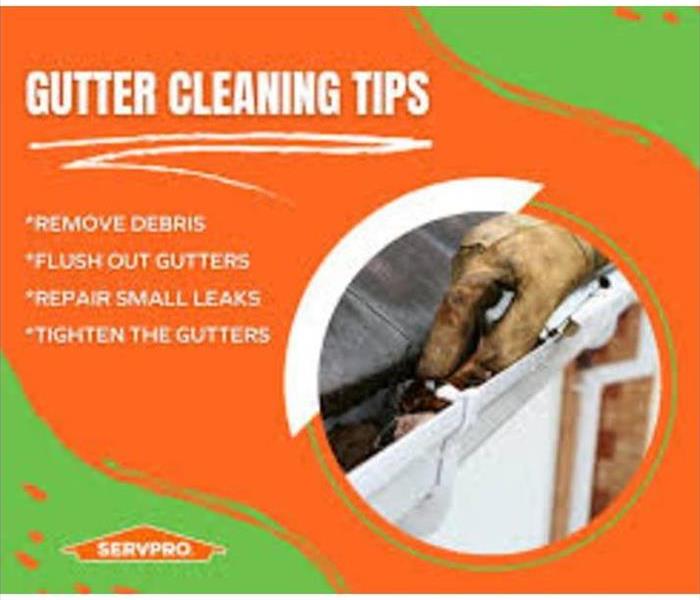 Gutter Cleaning to Prevent Water Damage
Gutter Cleaning to Prevent Water Damage
Tip #1: Inspect Appliances for Leaks
Leaking appliances are a leading cause of water damage in residential settings. Dishwashers, refrigerators, water heaters and washing machines are water damage disasters waiting to happen, so it is essential to regularly inspect these appliances to ensure that they are functioning correctly and have not been damaged.
- Look for signs of small leaks that may usually go unnoticed
- Replace defective, cracked, or torn seals
- Inspect all supply hoses
- Make sure all valve connections are tight
- Look into acquiring a leak detector
- Inspect the dishwasher door gaskets after cleaning
- Consider upgrading to stainless steel cord instead of plastic supply tubing for water supply tubes to the washing machine
Tip #2: Survey the Roof and Attic for Damage and Leaks
Roof leaks are another top cause of water leaks. A leaking roof allows water intrusion to damage the ceiling, attic, and walls, causing wooden building materials to rot and mold growth to occur.
If the home has an attic, look for any signs or smells of water damage or microbial growth.
If you notice anything that needs closer inspection or repair, call a roofer.
Tip #3: Remove Clogs and Blockages From Gutters and Downspouts
Gutters and downspouts help guide water away from the foundation of a house, preventing water from entering the structure or compromising the foundation. When these fixtures become clogged, the water build-up can rot away the wooden exterior near the eaves and create new avenues for water to migrate into the home.
Remove leaves, moss, debris, mildew, mold, or any other obstructions. Never use a pressure washer to clean gutters and downspouts since the high pressure and heat of this cleaning method can cause damage.
Tip #4: Apply Caulk to Any Cracks or Gaps in the Home’s Exterior and Interior
Gaps and cracks are an easy entry for water to intrude into a home. Inspect the house for cracks and thorough attention to the joints and frames of windows. Use the appropriate caulk to seal the area or, for cracks in masonry and concrete, use hydraulic cement.
Tip #5: Ensure the Landscaping Does Not Direct Water Towards the Home
Warmer temperatures make spring and summer a favorite time to plan and work on landscape projects. One landscape project that can prevent water damage involves adjusting the yard so that it directs water away from the home. While most properties have grading that slopes away from the house, some properties are not graded properly, which means that water can pool near the house and compromise the foundation. Solutions that are less intrusive than adjusting the grading include a French drain, an underground drainpipe, or a dry creek.
If you incur a water damage, from any source, SERVPRO® of Fernandina Beach/Jacksonville Northeast is available 24/7 for your water damage restoration needs!
Avoid DIY Disaster
1/24/2024 (Permalink)
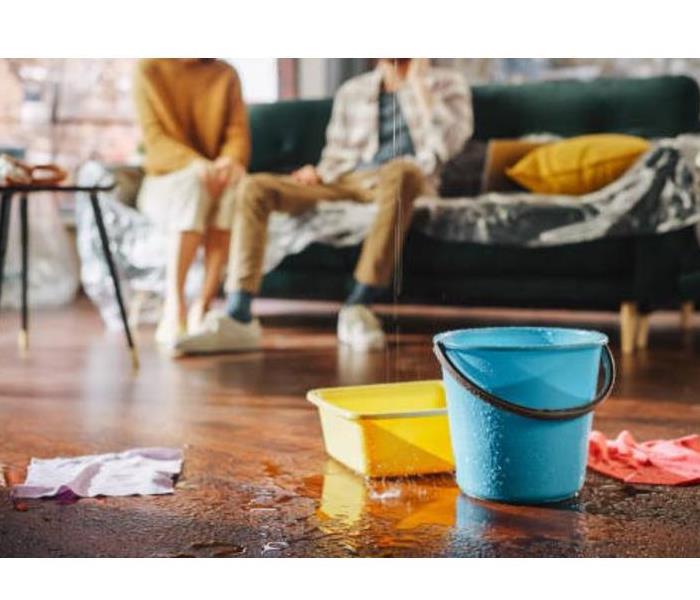 Avoid DIY Water Damage Disasters
Avoid DIY Water Damage Disasters
Water damage can strike at any time, often when you least expect it. Whether it's due to a burst pipe, flooding, or storm damage, knowing what to do in the immediate aftermath can make all the difference. At SERVPRO of Fernandina Beach/Jacksonville Northeast, we want to empower you with essential water damage restoration tips to help protect your property and expedite the recovery process.
Safety First:
Before you jump into restoration, prioritize your safety:
- Ensure that the area is safe to enter, especially after a major flood or storm.
- Turn off the electricity to avoid electrical hazards.
- Wear appropriate safety gear, including gloves and protective clothing, when working with contaminated water.
Assess the Damage:
After safety is assured, take these steps:
Document the Damage: Take photos or videos of the affected areas. This documentation will be crucial for insurance claims.
Stop the Source: If possible, identify and stop the source of the water intrusion. Shut off the main water supply if needed.
Protect Valuables: Remove valuable items, documents, and electronics from the affected area.
Contacting a professional restoration company is crucial. SERVPRO's experts are trained to assess and mitigate water damage effectively. The sooner you reach out, the faster the restoration process can begin.
Begin Drying and Mitigation:
While waiting for SERVPRO's team to arrive, you can take some initial steps to mitigate further damage:
Remove Excess Water: Use mops or towels to remove standing water.
Ventilate the Area: Use fans and open windows to promote air circulation and aid in drying.
Dehumidify: If available, use a dehumidifier to remove excess moisture from the air.
Move Furniture: Elevate furniture on blocks or foil to prevent further damage.
Avoid DIY Restoration:
While it's tempting to handle water damage restoration on your own, it's best left to the professionals. Water damage can lead to mold growth, structural issues, and health hazards if not addressed correctly.
Insurance Claims:
Contact your insurance company as soon as possible and provide the documentation you collected earlier. SERVPRO of Fernandina Beach/Jacksonville Northeast work directly with your insurance company to streamline the claims process.
Prevent Future Water Damage:
Once your property is restored, consider these preventative measures:
Regular Maintenance: Inspect your plumbing, roof, and foundation regularly to catch potential issues before they lead to water damage.
Proper Landscaping: Ensure your yard is properly graded to prevent water from flowing toward your foundation.
Sump Pump: Consider installing a sump pump in your basement or crawlspace to prevent flooding.
Water damage restoration is a daunting process, but with the right steps and the help of professionals like SERVPRO of Fernandina Beach/Jacksonville Northeast, your property can be restored to its former glory. By following these tips and acting swiftly, you can minimize the impact of water damage and protect your investment. If you're faced with water damage, don't hesitate to reach out to us for a prompt and efficient restoration process. Your property's recovery is our priority.
Commercial Water Damage
11/13/2023 (Permalink)
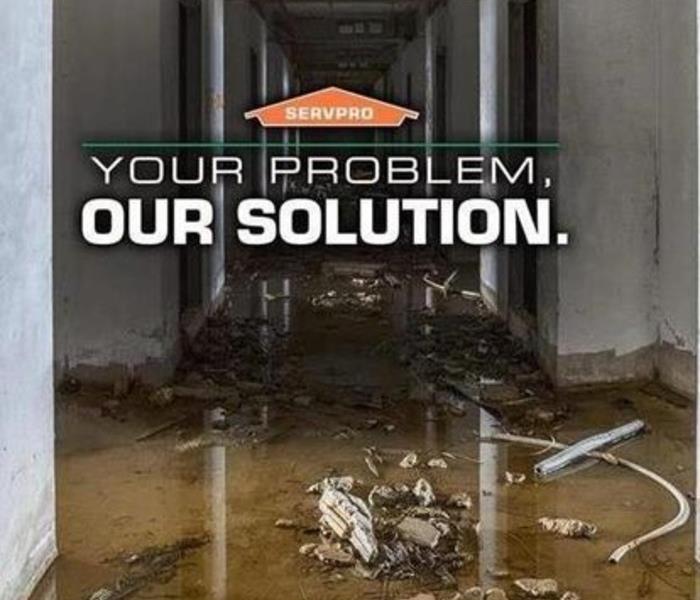 Commercial Water Damage
Commercial Water Damage
When dealing with commercial water damage, bigger is almost always worse. The more water that is flowing through a space, the worse the damage will usually be. Water damage in commercial buildings has the potential to be far more disastrous than a residential home, because of how many more pipes there are in a commercial building. More bathrooms, appliances, and sprinkler systems mean there are a greater number of chances for water loss.
With commercial loss, it also means more equipment will need to be used to dry out the area. More equipment means more manpower needed to move the equipment. This trend can keep compounding out to show how commercial job can have costs add up quickly.
It is also the cost of not doing business that makes a large water loss so damaging. Not being able to have a store/location open for days, weeks, or months at a time can mean a devastating loss of profit which will just make a water loss worse. This is why SERVPRO of Fernandina Beach/Jacksonville Northeast uses every method to expedite the restoration process, such as working directly with insurance providers, offering construction services, and using state of the art equipment to get the restoration process completed fast!
Large commercial water losses can be scary. When you call SERVPRO Fernandina Beach/Jacksonville Northeast, rely on our experience to get the damage under control and back to normal.
How to Efficiently Clean Up Water Damage
11/9/2023 (Permalink)
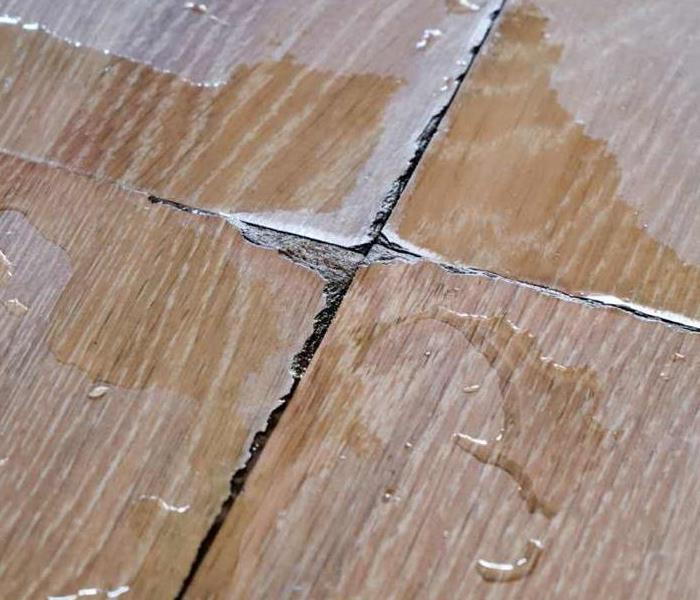 Active Water Damage in home.
Active Water Damage in home.
Water damage can be a frustrating and costly event for homeowners. Whether it is caused by a leaky pipe, a flood or a burst water heater, it is important to address the issue promptly to prevent further damage and growth. In this blog post, we will outline a step-by-step guide to efficiently clean up water damage and restore your home back to its original state.
1. Ensure Safety:
Before starting the cleaning process, it is crucial to ensure your safety. Turn off the power supply to the areas to avoid the risk of electrocution. Additionally, wearing protective gear such as gloves, boots, and masks is essential to protect yourself from contamination.
2. Remove Excess Water:
Using an extraction machine, tool or a water pump, to remove as much excess water as possible from the area. Start by extracting the water from the floor, carpets, and furniture. Make sure all water is extracted before going into any drying processes.
3. Drying Dehumidification:
Once the excess water is removed, the next step is to dry out thoroughly. Set up air movers and use dehumidifiers to promote air circulation and speed up the drying process. Make sure to dry not only the visible surfaces but also hidden areas such as behind walls and under flooring to prevent mold growth.
4. Salvage:
Evaluate the affected items and determine which can be salvaged and which need to be discarded. Porous materials such as carpets, upholstery, and drywall should be removed and replaced if they are heavily soaked or contaminated. Non-porous items can be cleaned and disinfected using a mixture of water and bleach or a commercial disinfectant.
5. Prevent Mold Growth:
After the water damage cleanup, it is crucial to prevent mold growth. Use mold-inhibiting spray apply antimicrobial treatments to the affected surfaces. Monitor the humidity levels in your home and a hygrometer to ensure they remain below 50%. Consider installing a dehumidifier or using moisture absorbers to maintain a dry environment.
6. Professional Restoration:In severe cases of damage, such as extensive flooding or damage to the structure of the house, it is advisable to seek SERVPRO of Fernandina Beach/Jacksonville Northeast. Experienced professionals such as us have the expertise and equipment to handle complex situations and ensure thorough restoration of your home.
Conclusion:Water damage can be a challenging situation to deal with, but following the steps outlined above, you can efficiently clean up the damage and restore your home to pre loss condition. Remember to prioritize safety, remove excess water, thoroughly dry the affected areas, salvage and disinfect items, and take preventive measures to avoid mold growth. If in doubt, do not hesitate to contact SERVPRO of Fernandina Beach/Jacksonville Northeast's professional restoration services to ensure a successful cleanup process.
I Have Water Damage In My Home. Is SERVPRO® near me? Yes
10/25/2023 (Permalink)
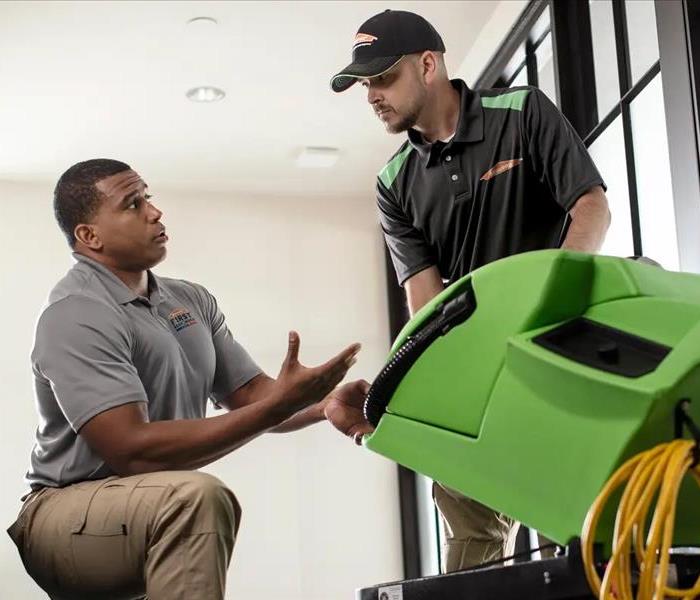 Call SERVPRO- We Service Your Area
Call SERVPRO- We Service Your Area
Does SERVPRO service Fernandina Beach? Yes? Does SERVPRO go to Yulee? Yes! Does SERVPRO service Jacksonville? Of course! And we can also do the reconstruction!
At SERVPRO, we are proud to offer our customers an industry-leading level of service. Each of our over 2180 franchises offers a broad variety of opportunities to help, to serve, and to repair, and restore people’s homes and businesses.
If you water damage or fire damage restoration in Northeast Florida, we are here for you 24 hours a day, every day. We are the water damage restoration experts.
Faster To Your Jacksonville Water Damage Event
7/13/2023 (Permalink)
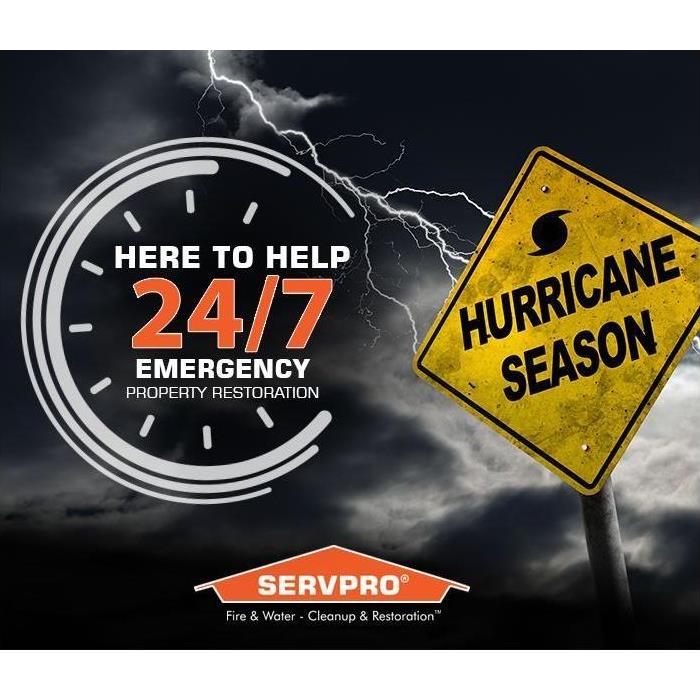 SERVPRO of Fernandina Beach/Jacksonville Northeast provides 24 hour fire and water damage restoration service in Jacksonville.
SERVPRO of Fernandina Beach/Jacksonville Northeast provides 24 hour fire and water damage restoration service in Jacksonville.
Flooding and water emergencies don’t wait for regular business hours and neither do we. SERVPRO of Fernandina Beach/Jacksonville Northeast provides emergency cleaning and restoration services 24 hours a day, 7 days a week—including all holidays.
Faster To Any Size Disaster
Flooding and water damage is very invasive. Water quickly spreads throughout your home and gets absorbed into floors, walls, furniture, and more. SERVPRO of Fernandina Beach/Jacksonville Northeast arrives quickly and starts the water extraction process almost immediately. This immediate response helps to minimize the damage and the cleaning and restoration costs.
Need Emergency Service? Call Us 24/7 904-729-2401
Water Damage Timeline
Within Minutes
• Water quickly spreads throughout your property, saturating everything in its path.
• Water is absorbed into walls, floors, upholstery, and belongings.
• Furniture finishes may bleed, causing permanent staining on carpets.
• Photographs, books, and other paper goods start to swell and warp.
Hours 1 - 24:
• Drywall begins to swell and break down.
• Metal surfaces begin to tarnish.
• Furniture begins to swell and crack.
• Dyes and inks from cloth and paper goods spread and stain.
• A musty odor appears.
48 Hours to 1 Week:
• Mold and mildew may grow and spread.
• Doors, windows, and studs swell and warp.
• Metal begins to rust and corrode.
• Furniture warps and shows signs of mold.
• Paint begins to blister.
• Wood flooring swells and warps.
• Serious biohazard contamination is possible.
More Than 1 Week:
• Restoration time and cost increase dramatically; replacing contaminated materials and structural rebuilding may be extensive.
• Structural safety, mold growth, and biohazard contaminants pose serious risks to occupants.
SERVPRO of Fernandina Beach/Jacksonville Northeast specializes in the cleanup and restoration of residential and commercial property after a fire, smoke or water damage event. Our staff is highly trained in property damage restoration. From initial and ongoing training at SERVPRO’s corporate training facility to regular IICRC-industry certification, rest assured our staff is equipped with the knowledge to restore your property.
Water Damage Cleanup
4/28/2022 (Permalink)
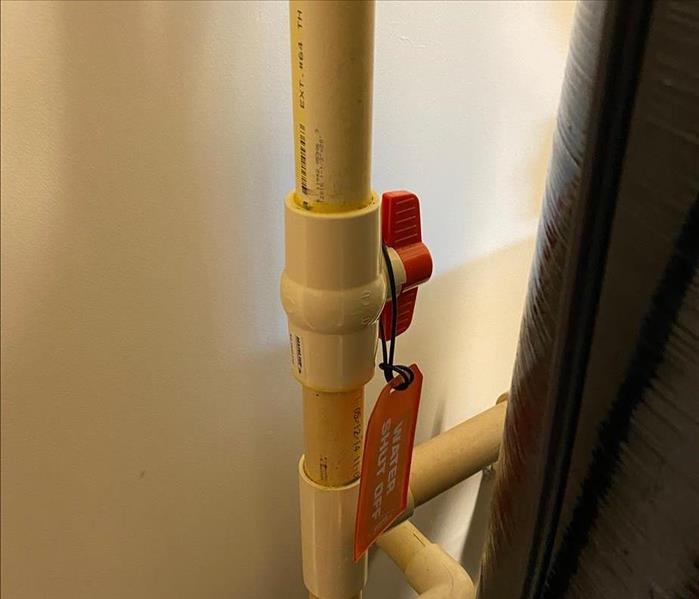 This shut-off valve is located in the garage, which is fairly common.
This shut-off valve is located in the garage, which is fairly common.
Water Damage Cleanup
Walking into your home or business and discovering a water disaster can be overwhelming. Often people are left confused about what to do or what actions to take. Here at SERVPRO of Fernandina Beach/Jacksonville Northeast, our goal is to help not only restore property but also to restore peace of mind. Here are a few actions to take once you discover water damage in your home or business.
Get the air moving
Once the topical water has been removed, you will want to create good airflow through the room. Giving floors and personal items the optimal conditions to dry is key, and good airflow will do just that. Placing fans in the affected room, and ensuring airflow will help to remove the humidity from the room, allowing for better drying conditions.
Turn off the electrical supply
Electricity and water are a dangerous mixture of elements. Especially if there is any flooding, be sure to turn off the electricity to your home before entering the affected area. Find the breaker box to your home, and switch off the main breaker to your home, as well as the specific affected room. This will help to eliminate the danger of electrocution while entering the flooded area.
Quickly shut off the water source
This may seem like an obvious action, but statistics show a drastic decline in the damage incurred based on how quickly the water source is shut off. Instead of trying to first determine where the water is coming from, shut off your water altogether and devise a better plan to discover the source. It is very easy to get caught up in finding the source in the middle of the commotion rather than going directly to the shutoff, which will help the most to eliminate the damage.
We understand how difficult experiencing a disaster in your home or business can be. It is our hopes and effort to not only restore your property, but also your peace of mind. If you have experienced water damage, contact us today at 904.729.2401.
SERVPRO Has The Right Equipment for Handling Water Issues
2/28/2022 (Permalink)
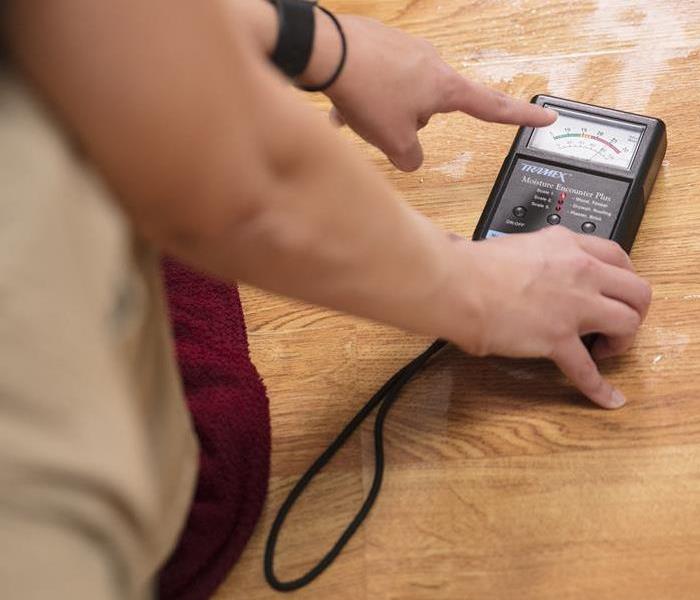 The key to avoiding costly problems is to handle every water damage event as a threat to your property. Shown here is an advanced moisture meter.
The key to avoiding costly problems is to handle every water damage event as a threat to your property. Shown here is an advanced moisture meter.
Even small water damages have the potential to cause serious structural and indoor air quality issues over time. The key to avoiding costly problems in the future is to handle every water damage event as a threat to your property. SERVPRO Fernandina Beach /Jacksonville Northeast has the equipment, training and experience to find and dry unseen water before secondary damages occur. The proper equipment makes a measurable difference in reducing the damage expense during a fire or water loss.
When time matters, technology and equipment must be counted on to perform Locally owned and operated, SERVPRO Fernandina Beach/ Jacksonville Northeast will answer your call with rapid action and provide a full arsenal of drying equipment. Here are a few of the tools we use:
-Moisture Sensors are used to detect moisture in carpets, baseboards and walls.
-Moisture Meters (pictured) are used to determine the actual moisture content of various materials. The moisture tester provides accurate readings, allowing SERVPRO to monitor the drying process.
-Thermohygrometers measure temperature and relative humidity. When armed with this information, SERVPRO can calculate and create an environment most conducive to drying. When facing a contaminated water loss, it is not only important to dry the structure, but the structure must also be disinfected and often deodorized.
-Ultra Low-Volume (ULV) Foggers will atomize liquid deodorizing agents, producing a fine mist that can easily penetrate the site where odor-causing residues may accumulate. This device can also be used to inject fungicides and disinfectants into wall cavities and other hard-to-reach areas.
-Thermal Foggers dispense solvent-based products by creating a dense fog. The fog consists of tiny particles of deodorant solution that attach to and neutralize odor-causing particles.
The bottom line? SERVPRO Fernandina Beach/Jacksonville Northeast has the training and equipment to help make it “Like it never even happened.” Call us at 904.729.2401 if you experience water damage.
Broken Sprinkler System Head Causes Flooding in Jacksonville Warehouse
2/21/2022 (Permalink)
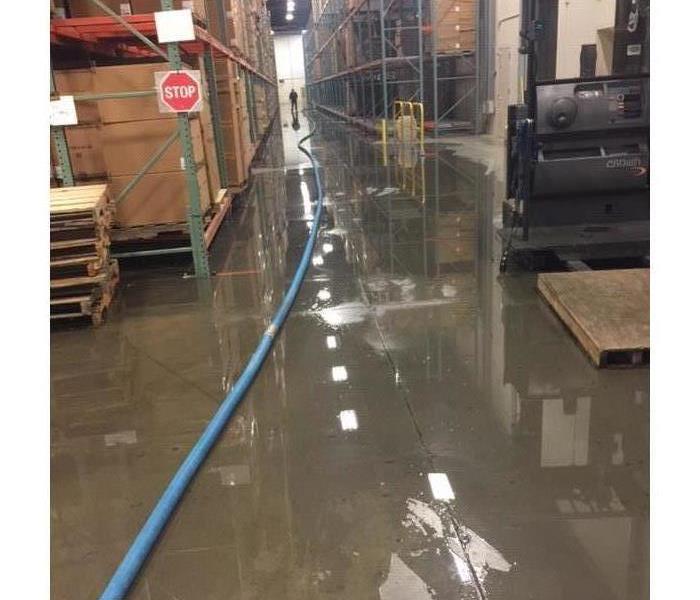 The amount of water that flooded from the sprinkler system was staggering and required special resources.
The amount of water that flooded from the sprinkler system was staggering and required special resources.
Chaos ensued on a Saturday night at a warehouse for designer handbags in Jacksonville when a forklift driver who was placing items on high shelving accidentally knocked a head off the company’s sprinkler/fire suppression system. Water starting pouring down and was quickly jeopardizing a lot of expensive merchandise.
SPRINKLER SYSTEM LEAKS
Malfunctions or leaks in sprinkler systems are a common cause of water damage in commercial buildings. It is not uncommon for older office and retail buildings to have outdated sprinkler systems that work in conjunction with fire protection systems. While such sprinklers are crucial during a fire emergency, they can also cause commercial flood damage if they are faulty or in need of replacement. This could easily damage inventory and business assets. Signs of sprinkler leaks include wet surfaces like drywall and carpets, presence of mold and mildew and standing water.
Taking the necessary measures to prevent water damage can save you from costly repairs and business interruption in the future. Since water damage can come from a variety of sources, it’s essential to have the building inspected regularly to prevent leaks, moisture and related issues. This includes sprinkler systems.
If you have water damage at your place of business, contact the professionals at SERVPRO of Fernandina Beach/Jacksonville Northeast at 904.729.2401.
Preventing Water Damage
2/2/2022 (Permalink)
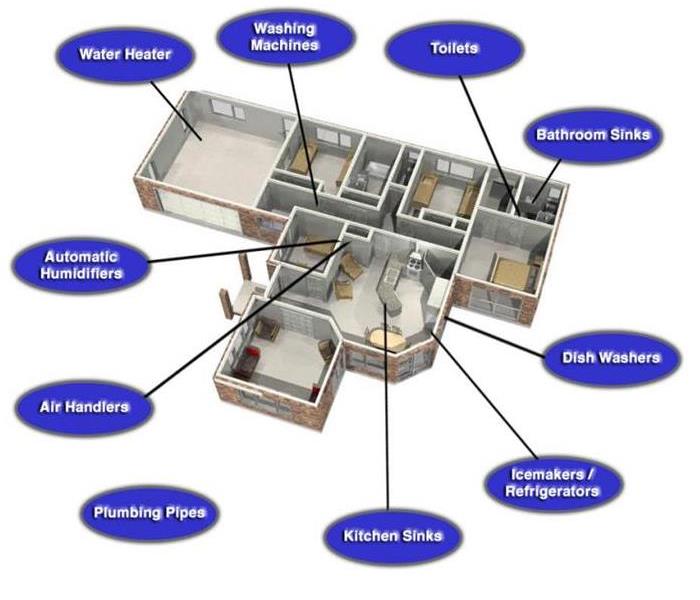 Anyone experiencing or suspecting water damage should contact us for an evaluation of the damage.
Anyone experiencing or suspecting water damage should contact us for an evaluation of the damage.
There are many small and seemingly harmless things that can lead to water damage if left unattended. Slow drips, undetected leaks, standing water around foundations, cracked and chipped grout and caulking can be small leaks that lead to long-term water damage.
Leaking faucets
Repair or replace leaking faucets right away. Not only can a long-term leak raise a water bill, water can build up along the edges of the sink, onto the countertop and drip under the sink. Small leaks over time can cause mold and mildew, which are both health problems and expensive to remove. Sometimes entire areas of the affected structure need to be removed, such as the flooring and cabinetry under a sink.
Leaking toilets
Leaking toilets can contribute to black water contamination, one of the most serious kinds of problems. An old seal or a plumbing problem that causes a toilet to overflow, even a crack in a toilet, needs immediate attention. SERVPRO of Fernandina Beach/Jacksonville Northeast has the training and equipment to address black water damage.
Dampness under sinks
Check under sinks regularly for damp spots. Cracked pipes, loose fittings, rusted fittings and leaks can cause moisture to build up and spread. When the leak is slow and small, standing water may never be present so what would otherwise be an obvious sign of a problem isn’t present.
Grout and caulking around sinks, tubs and showers
Water can seep through cracks in grout and caulking. Missing chunks of grout and caulking, no matter how small, create places for water to pool and seep through into the walls or floor. Repair damaged grout and caulking at once.
Crawl spaces
Water, dampness and mold that are detected in attics, basements and crawl spaces between the ceiling and roof and under a building need immediate attention. Check these areas regularly, especially after rain and storms.
Standing water
Water that puddles and remains unchanged for more than a day when it is not raining needs to be checked. Certain types of soil drain slower than other types, but even then, standing pools of water should change and get smaller within 24 hours. If the puddle is not changing or is getting bigger, check for a broken pipe. Damp ground that is in contact with any structure long enough causes mold and other water damage.
Landscape watering
Small changes to landscaping and how it is watered can help prevent water damage. Avoid planting anything requiring frequent watering close to the house. We all think flowers look wonderful planted right against the house, but if those flowers require a lot of water to keep them alive, consider moving them to another part of the yard or using containers. Use drought-tolerant plants closest to structures. Make sure that landscape water doesn’t hit the exterior walls or run under the house. Plant slopes with drought plants. Leaving a slope bare or planting it with something with heavy water needs causes water runoff that can contribute to damp ground around or under a structure. If you use automatic irrigation, plan it so that drip-watered plants are not too close to the house and consider using well-placed misting heads instead of drip heads.
Anyone experiencing or suspecting water damage can contact us for an evaluation of the damage. SERVPRO of Fernandina Beach/Jacksonville Northeast is the trusted leader in the restoration of water damage. The staff has the training, equipment, and expertise to handle all restoration and cleaning needs and provides 24-hour emergency service. Call us at 904.729.2401.
Water Damage Readiness Tips for the New Year
12/30/2021 (Permalink)
We are closing in on a new year and knowing water damage warning signs in and around your home can help you avoid big repair bills as well as more time and trouble later. Here are some tips to prevent water backups.
- Maintain gutters and downspouts, keeping them free of debris and leaves and repairing them if they are sagging
- Inspect your gutters' capacity - after fifteen minutes of heavy rain, if water overflows the gutters, install additional downspouts
- Extend downspouts at least ten feet away from the house
- Adjust landscaping and irrigation so that water flows away from the foundation
- Drain subsurface groundwater and storm water with a sump pump system that has battery backup and replacement warnings
- Run your sump pump every few months and clean it annually before the rainy season
- Prevent backflow of sanitary sewer water by installing backflow valves and standpipes at all basement drain locations, including sinks and toilets
- Lastly, call us at the first sign of damage; we can save you from a potential larger scale problem.
Keep your home safe and dry with a few simple tips from SERVPRO, whether you are in Fernandina Beach, Yulee or North Jacksonville, these tips will help keep your home and your family safe.
What to Do After Flooding in Your Home
10/27/2021 (Permalink)
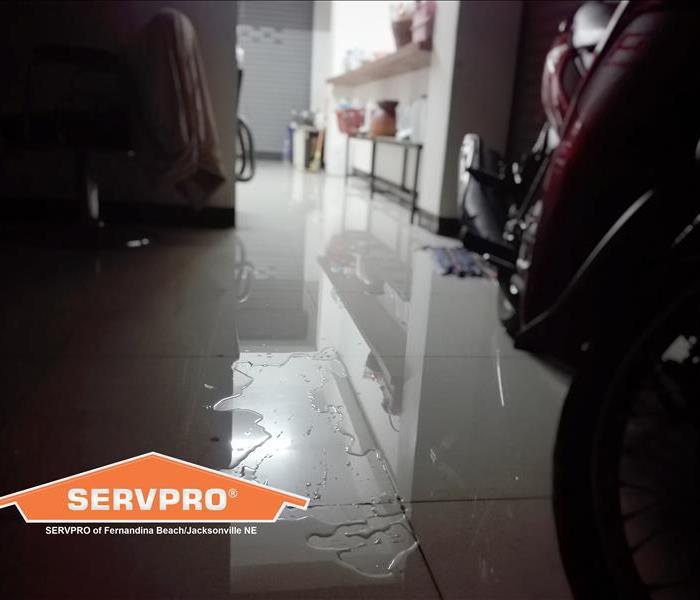 If water have water damage or flooding, call SERVPRO of Fernandina Beach/Jacksonville Northeast at 904.729.2401! We'll get there fast!
If water have water damage or flooding, call SERVPRO of Fernandina Beach/Jacksonville Northeast at 904.729.2401! We'll get there fast!
Walking into your home or business and discovering a water disaster can be overwhelming. Often people are left confused about what to do or what actions to take. Here at SERVPRO of Fernandina Beach/Jacksonville Northeast, our goal is to help not only restore property but also to restore peace of mind. Here are a few actions to take once you discover water damage in your home or business.
Get the air moving
Once the topical water has been removed, you will want to create good airflow through the room. Giving floors and personal items the optimal conditions to dry is key, and good airflow will do just that. Placing fans in the affected room, and ensuring airflow will help to remove the humidity from the room, allowing for better drying conditions.
Turn off the electrical supply
Electricity and water are a dangerous mixture of elements. Especially if there is any flooding, be sure to turn off the electricity to your home before entering the affected area. Find the breaker box to your home, and switch off the main breaker to your home, as well as the specific affected room. This will help to eliminate the danger of electrocution while entering the flooded area.
Quickly shut off the water source
This may seem like an obvious action, but statistics show a drastic decline in the damage incurred based on how quickly the water source is shut off. Instead of trying to first determine where the water is coming from, shut off your water altogether and devise a better plan to discover the source. It is very easy to get caught up in finding the source in the middle of the commotion rather than going directly to the shutoff, which will help the most to eliminate the damage.
Get professional help as soon as possible
The longer that water damage sits, the more damage it can cause. Mold can begin growing, and you may soon need mold remediation as well. Be sure to contact a water damage restoration professional as quickly as possible. If water sits long enough, it can even begin seeping up the walls causing even more extensive damage. One important thing to note is that it's the water you don't see that causes the most damage.
If you have experienced a flood in your home and need water damage restoration, don't wait, contact SERVPRO of Fernandina Beach/Jacksonville Northeast today at 904.729.2401
What is Mitigation and Why Is It So Important?
10/6/2021 (Permalink)
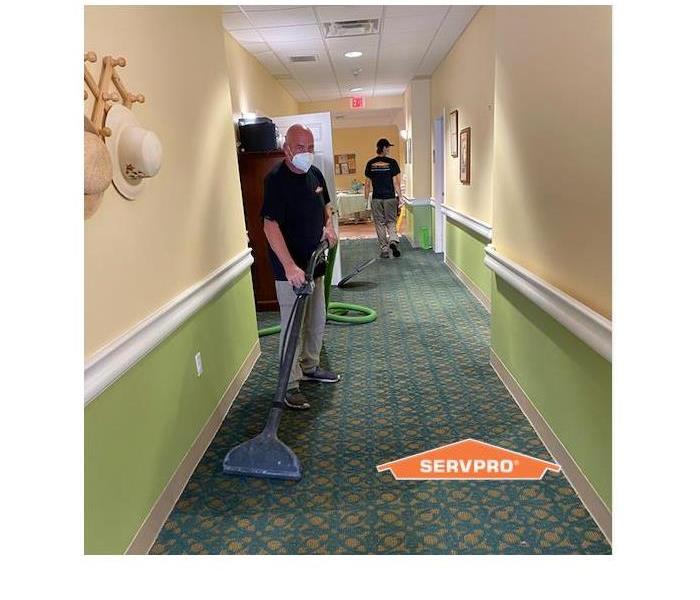 Mitigation lessens the impact of water damage.
Mitigation lessens the impact of water damage.
The definition of mitigation, according to FEMA it is, “the effort to reduce loss of life and property by lessening the impact of disasters.” Specifically, water mitigation is a process that reduces or prevents the amount of damage that can be caused by water after a leak, storm, burst pipe, or flood.
These efforts are most effective when mitigation is performed as soon as possible! Why? When water sits in a damaged area for extended lengths of time, the risk for more damage increases drastically. Sitting water can lead to microbial growth, cracks in foundation, irreversible content damage, carpet/flooring damage, etc.
Unfortunately, water-related disasters can occur at any time. The costs and effects of water damage are unpredictable, which is why it is important to begin the mitigation process in a timely manner.
There are several steps you can take while you wait for our highly-trained crews to arrive;
- Try to close the main water source or shut off any water sources that may be causing the flooding
- Please stay away from any electrical devices. Shut down your electric breaker to prevent any injuries
- If you can safely gain access, take any curtains or draperies away from water or any wet carpet
- If you can safely gain access, remove items that may cause stain to your wet carpet such as, fabrics, books, papers, plants and shoes. DO NOT place newspaper on wet carpet to walk on as ink transfers very easily to wet carpet fibers. Avoid walking on carpet as much as possible
Step 1: Emergency Contact to our office staff will guide you through several important questions that will allow our crews to respond more quickly and efficiently to avoid spreading the affected area
Step 2: SERVPRO arrival , our crews will begin SERVPRO's unique water mitigation process. SERVPRO’s process contains a specialized set of steps to ensure property value is restored to normal
Step 3 : Inspection and Damage Assessment-Once on scene, our crews scrupulously inspect your property’s water damage, which will help them determine the type of water damage and the areas that are affected
Step 4 : Water Extraction-Hundreds of gallons of water are removed using our powerful pumps and vacuums.
Step 5 : Drying and Dehumidification-After the bulk of the water has been removed, our crews use specialized equipment to target any water that is harder to access. Our crews implement a scientific drying method to extract any remaining water and moisture using air movers and dehumidifiers.
Step 6 : Cleaning and Sanitizing-Since water damage also affects belongings, furniture, clothes and many other personal items, our crews will clean restorable items through a process of specialized techniques. Our crews will also sanitize with antimicrobial treatments and remove any odors using air scrubbers and fogging equipment
Step 7 : Restoration-This is our last step to ensuring your home or business returns to its pre-water damage condition. This step can be as minor as replacing some drywall panels or as major as reconstruction.
SERVPRO’s primary job is to keep the damage caused by the water at a minimum and restore the value of the property to make it, “Like it never even happened.”
If you have water damage, call SERVPRO of Fernandina Beach/Jacksonville Northeast at (904) 729-2401 immediately. We’re available 24/7.
Employees Complete IICRC-Approved Water Damage Restoration Technician (WRT) Course
8/25/2021 (Permalink)
 We congratulate Josh and Alyssa for successfully completing the WRT certification and adding to their skill sets!
We congratulate Josh and Alyssa for successfully completing the WRT certification and adding to their skill sets!
In keeping with the company goal of employing only the most highly trained personnel, two SERVPRO of Fernandina Beach/Jacksonville Northeast employees successfully completed the WRT (Water Damage Restoration Training) Course recently. The three-day course was held in Jacksonville and is a prerequisite for other approved courses offered by the Institute of Inspection, Cleaning and Restoration Certification (IICRC).
Josh Hortman and Alyssa Corbitt attended the training courses and passed the exam; The WRT Certification Exam is comprised of 140 multiple choice questions.
The IICRC-approved Water Damage Restoration Technician (WRT) course is designed to teach restoration personnel that perform remediation work to give them a better understanding of water damage, its effects and techniques for drying of structures. This course gives residential and commercial restoration personnel the background to understand the procedures necessary to deal with water losses, sewer backflows, and contamination such as mold.
When coupled with additional on-the-job training and field experience, students will be prepared to perform and document typical residential or light commercial water-damage restoration projects from start to finish. They also should be adequately prepared to accomplish further training in other areas such as ASD (Applied Structural Drying) and (AMRT) Applied Microbial Remediation Technician, which require WRT (Water Damage Restoration Technician) as a prerequisite.
Covered Topics Include:
- General Discussion covers Principles of Drying, Categories and Classes.
- Equipment, Supplies, Chemicals
- Microorganisms, Health and Safety
- Drying Science
- Effect of Water on Materials
- Inspections
- Procedures: Sanitary Water Source
- Procedures: Unsanitary Water
Continuing Education: The IICRC continuing education program seeks to encourage registrants to actively participate in their industry through conventions, workshops and specialized training with continuing education and by sharing knowledge with others in the industry. IICRC-certified cleaning and restoration technicians face many changes in their field and require two credits every four years.
How to Shut Off Your Water in Case of Emergency
8/2/2021 (Permalink)
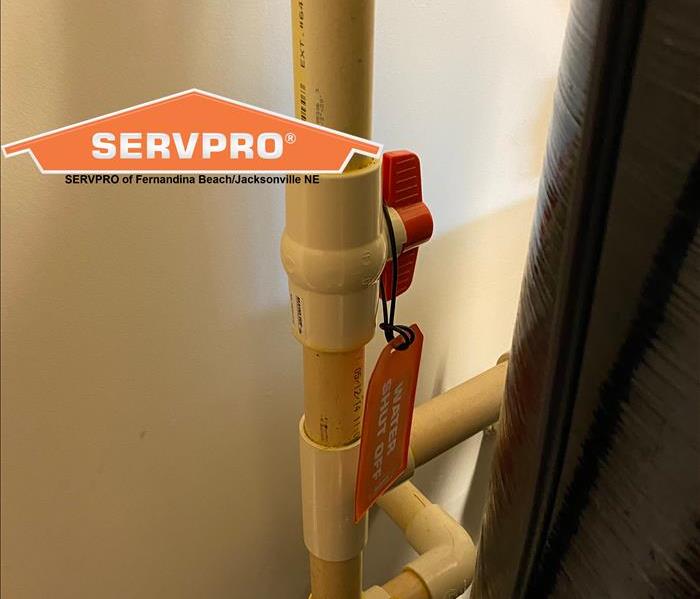 At this home, the water shut-off valve is located inside the garage.
At this home, the water shut-off valve is located inside the garage.
No one expects pipes to burst, water heaters to break, or toilets and washers to overflow. If this happens, your quick response along with the highly trained specialists of SERVPRO of Fernandina Beach/Jacksonville Northeast will limit your damages and potentially save you thousands of dollars! Here are some tips for locating water shut-off valves on your property.
Source: The Spruce…
How to Find the Water Shut-Off Valves
If you have a water emergency, knowing the location of the shut-off valve could save you thousands in water damage repairs. Home water systems contain two types of shut-off valves: main or master shut- off valves for stopping the flow of water to the entire house. These can be tricky and might involve the help of a professional—like a plumber or SERVPRO. An alternative is finding individual or supply shut-off valves for specific appliances and fixtures. Try these first.
Try to Cut Off Water Close to Source
If you have a leak at your toilet, sink, clothes washer, or ice maker, shut off water close to the source:
- Toilet: Look under the toilet, against the wall for the flexible metal tubing. Turn the handle clockwise until it stops. Do not force.
- Sink: Look under the sink cabinet. There will be two sets of flexible metal or plastic tubing. Turn handles clockwise.
- Clothes Washer: Some houses have the valves clearly exposed above and behind the washer. Turn both valves clockwise. If you do not see these valves, slide the washer outward and you will likely see them.
- Dishwashers: The water supply tube running to the dishwasher often has a fixture shut-off valve controlling it. In many cases, this is also located under the kitchen sink base cabinet, and it may be close proximity to the sink faucet shut-off valves.
- Refrigerator ice makers/water dispensers: The small copper or mesh supply tube running to the refrigerator usually has a small saddle valve or other devices that can be shut off to close down the water supply.
Locate Water Main Shut-Off Valve Within the House
This is the best way to shut off water in your house, but locating water shut-off valves indoors can prove to be a tricky task. It will, however, cut off your home's entire water supply, allowing you to open up any pipe within the house.
Hopefully your water shut-off falls can be easily found--either the knob or lever on a border wall. However, if it’s not so easy to locate, Lee Wallender of The Spruce suggests that your valve is likely in one of these following places:
- On a perimeter wall of your house
- At ground level, so you’ll be looking for it lower on the wall if you’re on the ground level floor
- In a straight line from your outdoor water meter
- Noted on your property inspection report from when you purchased the house (most likely in section 6.1)
- Behind an access panel
- NOT under a sink or next to the water heater
If you don’t want to play plumbing detective, or if you need help locating your main water shut-off valves, you can schedule a service call for SERVPRO of Fernandina Beach/Jacksonville Northeast to come out and assist you. Call us at 904-729-2401 if you are interested. It would be money well spent to protect your home investment.
Identifying Improper Drainage at Your Jacksonville Area Home
4/1/2021 (Permalink)
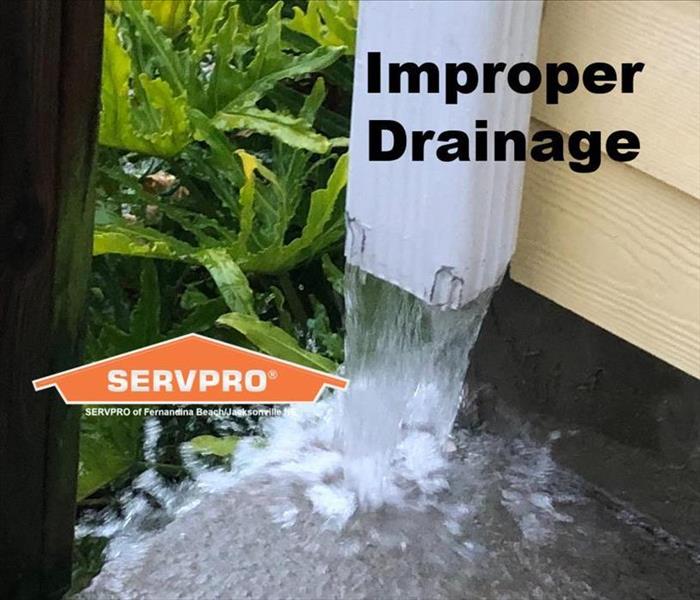 If you experience water damage contact SERVPRO of Fernandina Beach/Jacksonville NE at 904.729.2401. We can help!
If you experience water damage contact SERVPRO of Fernandina Beach/Jacksonville NE at 904.729.2401. We can help!
Spring time is usually a time we in North Florida get a lot of rain, and water damage can often come with it. Water damage for any reason can be one of the most frustrating and costly situations anyone confronts. From the time it takes to fix, to collateral damages it can cause, it’s safe to say that dealing with water damage is a hassle. With some situations like improper drainage, there are telling signs that water damage may be on the horizon. Here’s how you can identify problems with the drainage around your home.
Inconsistent Yard Growth
Grass, bushes, and flowers all require water to grow. When a specific area and type of plant growth exceeds its surrounding area and type, this is a good sign that water may be accumulating due to poor drainage. As this may not be the most urgent red flag, the closer that inconsistent growth is to your home, the stronger of an indicator it is that the flooding can affect your home.
Downspout Water Accumulation
Our gutters and downspouts should lead water away from our home. When they don’t, and heavy rain comes, the rainwater can seep into our foundation and cause water damage to our homes. A telling sign that our downspouts may need adjustment is if there is water accumulating underneath it. Typically, a water spout should transfer water 4 feet away from your home. If water is expelling closer than 4 feet, it may be likely that water damage can happen.
Foundation Water Stains
Sometimes a problem doesn’t readily identify itself. In this case, discovering water stains on our foundation is evidence of areas that are flooding against your home. Proper landscaping should divert water away from your home, and a rule of thumb that The consensus seems to be that a good slope to aim for when grading land extending out from a house foundation is about 6 inches for the first 10 feet (that translates to a "slope" of 5 percent).
If you experience water damage contact SERVPRO of Fernandina Beach/Jacksonville NE at 904.729.2401. We can help!
Water Damage in Jacksonville: The Three Types of Contaminated Water & Restoration Steps
2/24/2021 (Permalink)
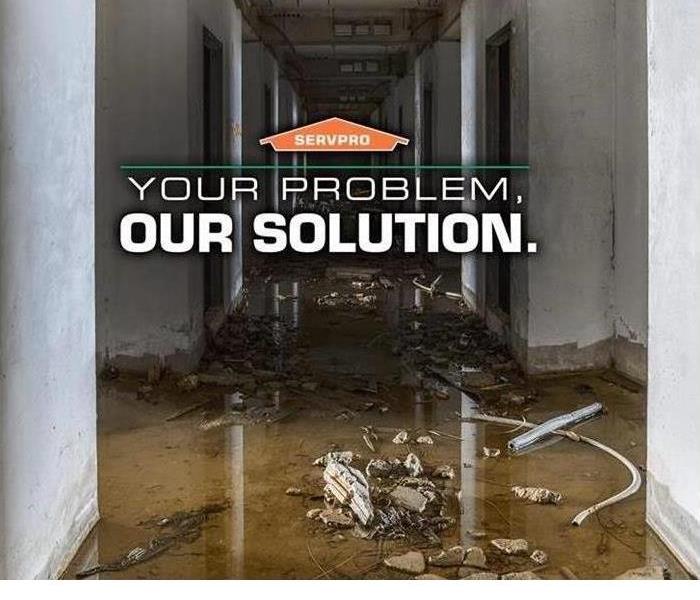 The category of water damage impacts what types of mitigation and restoration are needed.
The category of water damage impacts what types of mitigation and restoration are needed.
When evaluating the types of water damage and how they affect an emergency water removal situation on a property, it helps to know that water losses fall into three categories:
Category 1: Clean Water
Category 1 water is from a clean source like a broken water supply line or leaking faucet. If not treated quickly, this water can turn into category 2 or 3, depending on length of time, temperature, and contact with surrounding contaminants.
Category 2: Gray Water
Category 2 water is contaminated and could cause discomfort or illness. Examples include washing machine overflow; toilet overflow with some urine, but no feces; or dishwasher overflow.
- May contain bacteria and viruses
- Can quickly degrade into category 3 if left untreated
Category 3: Black Water
Category 3 water is grossly contaminated and could cause severe illness or death if ingested and any contact should be avoided. Examples include flooding from rivers or streams, water from beyond the toilet trap, water from the toilet bowl with feces, or standing water that has begun to support microbial growth.
- May contain untreated sewage, harsh chemicals, and microbes
- Water from flooding rivers or sewer backup
Sewage cleanup must not be taken lightly. Serious long term health issues to adults, children and pets may occur due to bacteria, viruses and even parasites.
Restoration Procedures
Evaluation
Water damage restoration is often prefaced by a loss assessment and evaluation of affected materials into the categories described above. The damaged area is inspected with water sensing equipment such as moisture meters and other infrared tools in order to determine the source of the damage and the possible extent of areas affected.
Mitigation, Restoration & Drying
Emergency mitigation services are the first order of business. Controlling the source of water, removal of non-salvageable materials, water extraction and pre-cleaning of impacted materials are all part of the mitigation process. Restoration services would then be rendered to the property in order to dry the structure, stabilize building materials, sanitize any affected or cross-contaminated areas, and deodorize all affected areas and materials. After the labor is completed, water damage equipment including air movers, air scrubbers, dehumidifiers, wood floor drying systems, and sub-floor drying equipment is left in the residence. The goal of the drying process is to stabilize the moisture content of impacted materials below 15%. We at SERVPRO return at regular time intervals, preferably every twenty-four hours, to monitor the equipment, temperature, humidity, and moisture content of the affected walls and contents.
Reconstruction Services
Once dried we can commence to perform any reconstruction or remodeling services desired by the property owner. These services may be limited to replacing drywall, baseboards, and trim boards, or may entail a complete renovation if desired--including floors, cabinetry, appliances, countertops, painting, and a host of related services,
If you have water damage, don't delay. Take immediate action. Call SERVPRO of Fernandina Beach/Jacksonville Northeast at 904.729.2401
North Jacksonville and Nassau County: Freeze WarningTonight!
2/3/2021 (Permalink)
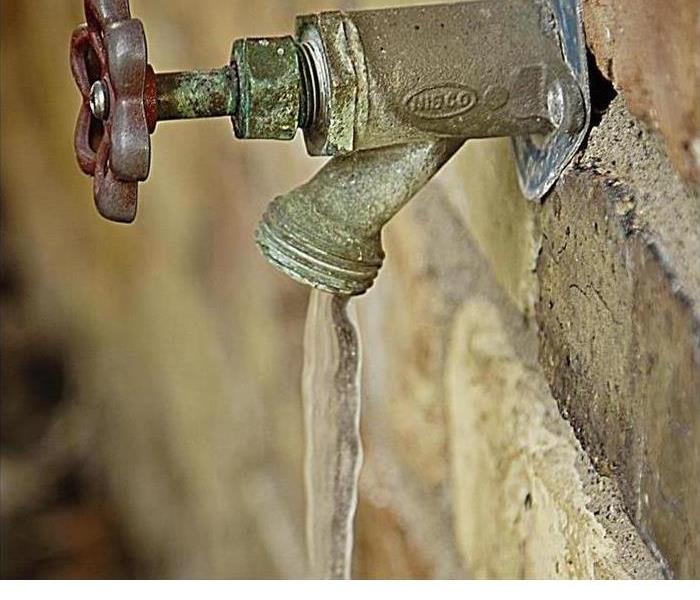 Freeze warnings can lead to frozen pipes and resulting water damages.
Freeze warnings can lead to frozen pipes and resulting water damages.
Watch Out for Freezing Temps Tonight!
Winter weather can catch us off guard in Jacksonville and North Florida. All it takes is a few hours of freezing temperatures for your pipes to freeze.
Here are some helpful hints to help you avoid problems:
- Keep one or two faucets dripping
- Direct warm air to any colder areas of your home
- Leave cabinet doors open to allow warm air in--especially if your kitchen sink is on an outside wall
- Disconnect your hose from the outside faucet
- Seal leaks that allow cold air into your home where pipes are located
Water damage caused by frozen pipes can be one of the most damaging problems a homeowner can face. Most homeowners insurance will cover damage resulting from a frozen pipe provided you can prove that you took measures to prevent the pipe from freezing.
The good news is that SERVPRO of Fernandina Beach/Jacksonville Northeast will be here to help 24/7 if you run into frozen pipes and resulting water damage problems. Call us at 904-729-2401.
When Water Damage Strikes Your Fernandina Beach/North Jax Home
1/27/2021 (Permalink)
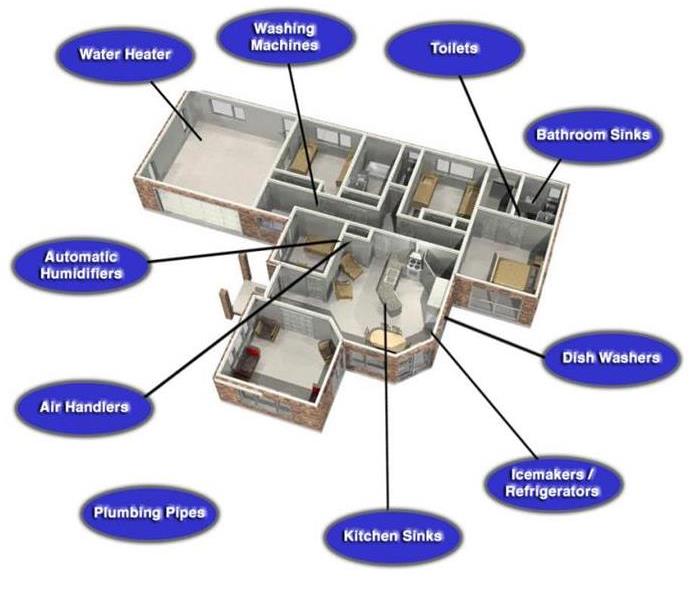 This diagram shows areas of the home where water damage is common.
This diagram shows areas of the home where water damage is common.
The first 24 hours following a water loss are the most important in preventing secondary or permanent damage. Within four hours of receiving a loss notification, a SERVPRO Fernandina Beach/Jacksonville Northeast professional will be on-site to help ensure a water damage is handled by completing the following steps.
INSPECTION
Our professional technicians will inspect affected areas to determine the extent of water damage and will review the inspection with you to answer any questions before beginning the work.
EMERGENCY SERVICES
SERVPRO® technicians will take steps to help protect your home or business, as well as personal property and other contents, from further damage by extracting the excess water and preparing the area for drying. They will explain the needed emergency services to you step- by-step.
MONITORING
To help ensure your home or business and belongings are dried to appropriate industry standards, a SERVPRO® professional will monitor the drying process. The updates will be consistently communicated with you.
RESTORATION SERVICES
SERVPRO® professionals will repair structural materials, reinstall carpets, and clean affected areas of your property and contents. A final walk- through of the jobsite will be conducted with you to help ensure the property was returned to its preloss condition.
The accompanying diagram shows areas of the home most prone to water damage. Please call SERVPRO Fernandina Beach/Jacksonville Northeast at 904.729.2401 if you are affected by water damage or flooding.
Flooding Strikes Three Units in Fernandina Beach Condo
1/7/2021 (Permalink)
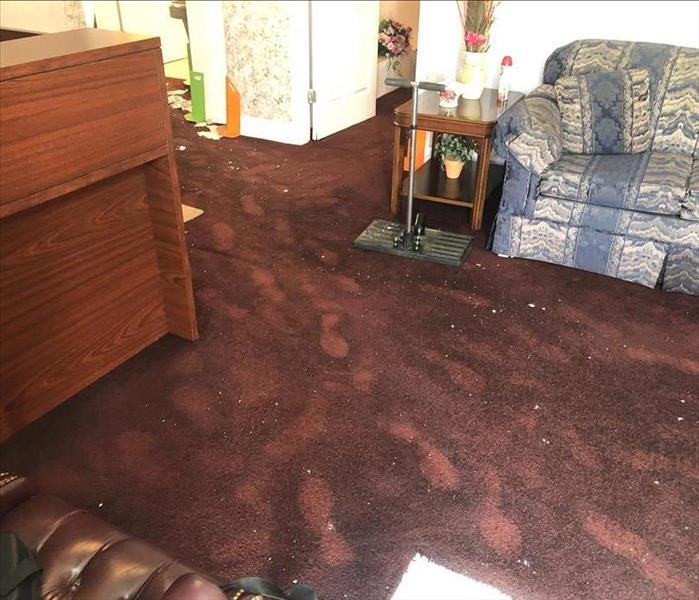 If you have water damage or flooding, call us at 904.729.2401.
If you have water damage or flooding, call us at 904.729.2401.
Flooding from a toilet supply line damaged three units in a Fernandina Beach condo. Fortunately, SERVPRO of Fernandina Beach/Jacksonville Northeast arrived on the scene quickly to extract water and begin the drying process in order to minimize damages.
The first 24 hours following a water loss are the most important in preventing secondary or permanent damage. Here are some steps you can take while waiting for the professionals of SERVPRO of Fernandina Beach/Jacksonville Northeast to arrive.
Emergency Water Damage Tips
- Shut-off the water source, if possible or contact a professional such as SERVPRO, a plumber, or maintenance personnel to stop the water source.
- Turn-off circuit breakers for wet areas of the building when access to the power distribution panel is safe from electrical shock.
- Remove as much excess water as possible by mopping and blotting.
- Place aluminum foil or wood blocks between furniture legs and wet carpeting.
- Move any paintings, art objects, computers, documents, and other sensitive valuables to a dry place.
- Do not use your household vacuum cleaner to remove water! This could cause electrical shock or damage to the device.
For more information on recovering from water damage, contact SERVPRO Fernandina Beach/Jacksonville Northeast at 904.729.2401.
Amelia Island Townhouse Floods Due to Fire Sprinkler Leak
10/28/2020 (Permalink)
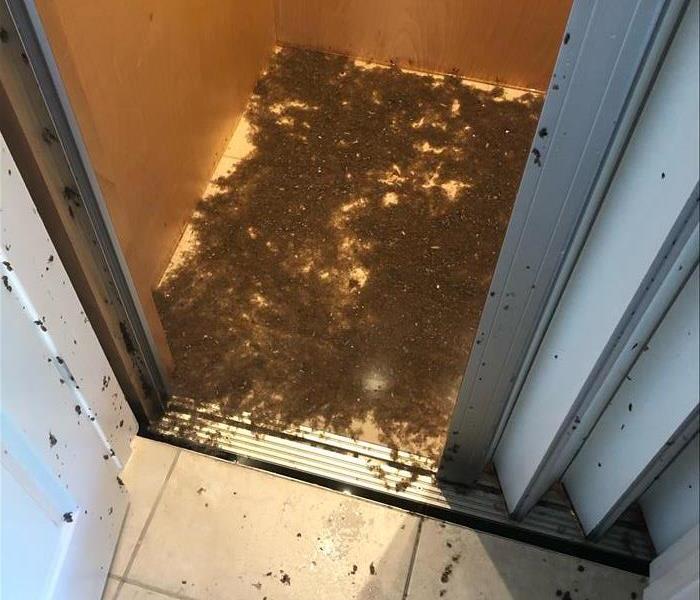 Water damage can come from a variety of sources. Here, a fire sprinkler leak was the cause of flooding.
Water damage can come from a variety of sources. Here, a fire sprinkler leak was the cause of flooding.
In this residential job located in an Amelia Island townhouse complex, a contractor doing inspections for termites stepped on the water line for the sprinkler system in the attic. This photo shows the elevator on the first floor. The brown material is blown-in insulation from three stories up. The water flooded the whole floor under the elevator shaft.
Water loss in your Amelia Island home requires a rapid response to avoid further structural destruction and secondary damage. “Rapid” with our well-trained and experienced water restoration crews means we arrive and initiate emergency services within a few hours of your first call. Commitment to swift extraction and drying is critical, permitting us to deliver on our pledge to save time and expense by restoring existing structures.
If you have flooding or water damage at your home, call SERVPRO of Fernandina Beach/Jacksonville Northeast at 904.729.2401. We’ll make it “Like it never even happened.”
Flooding at Commercial Facility at Wildlight in Yulee
10/7/2020 (Permalink)
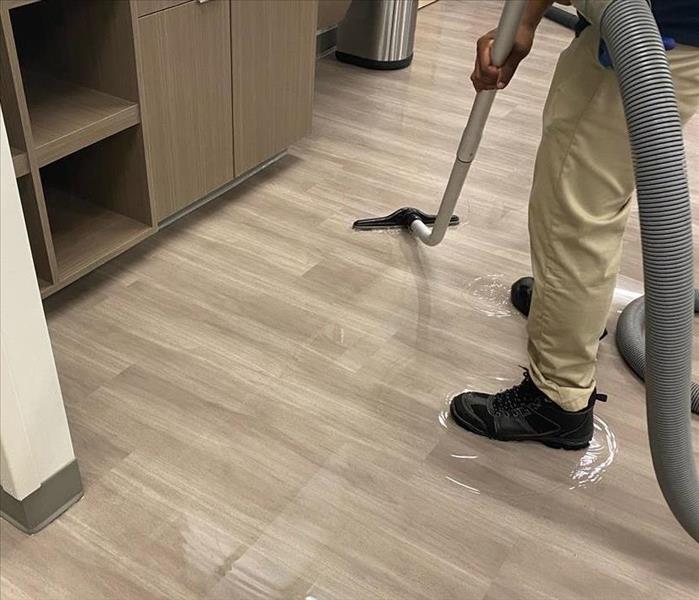 A water cooler leak caused flooding at this commercial facility. Call SERVPRO of Fernandina Beach/Jax NE at 904.729.2401 if you have water damage.
A water cooler leak caused flooding at this commercial facility. Call SERVPRO of Fernandina Beach/Jax NE at 904.729.2401 if you have water damage.
You never know where water damage and flooding may originate. A water cooler leak was the cause of flooding at this commercial facility located at Wildlight in Yulee. Health and fitness facilities are housed in this space, and the SERVPRO of Fernandina Beach/Jacksonville Northeast team arrived on the scene quickly to extract water and dry the facility. Five thousand square feet of the facility were impacted by the flooding. Our customer was very pleased with our quick response and fast turnaround time.
Water coolers are not a common cause of water damage in commercial facilities but such leaking has been known to happen. Pipe breaks are one of the most common causes of water damage at commercial facilities. Broken pipes can result from many reasons, such as changes in pressure or aging, deteriorated water supply lines and sewer drains. Damaged windows, foundation issues, roof leaks, HVAC problems, sewer clogs, and sprinkler system leaks are some of the other common causes of commercial water damage.
Since water damage can originate from a variety of sources, you should have the building inspected regularly to prevent leaks and related issues. Taking the necessary measures to prevent water damage prevent costly repairs and business interruption in the future.
If your business is impacted by water damage or flooding, contact the professionals at SERVPRO of Fernandina Beach/Jacksonville Northeast at 904.729.2401.
Afternoon Thunderstorm Wreaks Havoc on Warehouse Near Jacksonville Airport
9/9/2020 (Permalink)
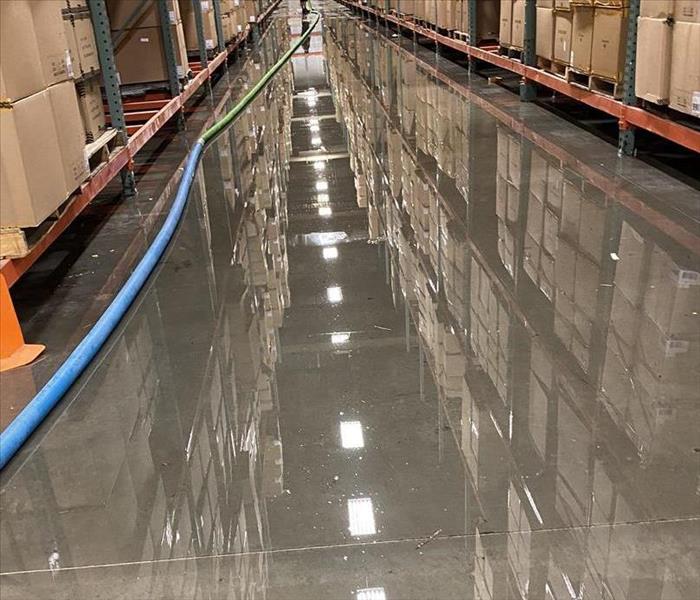 If you or your business have flood damage, call SERVPRO of Fernandina Beach/Jacksonville Northeast at 904.729.2401
If you or your business have flood damage, call SERVPRO of Fernandina Beach/Jacksonville Northeast at 904.729.2401
The afternoon thunderstorms we have been experiencing in the Jacksonville area can cause major water damages. The flooding shown in this photo occurred at a accessories warehouse in Oceanway near the airport.
Flood damage can affect your business operation in a variety of ways and can range in size from being isolated to a single room to entire floors being fully submerged.
Knowing how to prepare and deal with potential flooding in advance can affect how much of your property can be restored and how much has to be replaced. Below are prevention, mitigation and restoration tips to follow until help arrives:
Flood Preparation Tips:
- Determine if your property is in a flood plain.
- In any emergency, always listen to the instructions given by local emergency management officials.
- Carefully assess how your company functions, both internally and externally, to determine which staff, materials, procedures and equipment are absolutely necessary to keep the business operating.
- Plan what you will do if your building, plant or store is not accessible. This type of planning is often referred to as a continuity of operations plan, or COOP, and includes all facets of your business.
- Plan for payroll continuity.
- Review your emergency plans annually. Just as your business changes over time, so do your preparedness needs. When you hire new employees or when there are changes in how your company functions, you should update your plans and inform your people.
- Visit https://www.ready.gov/business/implementation/emergency for a comprehensive plan and to learn about emergency plans.
If you have water damage, call SERVPRO of Fernandina Beach/Jacksonville Northeast at 904.729.2401
Factors to Consider When Choosing a Water Damage Restoration Firm
6/24/2020 (Permalink)
 SERVPRO Fernandina Beach/Jacksonville Northeast is certified by IICRC. Call us at 904.729.2401 if you have water damage.
SERVPRO Fernandina Beach/Jacksonville Northeast is certified by IICRC. Call us at 904.729.2401 if you have water damage.
The following tips are from the Institute of Inspection Cleaning and Restoration Certification (IICRC) web site.
When a storm leaves a home flooded, or a burst pipe causes serious issues in a home, getting water damage restoration services from a respected company should be considered a top priority. Unfortunately, this industry is not regulated, and there are people out there who pose as professionals or overstate their qualifications. Therefore, homeowners should be mindful of who they hire, as an untrained technician may do more harm than good or delay repairs, resulting in a higher degree of destruction. Before selecting a company to handle the job, keep in mind these points:
- Only choose certified professionals to perform water damage restoration services. Even though the industry is not regulated, technicians who have received certification have made the effort to get the best training possible, proving that they take their job seriously. Certification through the Institute of Inspection, Cleaning and Restoration Certification (IICRC) is a sign that a professional has received the most up to date training and is knowledgeable in the latest techniques and technologies employed during repairs. The IICRC operates a Certified Firm registrant-only database on its site, making it easy to find a local, certified professional without trouble.
- Do not select a technician based only on the price or an insurance company’s recommendation. When possible, speak to neighbors or friends who have had to hire a technician recently and try to get a recommendation from them. Insurance companies often select a restoration company based on price, and unusually low pricing suggests the company does not use modern drying or repair methods.
- Choose a company that offers a range of water damage restoration services. The easiest way to determine the expertise of a firm is to see if they provide a full range of options for homeowners. Mold remediation, for example, is often needed given how quickly mold can set in. This is a standard field of knowledge that advanced technicians should possess. If a company doesn’t offer mold remediation, it may not be prepared for all job settings.
- A company that is available 24/7 is a good sign. Stay away from any firms that are reluctant to start right away. In many cases modern equipment can enable near-complete drying in as little as 36 hours, although many situations require longer. Also, a homeowner should not have to wait before repairs begin. Every minute counts when there is standing water present, and reputable professionals understand this. If a technician insists on waiting to begin the remediation portion of the loss, they probably cannot be trusted to see the job through in a reasonable timeframe.
Using these guidelines, you should be able to find a technician that can be trusted and is equipped to do the job the right way. A storm or other disaster is hard enough to deal with, and a remediation firm should do everything in its power to make this difficult process easier.
SERVPRO Fernandina Beach/Jacksonville Northeast is IICRC-certified. Call us at 904-729-2401 if you have water damage!
Preventing Water Damage
5/28/2020 (Permalink)
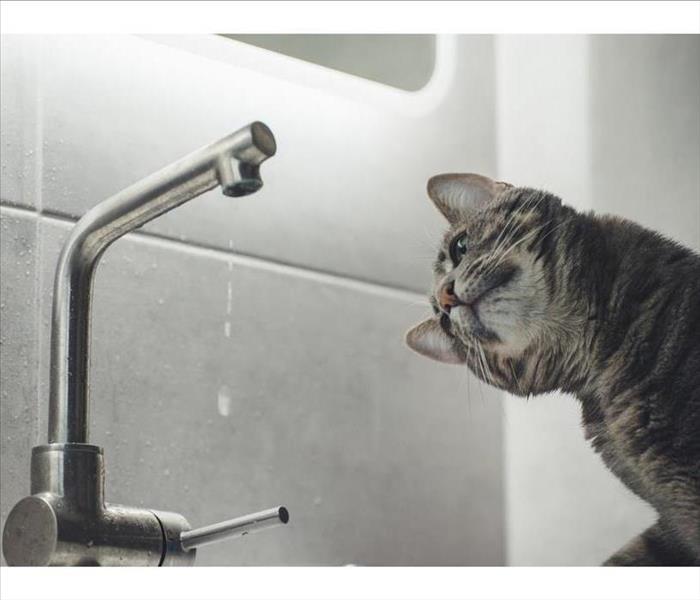 Repair or replace leaking faucets right away to prevent further problems.
Repair or replace leaking faucets right away to prevent further problems.
There are many small and seemingly harmless things that can lead to water damage if left unattended. Slow drips, undetected leaks, standing water around foundations, cracked and chipped grout and caulking can be small leaks that lead to long-term water damage.
Leaking faucets
Repair or replace leaking faucets right away. Not only can a long-term leak raise a water bill, water can build up along the edges of the sink, onto the countertop and drip under the sink. Small leaks over time can cause mold and mildew, which are both health problems and expensive to remove. Sometimes entire areas of the affected structure need to be removed, such as the flooring and cabinetry under a sink.
Leaking toilets
Leaking toilets can contribute to black water contamination, one of the most serious kinds of problems. An old seal or a plumbing problem that causes a toilet to overflow, even a crack in a toilet, needs immediate attention. SERVPRO of Fernandina Beach/Jacksonville Northeast has the training and equipment to address black water damage.
Dampness under sinks
Check under sinks regularly for damp spots. Cracked pipes, loose fittings, rusted fittings and leaks can cause moisture to build up and spread. When the leak is slow and small, standing water may never be present so what would otherwise be an obvious sign of a problem isn’t present.
Grout and caulking around sinks, tubs and showers
Water can seep through cracks in grout and caulking. Missing chunks of grout and caulking, no matter how small, create places for water to pool and seep through into the walls or floor. Repair damaged grout and caulking at once.
Crawl spaces
Water, dampness and mold that are detected in attics, basements and crawl spaces between the ceiling and roof and under a building need immediate attention. Check these areas regularly, especially after rain and storms.
Standing water
Water that puddles and remains unchanged for more than a day when it is not raining needs to be checked. Certain types of soil drain slower than other types, but even then, standing pools of water should change and get smaller within 24 hours. If the puddle is not changing or is getting bigger, check for a broken pipe. Damp ground that is in contact with any structure long enough causes mold and other water damage.
Landscape watering
Small changes to landscaping and how it is watered can help prevent water damage. Avoid planting anything requiring frequent watering close to the house. We all think flowers look wonderful planted right against the house, but if those flowers require a lot of water to keep them alive, consider moving them to another part of the yard or using containers. Use drought-tolerant plants closest to structures. Make sure that landscape water doesn’t hit the exterior walls or run under the house. Plant slopes with drought plants. Leaving a slope bare or planting it with something with heavy water needs causes water runoff that can contribute to damp ground around or under a structure. If you use automatic irrigation, plan it so that drip-watered plants are not too close to the house and consider using well-placed misting heads instead of drip heads.
Anyone experiencing or suspecting water damage can contact us for an evaluation of the damage. SERVPRO of Fernandina Beach/Jacksonville Northeast is the trusted leader in the restoration of water damage. The staff has the training, equipment, and expertise to handle all restoration and cleaning needs and provides 24-hour emergency service. Call us at 904.729.2401.
It’s the Water That You Don’t See
2/20/2020 (Permalink)
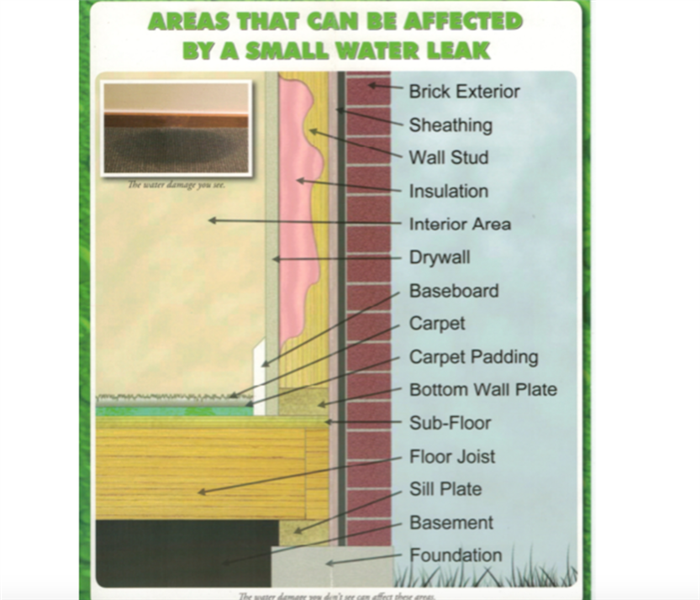 When you have a leak, many areas of your home that you can't see can be affected.
When you have a leak, many areas of your home that you can't see can be affected.
When your home or business experiences a major flood, there’s no chance you won’t see it.
A few inches of water in your basement, an overflowing toilet or a broken sprinkler are tough to overlook and so is the damage they cause.
However, there is a culprit that might not make a big splash, but can cause serious structural and indoor air quality issues: the water you don’t see.
Sometimes you might have hidden leaks or humidity issues that can start small and grow large in their destruction over time. The little leaks might turn into large deluges or wear away at structures, the humidity could make conditions right for mold growth and bad odors.
As a home or business owner, you want to be on the lookout for these sneaky sources of water loss. You also want to make sure that, if you do experience a large flood, to get it cleaned up properly. Improper water cleanup can leave those hidden problems behind.
As the diagram shows, when you have a leak, many areas can be affected. Water can make its way into sheathing, studs, insulation, drywall, baseboards, carpet and padding, wall plate, sub-floor, sill plate, and you basement and foundation.
This is where SERVPRO of Fernandina Beach/Jacksonville Northeast comes in. We have the knowledge and experience clean up water damage of any size and get it done right the first time. We also have the proper equipment to find any moisture lurking out of sight and do away with it.
For example, we have moisture sensors, which are used to detect moisture in carpets, baseboards and walls. We have moisture meters that we use to test the actual moisture content of materials. The meters allow our technicians to accurately monitor the drying process.
And if hidden water leads to bad odors in your business, we have the tools necessary to take care of those as well. Some examples are ultra low-volume foggers and thermal foggers.
The lesson here is to be aware that water losses can be hiding in your home or business and if you find them, you can count on us to fix them.
Call SERVPRO of Fernandina Beach/Jacksonville Northeast at 904.729.2401.
Hidden Water Damage Found in Bathroom of Jacksonville Home
1/22/2020 (Permalink)
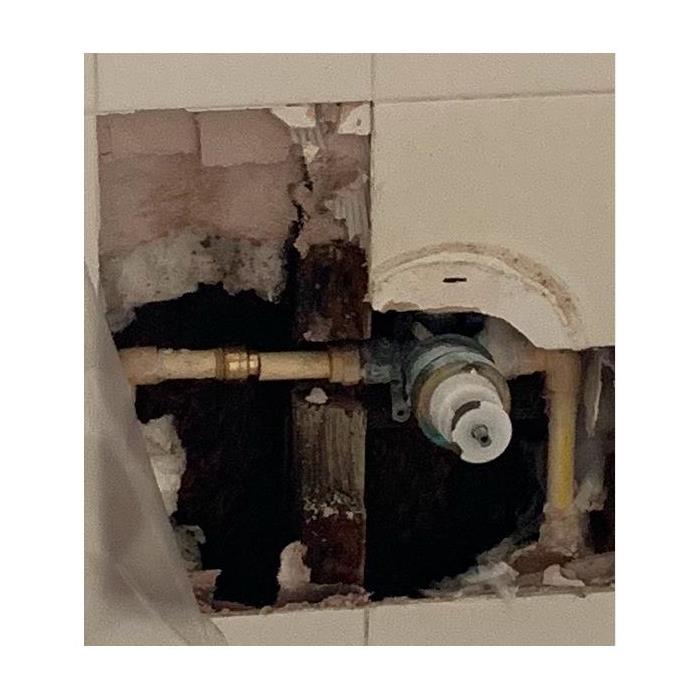 Here, a pipe leaking inside the shower wall caused damage that was not visible to the eye.
Here, a pipe leaking inside the shower wall caused damage that was not visible to the eye.
Sometimes water damage and its source are easy to identify – for example when a pipe bursts or a major storm causes flooding. But sometimes the problem can be more subtle…and that can actually lead to more damage over the long-term if you don’t recognize a problem before it becomes a potential disaster. In this case, a pipe leaking inside the shower wall caused damage that was not visible to the eye. Only our special equipment and eventual demolition showed the extent of the water damage.
If you’re concerned there may be a water problem in your home or business, here are five common but not-so-obvious signs to look out for:
Water Stains
If you see pale yellow or brown stains on your ceilings, wall, or floors, that may indicate the presence of a slow but steady leak. Many times, water stains will form directly under the water source. However, sometimes water will run along wire, pipes or other materials and then drip and cause stains far from the source. Make sure you figure out the cause of the water damage you see.
Mold Growth
Mold grows where there is sufficient wetness for it to thrive, so if you have a mold problem, there’s a water problem. Sometimes materials in your home will become mold infested if they’ve become wet and have never been able to dry sufficiently. This can happen to fabric, wood, insulation, and perhaps even your floors, ceilings, or walls.
Odors
A musty smell can be one of the first signs of a water problem, even if you can’t yet see any leaks. Be on the lookout for any sudden changes in odor. Take note if it gets worse after a rainstorm or while you’re taking a shower or running the dishwasher.
Weak Wall, Floors, or Ceilings
Water will weaken your building materials. You might notice that your walls are becoming more soft or “spongey”, your floors might be bowing, there may be a crack in your ceiling or a bubble in your wall paper. A sudden large leak might cause a major, obvious problem, but if the leak is slow these issues might come on gradually over weeks or months. The sooner you notice, the sooner you can address the root cause.
Higher Utility Bills
If you have a sudden and unexpected surge in your utility bill, that might be an indication of a water problem.While slight fluctuations month to month are normal, be on the lookout for a sudden rise in the water bill, especially if there’s no corresponding increase in your sewer rates. If there isn’t a reason you can think of why your water bill might be high this month, it may be that there’s a water damage issue.
Here at SERVPRO of Fernandina Beach/Jacksonville Northeast, we know just how disastrous water damage can be to a home or business. That’s why we’re passionate about helping the people in this community do what they can to prevent water damage before it becomes a major issue.
But IF you have water damage – even just minor damage – SERVPRO of Fernandina Beach/Jacksonville Northeast can help you identify and address the source of the problem and ensure that it won’t turn into an expensive catastrophe for your home or business. Call us at 904-729-2401 if you suspect that you have water damage.
North Jacksonville/Fernandina Beach: Be Aware of Freezing Temps Tonight
1/21/2020 (Permalink)
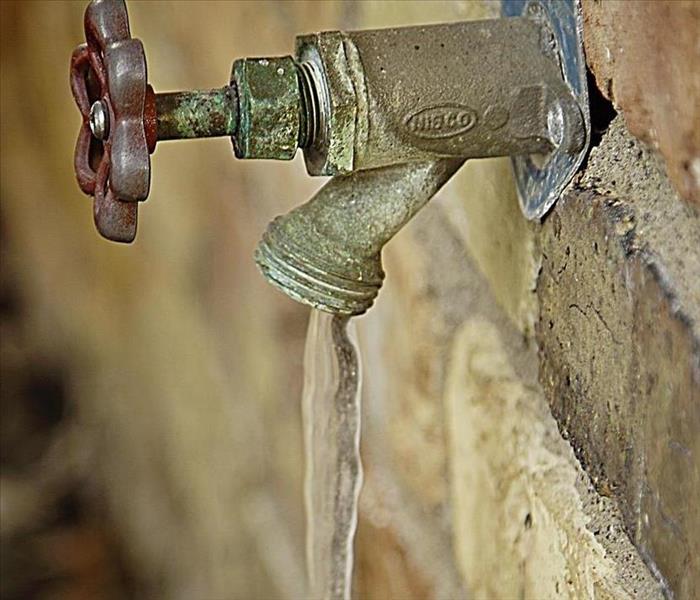 There's a freeze warning in the Jacksonville/Fernandina Beach area tonight. Follow these tips to prevent water damage.
There's a freeze warning in the Jacksonville/Fernandina Beach area tonight. Follow these tips to prevent water damage.
Okay, so it’s probably not likely, but it never hurts to be prepared. With temperatures expected to drop to at or near freezing over the coming week, frozen pipes could be an issue in North Florida.
FREEZE WARNING: Tonight.
Winter weather can catch us off guard in Jacksonville and North Florida. All it takes is a few hours of freezing temperatures for your pipes to freeze.
Here are some helpful hints to help you avoid problems:
- Keep one or two faucets dripping
- Direct warm air to any colder areas of your home
- Leave cabinet doors open to allow warm air in--especially if your kitchen sink is on an outside wall
- Disconnect your hose from the outside faucet
- Seal leaks that allow cold air into your home where pipes are located
Water damage caused by frozen pipes can be one of the most damaging problems a homeowner can face. Most homeowners insurance will cover damage resulting from a frozen pipe provided you can prove that you took measures to prevent the pipe from freezing.
The good news is that SERVPRO of Fernandina Beach/Jacksonville Northeast will be here to help 24/7 if you run into frozen pipes and resulting water damage problems. Call us at 904-729-2401.
Key Factors for Drying Water Damage
1/13/2020 (Permalink)
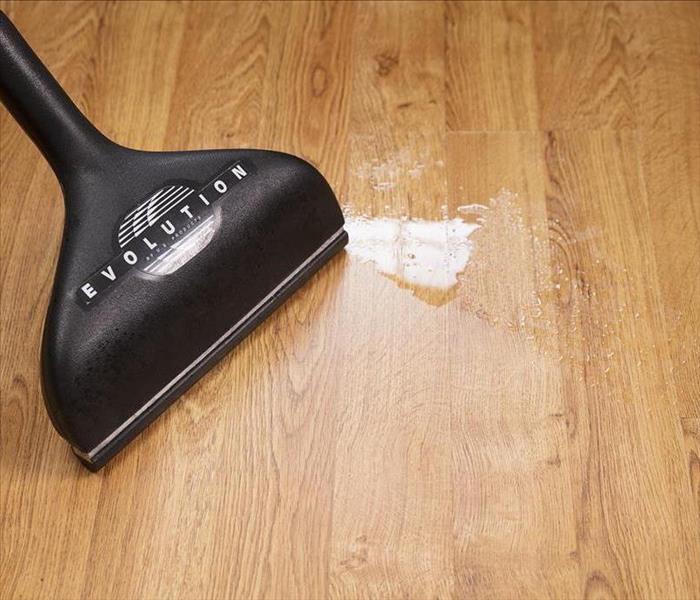 The more water you extract or pump out of the structure, the less you will need to remove with dehumidifiers.
The more water you extract or pump out of the structure, the less you will need to remove with dehumidifiers.
Drying a house or building and its contents quickly is important to minimizing damages. Four factors affect the amount of time required for drying:
- Temperature.
- Amount of water to be evaporated.
- Humidity.
- Air movement.
Remember the rule “wet goes to dry.” The rule means that moisture moves from wet materials to drier materials or wet air to drier air to seek an equilibrium. Dry air absorbs moisture from wet surfaces. Dry surfaces absorb moisture from wet air. Each of the four factors for drying affect the process of wet going to dry.
Temperature
Drying occurs faster when rooms are heated to 70° to 90° since hot air can hold more moisture. If heat is not available, portable heaters may be used. Ideally, temperature in the affected areas of a structure should be between 70° and 80°. Temperatures above 85° on the first drying days could result in too much moisture in the air causing secondary damage if there are not enough dehumidifiers.
Amount of Water to Be Evaporated
The more water you extract or pump out of the structure, the less you will need to remove with dehumidifiers. A liquid is easier and faster to remove than a gas. Physical extraction is 1200 times more efficient than dehumidification. We use a submersible pump if two inches or more of water is standing in the affected area.
Truck mounts can extract 36,000 gal/day. The best dehumidifiers can extract only 30 gal/day. Therefore, physical extraction is important.
Air Movement
Air movement is important to drying. The air in a water-damaged room is normally damp and humid, slowing evaporation. Blowing the damp air out and bringing warm, dry air in will speed drying. Proper positioning of air movers will help. Remember to change the location of air movers as drying occurs to promote even, thorough drying of surfaces.
Learn more about our water restoration process and call SERVPRO Fernandina Beach/Jacksonville Northeast at 904.729.2401 if you have water damage.
10 Tips for Preventing Home Water Damage
11/2/2019 (Permalink)
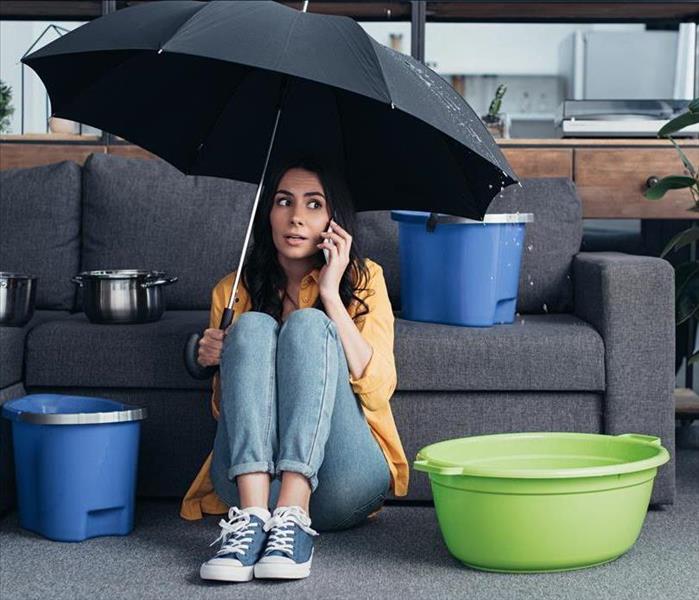 A woman trying to stay dry under an umbrella in a home with a roof leak.
A woman trying to stay dry under an umbrella in a home with a roof leak.
Face it, friends, water is not your home’s friend. Water can wreak havoc on a home and cause catastrophic damage.
Here are a few statistics about water damage:
- The average home water damage insurance claim averages $6,965
- The average age of a failed washing machine supply hose is only 8.7 years
- 75% of water heaters fail before they are 12 years old
- 37% of US homeowners claim to have suffered losses from water damage
Given these statistics, it just makes sense for homeowners to be proactive and do what they can to avoid costly water damage. Read on for some tips that might help you avoid water damage in your Jacksonville area home.
Tip to Prevent Water Damage to Your Home
- Repair any noticeable drips. A little drip can turn into a big problem if ignored.
- Check your roof periodically and repair any loose or damaged shingles. This is especially important after storms.
- If you live in an older home and you are unsure of the material of your plumbing lines, have a plumber do a checkup. Some of the older pipes, especially those made of polybutylene, are likely to burst with age.
- If you notice your sinks and toilets aren’t draining like they used to, get a plumber to come inspect it. The last thing you want is a wastewater backup in your home.
- Keep your rain gutters cleaned out. You don't want water sitting on or near your roof for extended periods of time.
- Be sure your yard slopes away from your foundation. If you notice water pooling around your home foundation, then you need to fix it.
- If you’ve noticed a recent change in your water bill, take note and investigate. You may have a hidden leak that could cause a bigger problem down the road.
- Turn off your water when you are going to be gone overnight. Your home should have a main shutoff that should be easy to access. It’s also important you know where this is in case of an emergency.
- Don’t plant trees too close to your house. Tree roots can damage foundations and septic systems.
- Check your washing machine, dishwasher, and refrigerator hoses annually. If they are worn, replace them. Old, brittle hoses are one of the most frequent causes of water damage for homeowners.
If you do wind up with water in your home, it’s important you contact a water damage company right away to avoid mold growth and protect as much of your home as possible. The technicians at SERVPRO are trained experts. We will work with you and your insurance company to ensure everything gets back to the way it was. Contact us 24-7 and we will get started drying out and repairing your home.
SERVPRO of Fernandina Beach/Jax NE Employees Complete IICRC-Approved Water Damage Restoration Technician (WRT) Course
10/14/2019 (Permalink)
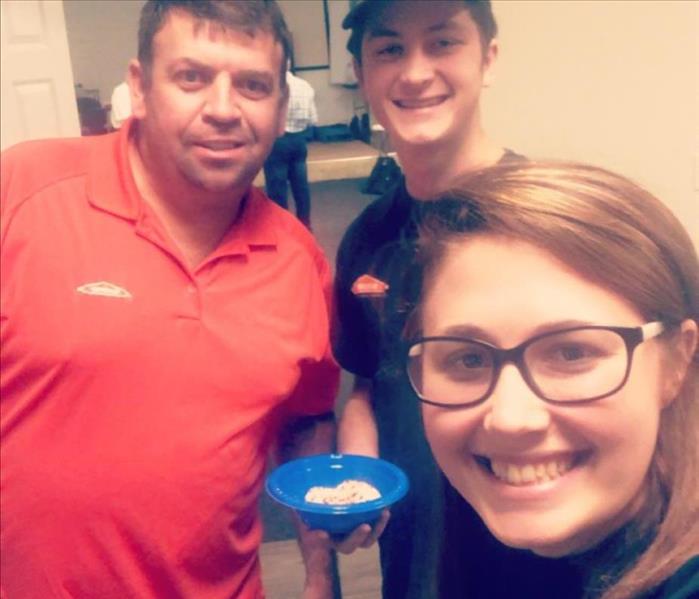 We congratulate Pamela, Jeremy and Michael for successfully completing the WRT course and adding to their skill sets!
We congratulate Pamela, Jeremy and Michael for successfully completing the WRT course and adding to their skill sets!
(October 14, 2019) In keeping with the company goal of having only the most highly trained personnel, three SERVPRO of Fernandina Beach/Jacksonville Northeast employees successfully completed the WRT (Water Damage Restoration Training) Course last week. The three-day course was held in Jacksonville and is a prerequisite for other approved courses offered by the Institute of Inspection, Cleaning and Restoration Certification (IICRC).
Pamela Corbitt, Jeremy Wade, and Michael Rorrer attended the training courses and took the exam; The WRT Certification Exam is comprised of 140 multiple choice questions.
The IICRC-approved Water Damage Restoration Technician (WRT) course is designed to teach restoration personnel that perform remediation work to give them a better understanding of water damage, its effects and techniques for drying of structures. This course will give residential and commercial maintenance personnel the background to understand the procedures necessary to deal with water losses, sewer backflows, and contamination such as mold.
When coupled with additional on-the-job training and field experience, students will be prepared to perform and document typical residential or light commercial water-damage restoration projects from start to finish. They also should be adequately prepared to accomplish further training in other areas such as ASD (Applied Structural Drying) and (AMRT) Applied Microbial Remediation Technician, which require WRT (Water Damage Restoration Technician) as a prerequisite.
Covered Topics Include:
- General Discussion covers Principles of Drying, Categories and Classes.
- Equipment, Supplies, Chemicals
- Microorganisms, Health and Safety
- Drying Science
- Effect of Water on Materials
- Inspections
- Procedures: Sanitary Water Source
- Procedures: Unsanitary Water
Continuing Education: The IICRC continuing education program seeks to encourage registrants to actively participate in their industry through conventions, workshops and specialized training with continuing education and by sharing knowledge with others in the industry.IICRC-certified cleaning and restoration technicians face many changes in their field and require two credits every four years.
What Is Water Damage Restoration?
9/9/2019 (Permalink)
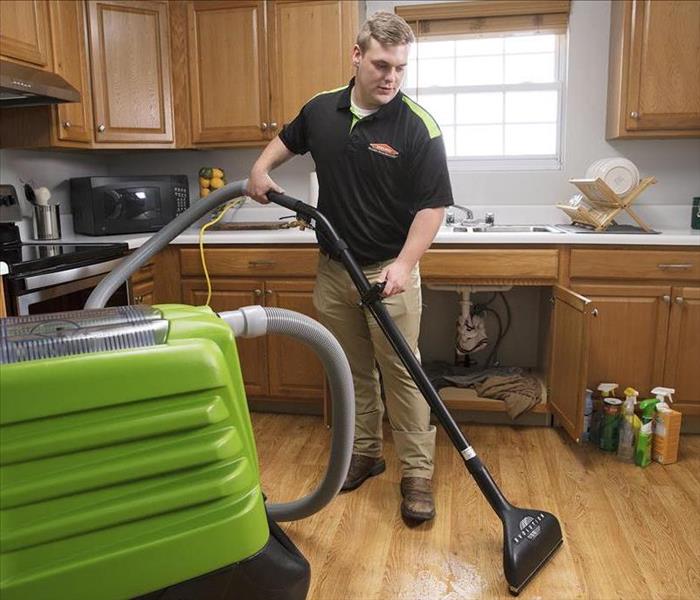 Water damage restoration is putting someone's home or business back together after a water damage event.
Water damage restoration is putting someone's home or business back together after a water damage event.
At SERVPRO of Fernandina Beach/Jacksonville Northeast, our goal is to restore instead of replace whenever possible. Following are the steps we undertake in order to restore your property after a water damage incident.
Water damage restoration entails:
- It is putting someone’s home or business back together after a water damage incident.
- It is the extra things, like re-laying the carpet, repairing the subfloors, and re-setting the contents.
- It is restoring items to a preloss (normal) condition, whenever possible.
Once the structure and contents are dry, our technicians can perform the restoration services. Restoration services are all of the tasks needed to return the site to its normal, preloss condition. During restoration:
- All repairs to structure and contents are completed.
- Final cleaning is performed.
- Final inspections are made.
- All equipment is removed from the job site.
- All of the customer’s contents are put back in place.
Restoration may include:
- Cleaning, repairing, or reinstalling floors and floor coverings, such as carpets, carpet pads, hardwood floors, resilient, and non-resilient floors.
- Removing and resetting contents to install or repair floor coverings.
- Installing tack strip.
- Seaming carpet.
- Repairing or replacing subfloors.
- Cleaning, replacing, or refinishing structural materials, including walls, plates behind baseboards, ceilings, insulation, framing, and vapor barriers.
- Cleaning or repairing items in nonliving areas, including basements, crawl spaces, attics, and storage areas.
- Cleaning, repairing, or replacing ductwork or other portions of the HVAC system.
- Inspecting, cleaning, or replacing components of the electrical system, including outlets, switches, light fixtures, and ceiling fans.
- Cleaning, deodorizing, or replacing window coverings, including blinds and draperies.
- Cleaning and deodorizing contents.
Call SERVPRO of Fernandina Beach/Jacksonville Northeast at 904.729.2401 if you have water damage. We’ll make it “Like it never even happened.”
Away from Home? Prevent Water Damage While You’re Away
6/20/2019 (Permalink)
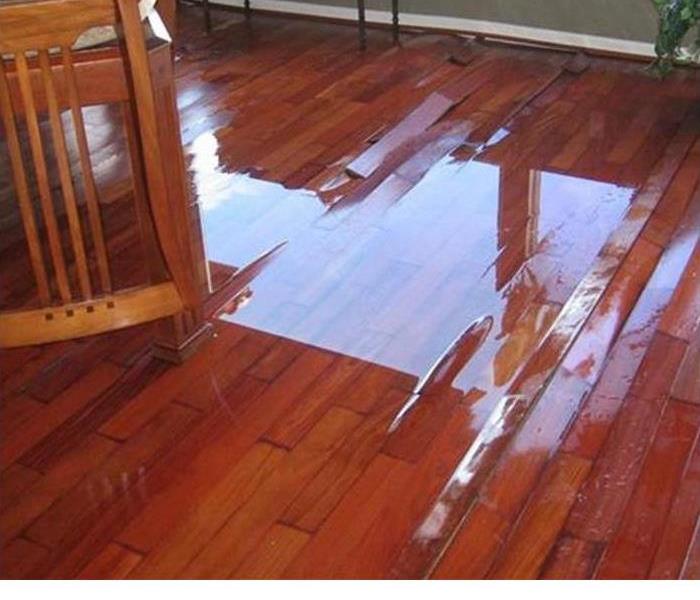 Don't return from vacation to find water damage at your home. Following these tips will help insure that doesn't happen.
Don't return from vacation to find water damage at your home. Following these tips will help insure that doesn't happen.
Many things can go wrong in your home while you’re away on vacation, including leaks and water damage. Read the steps below to learn how to help prevent and reduce the risk of water damage when you’re out of town:
Check for Leaks
Before you leave for vacation, be sure to check around your house for any leaks. Check pipes under sinks, your water heater, or anything resembling rust, cracks, or other damage. It’s important to check the seals around your windows and the exterior of your home as well. If you find any leakage, be sure to fix it right away so everything can be repaired and in good condition before you leave.
Inspect Appliances
Appliances such as your dishwasher, washer/dryer, and refrigerator are all connected to your home by hoses. If these hoses are damaged in any way, they can cause major water damage to your home. Inspect your appliances and, if needed, replace hoses before leaving on vacation.
Clean Your Gutters
Cleaning leaves and other debris out from your gutters before taking a vacation is an easy way to prevent potential blockage and build up.
Turn Off the Water
Whenever you’re away from your home for an extended period of time, turn off the water main and make sure the pipes are completely drained. This will stop any water from continually leaking in your home while you’re away. Simply run the water and flush your toilet after you turn off the water.
Have Someone Check on Your Home
Coordinate to have someone come over and check on your home while you’re away. Asking a friend, neighbor, or family member to keep an eye on your property can help keep it in good shape, and they can notify you immediately if something goes wrong.
Following these tips, you can enjoy your vacation with the peace of mind that your home is safe from any potential water damage that could occur while you’re away. If your home does suffer from water damage, call our team at SERVPRO of Fernandina Beach/Jacksonville Northeast at 904.729.2401. We can help remove, repair and restore any damage to your home.
What Is Water Damage Restoration?
5/15/2019 (Permalink)
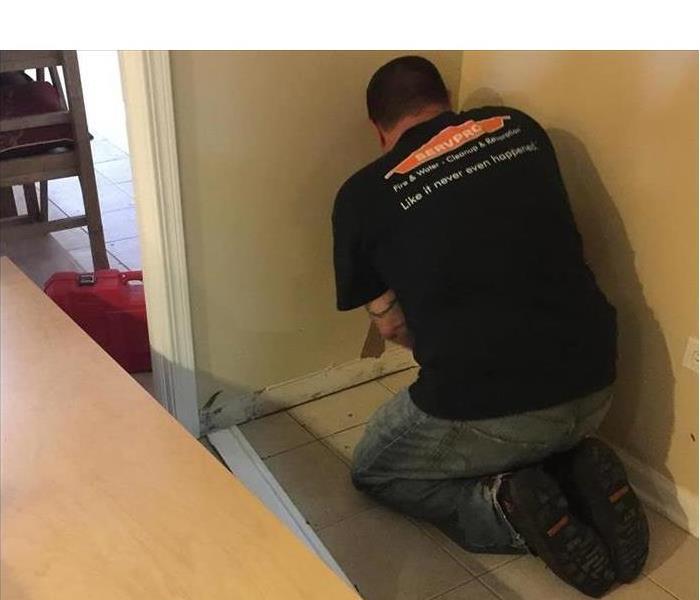 At SERVPRO of Fernandina Beach/Jacksonville Northeast, our goal is to restore instead of replace whenever possible following water damage.
At SERVPRO of Fernandina Beach/Jacksonville Northeast, our goal is to restore instead of replace whenever possible following water damage.
At SERVPRO of Fernandina Beach/Jacksonville Northeast, our goal is to restore instead of replace whenever possible. Following are the steps we undertake in order to restore your property after a water damage incident.
- It is putting someone’s home or business back together after a water damage incident.
- It is the extra things, like re-laying the carpet, repairing the subfloors, and re-setting the contents.
- It is restoring items to a preloss (normal) condition, whenever possible.
Once the structure and contents are dry, our technicians can perform the restoration services. Restoration services are all of the tasks needed to return the site to its normal, preloss condition. During restoration:
- All repairs to structure and contents are completed.
- Final cleaning is performed.
- Final inspections are made.
- All equipment is removed from the job site.
- All of the customer’s contents are put back in place.
Restoration may include:
- Cleaning, repairing, or reinstalling floors and floor coverings, such as carpets, carpet pads, hardwood floors, resilient, and non-resilient floors.
- Removing and resetting contents to install or repair floor coverings.
- Installing tack strip.
- Seaming carpet.
- Repairing or replacing subfloors.
- Cleaning, replacing, or refinishing structural materials, including walls, plates behind baseboards, ceilings, insulation, framing, and vapor barriers.
- Cleaning or repairing items in nonliving areas, including basements, crawl spaces, attics, and storage areas.
- Cleaning, repairing, or replacing ductwork or other portions of the HVAC system.
- Inspecting, cleaning, or replacing components of the electrical system, including outlets, switches, light fixtures, and ceiling fans.
- Cleaning, deodorizing, or replacing window coverings, including blinds and draperies.
- Cleaning and deodorizing contents.
Call SERVPRO of Fernandina Beach /Jacksonville Northeast at 904.729.2401 if you have water damage. We’ll make it “Like it never even happened.”
Freeze Watch Issued for North Florida/South Georgia
1/29/2019 (Permalink)
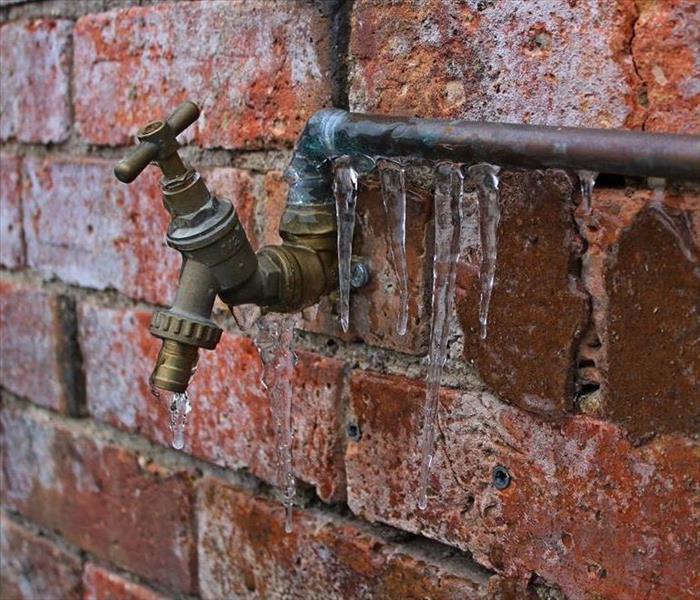 All it takes is a few hours of freezing temperatures for your pipes to freeze.
All it takes is a few hours of freezing temperatures for your pipes to freeze.
According to the National Oceanic and Atmospheric Administration (NOAA) and the National Weather Service, the Polar Vortex is affecting more than the Midwest and Northeast.
Though our local temperatures are supposed to reach the low 60’s today, there has been a freeze watch issued for tonight. Here’s the actual bulletin.
Freeze Watch
URGENT - WEATHER MESSAGE
National Weather Service Jacksonville FL
Tue Jan 29 2019
Inland Duval-Bradford-Clay-Gilchrist-Alachua-Coastal Nassau- Coastal Glynn-Coastal Camden- Including the cities of Normandy, Ortega, Riverside, San Marco, Starke, New River, Doctors Inlet, Lakeside, Bellair, Middleburg, Orange Park, Trenton, Gainesville, Gainesville Airport, Newnans Lake, Amelia City, Fernandina Beach, Yulee, Jekyll Island, Glynn Haven, Sea Island, St. Simons, Country Club Estate, Dock Junction, Dover Bluff, Kingsland, and Dungeness
Tuesday Jan 29 2019 ...FREEZE WATCH NOW IN EFFECT FROM LATE TONIGHT THROUGH WEDNESDAY MORNING...
* TEMPERATURES...Lows in the lower 30s.
* TIMING...Late tonight into Wednesday morning.
* IMPACTS...Freezing temperatures could kill sensitive vegetation.
PRECAUTIONARY/PREPAREDNESS ACTIONS... A Freeze Watch means sub-freezing temperatures are possible for at least 2 hours. Precautions may be required to protect plants, pets and those vulnerable to the cold if a freeze warning is issued.
Though it’s unlikely some areas of North Florida and South Georgia could get frozen pipes. Water pipes in houses in southern climates often are more vulnerable to winter cold spells. The pipes are more likely to be located in unprotected areas outside of the building insulation, and homeowners tend to be less aware of freezing problems, which may occur only once or twice a season.
All it takes is a few hours of freezing temperatures for your pipes to freeze.
Letting a faucet drip during extreme cold weather can prevent a pipe from bursting. Opening a faucet will provide relief from the excessive pressure that builds between the faucet and the ice blockage when freezing occurs. If there is no excessive water pressure, there is no burst pipe, even if the water inside the pipe freezes. A dripping faucet wastes some water, so only pipes vulnerable to freezing (ones that run through an unheated or unprotected space) should be left with the water flowing. The drip can be very slight.
Here are some helpful hints to help you avoid problems:
- Keep one or two faucets dripping
- Direct warm air to any colder areas of your home
- Leave cabinet doors open to allow warm air in--especially if your kitchen sink is on an outside wall
- Disconnect your hose from the outside faucet
- Seal leaks that allow cold air into your home where pipes are located
Water damage caused by frozen pipes can be one of the most damaging problems a homeowner can face. Most homeowners insurance will cover damage resulting from a frozen pipe provided you can prove that you took measures to prevent the pipe from freezing.
The good news is that SERVPRO of Fernandina Beach/Yulee will be here to help 24/7 if you run into frozen pipes and resulting water damage problems. Call us at 904-729-2401.
Need Water Damage Cleanup in Nassau County/North Jacksonville? Call the Experts at SERVPRO of Fernandina Beach/Jacksonville Northeast
1/18/2019 (Permalink)
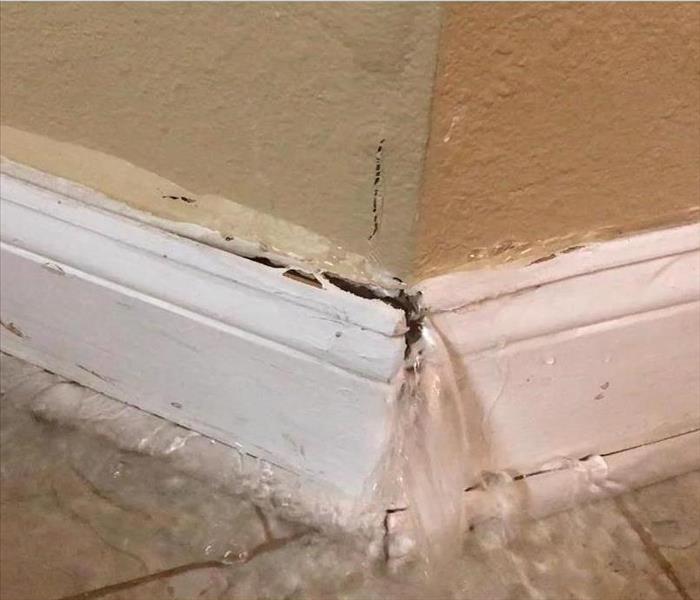 You never want to see water coming out of your baseboards. Call SERVPRO to make water damage cleanup emergencies "Like it never even happened."
You never want to see water coming out of your baseboards. Call SERVPRO to make water damage cleanup emergencies "Like it never even happened."
A pipe leak at a hotel near Jacksonville Airport causes water damage, a burst water heater floods a homeowner's property in Oceanway, a roof leak at a Church in Callahan, flooding from fire rescue efforts at a business on Amelia Island...Or a malfunction in the installation of a tankless water heater creates water damage at a Fernandina Beach condo, but the unit’s water shut-off valve is stuck, and no one knows how to turn the water off to the building.
Water damage happens…more often than you’d think and often when you least expect it. The consequences can be devastating. We are the water cleanup professionals. If your Fernandina Beach/Yulee/North Jacksonville property has water damage caused by flooding or water leaks, we at SERVPRO of Fernandina Beach/Yulee have the experience, expertise, and equipment for complete water extraction and water restoration of your property. We are water restoration specialists: Whether the source is plumbing/pipe breaks, appliances, sprinklers, or sewer back-ups, we can cleanup your water damage and restore your home or commercial property. Our water removal, cleanup, and restoration process also provides validation and documentation that your property is dry and the water damage is restored.
Plus, we work with all insurance companies. We offer 24/7 emergency service to address your water damage situation quickly and with a sense of urgency. We get there fast and remove the water fast! And we serve the North Jacksonville, Fernandina Beach and the surrounding areas, including all of Nassau county.
Have Water Damage and Need Water or Flood Cleanup?
Call Us Today – (904) 729-2401
Here are some water damage tips to help you know what to do and what not to do when you have water damage issues and need water or flooding remediation, cleanup, and restoration services. Here's a blog on how to find the water shut-off valve. Call us at 904.729-2401 and we’ll take care of your water damage emergency…”Like it never even happened.”
Where to Look for Water Damage
1/17/2019 (Permalink)
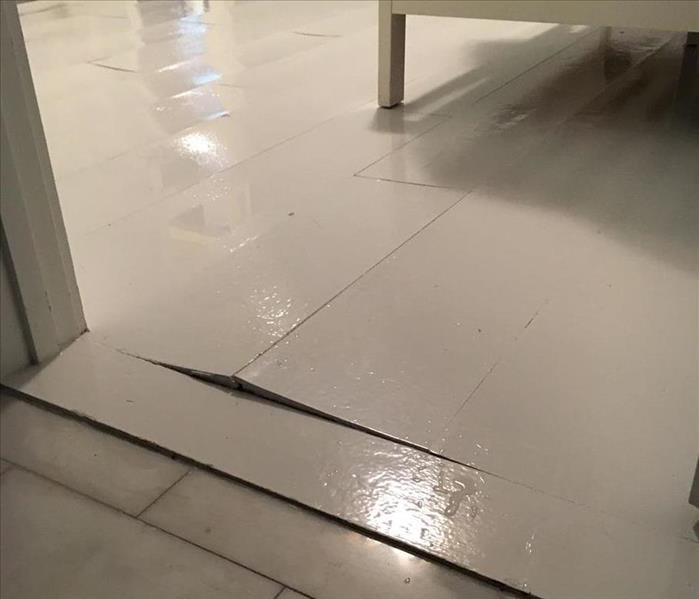 Buckling floors can be a sign of water damage.
Buckling floors can be a sign of water damage.
Flooding is common in Florida, but water damage can come from many different places and is not just a problem for people living on the coast. While the damage from a flood is pretty apparent, there are many ways water damage can happen to your home when you don’t even realize it.
Here are some common causes of water damage and how you can spot the warning signs.
Weather is a common cause of water damage. Rains cause flooding that can get into your home. Even if it isn’t raining or snowing there is still moisture in the air. Damp air can lead to condensation and water damage to your walls. This is especially true of basements, bathrooms, and other damp areas of your home that don’t get much airflow.
Appliances like your washing machine, garbage disposal, water heater, toilet, and air conditioner can all contribute to water damage if they leak or stop draining properly.
Water from our pipes and plumbing systems can also cause water damage. Leaks and drips can go on for months, or even years, raising your water bill and doing unseen damage to your home.
So if these are all the ways water can sneak into your home, what are the signs of water damage?
Here are a few warning signs that you have a water damage problem in your home.
Standing water – This may sound pretty obvious, but if you notice water pooling in your house you have a water problem that needs to be taken care of immediately.
Bad smells – While water doesn’t normally have much of a smell, the mold and bacteria that grow in damp environments can give off a distinct musty, wet odor. If you smell mold or mildew you might have a water issue.
Stains and spots – Stains on the ceilings or walls can be a sign of water damage. You might have a leaky pipe or roof. Call a professional to determine the cause of the problem and to clean up the damage before it becomes a serious mold problem.
Peeling paint – Paint damaged by water will start to peel, bubble, or flake off.
Uneven surfaces – Water damage can cause floors, ceilings, walls, and other surfaces to warp and feel uneven.
Cracks – Water is always seeking the path of least resistance out of your home. Water can enter through cracks and once water finds its way in, the crack will expand allowing even more to get into your home. Make sure you seal all visible cracks on your property.
If you notice your home has water damage call the experts at SERVPRO of Fernandina Beach/Jacksonville Northeast at 904.729.2401.
Leaking Sliding Glass Doors of Fernandina Beach Condo Cause Water Damage
12/14/2018 (Permalink)
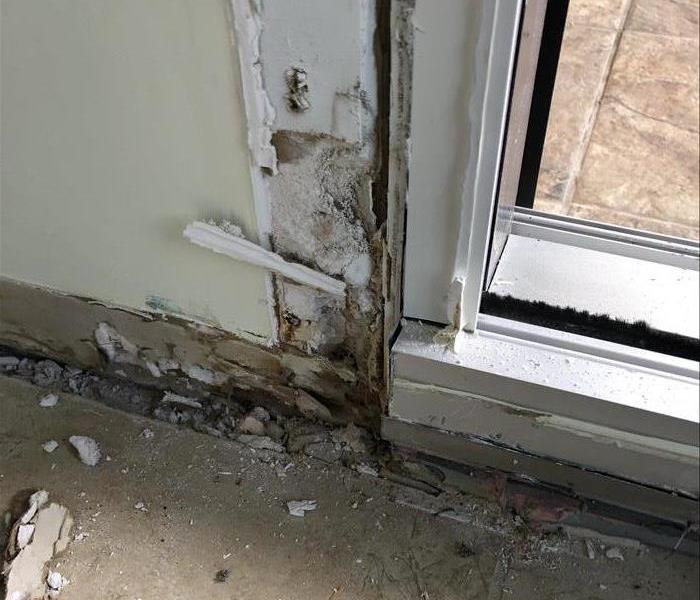 If you have water damage, call SERVPRO of Fernandina Beach/Jacksonville Northeast right away to prevent further damage and mold growth.
If you have water damage, call SERVPRO of Fernandina Beach/Jacksonville Northeast right away to prevent further damage and mold growth.
A severe storm with high winds and significant rainfall impacted the sliding glass doors in this beachfront condominium. The house was a rental and no one was aware of the leak for several days. Water from the leak seeped into the adjoining walls and down three floors. After fixing the source of water intrusion, we removed the affected drywall of adjoining walls and thoroughly dried the affected area.
If you have a problem with water leaking from your sliding glass doors, it will usually be on the bottom track threshold of the non-stationary door. The easiest way to prevent leaks is to keep your tracks free of debris and your plastic or metal rollers clean. If the tracks are dirty, the doors can become misaligned and water can easily seep into the home.
If you have water damage, call the professionals at SERVPRO of Fernandina Beach/Jacksonville Northeast at 904.729.2401 right away. Timely mitigation is the key to preventing further damage and/or mold growth.
Nassau County, North Jax Area 24 Hour Emergency Water Damage Service
10/29/2018 (Permalink)
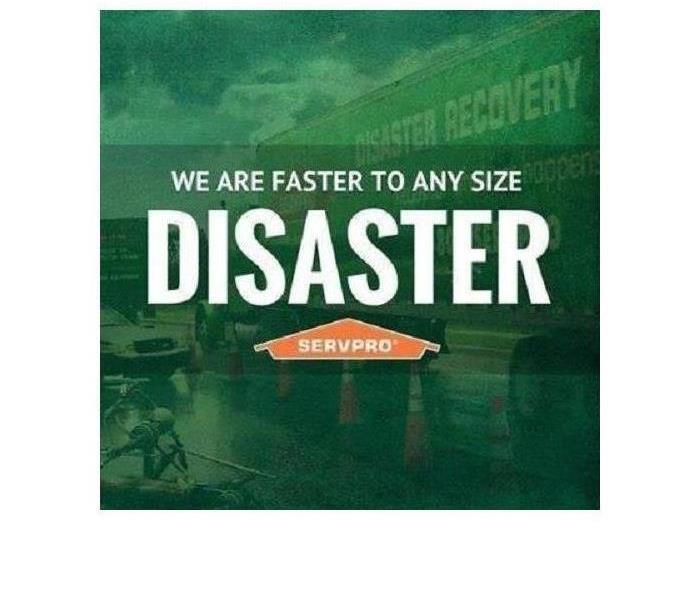 If you have a water damage emergency, SERVPRO of Fernandina Beach/Yulee is here to help 24/7.
If you have a water damage emergency, SERVPRO of Fernandina Beach/Yulee is here to help 24/7.
SERVPRO of Fernandina Beach/Yulee is available 24 hours a day for water emergencies, large or small. When you are dealing with water damage, immediate action is crucial. A delay of just a few hours can greatly increase the severity of the water damage.
We Answer the Phone Ready to Help, Call Today! - (904) 729-2401
We understand that when you call us, you may be feeling confused, stressed, and vulnerable. You need an expert to guide you through this crisis. SERVPRO of Fernandina Beach/Yulee has the specific water damage training and experience to help you through this tough time. We specialize in water damage restoration—in fact, it's the cornerstone of our business.
What to Expect
When you call, we will ask several questions regarding your water damage emergency. These questions will help us determine what equipment and resources to bring, including how many trained SERVPRO Professionals may be needed.
Our SERVPRO Representative will ask several questions:
- Your name and contact information
- Your insurance information (if applicable)
- The street address of the water-damaged home or business
- When did the flooding or water damage occur?
- What caused the water damage (if known)?
- Is there electricity available (on-site)?
About SERVPRO of Fernandina Beach/Yulee
SERVPRO of Fernandina Beach/Yulee specializes in the cleanup and restoration of residential and commercial property after a fire, smoke or water damage event. Our staff is highly trained in property damage restoration. From initial and ongoing training at SERVPRO’s corporate training facility to regular IICRC-industry certification, our staff is equipped with the knowledge to restore your property.
Water Damage Restoration Service in Nassau County/North Jax
9/4/2018 (Permalink)
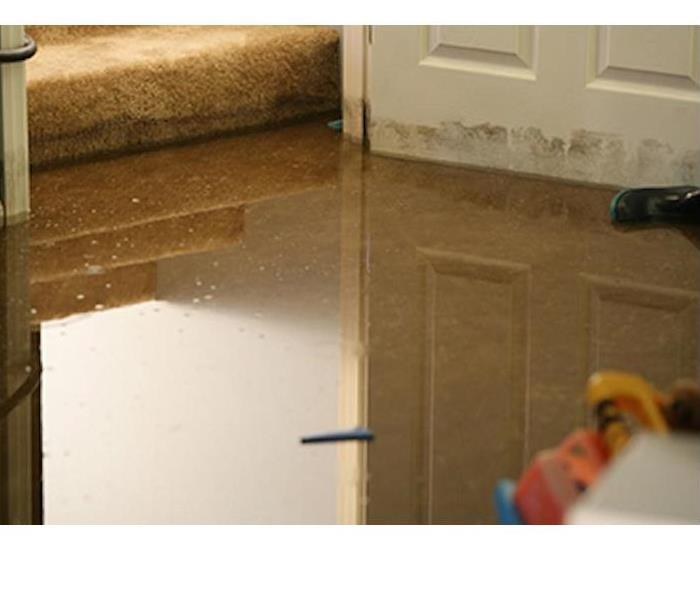 Time is of the essence in the aftermath of a flood in order to prevent mold growth.
Time is of the essence in the aftermath of a flood in order to prevent mold growth.
From estimation to completion, our experienced team at SERVPRO of Fernandina Beach/Yulee is ready to handle your home’s water damage cleanup and restoration needs. With our help you can rest assured that your assets will be protected and damage kept minimal.
Our trained technicians will use specialized equipment to find out just how severe your water damage problem actually is. Once they’ve evaluated the damage, they’ll get rid of any standing water then begin the drying process.
Steps to take when Water Damage Strikes:
- Act Quickly: The severity of damage escalates the longer water sits and building components and contents stay wet, so time is of the essence in the aftermath of a flood. In fact, mold will grow within 48-72 hours, so aim to start removing water and drying the environment within 48 hours.
- Ventilate affected areas to prevent mold growth: Mold spores love moisture and organic materials such as paper or particleboard. In order to mitigate or slow damage, open windows if weather permits and place fans inside of them to keep air moving and maintain moderate temperatures. Work toward the fan as you clean to minimize cross contamination.
- Assess damage to items and materials: Assess the type of water absorbed by items, such as rainwater, water from broken pipes, contaminated river water or bacteria-filled sewage. There are ways to salvage specialty items but the decision on whether to save or trash an item will vary depending on the dollar and sentimental value to the owner. It may not be worthwhile to salvage drywall, carpets and pads, mattresses, pillows, box springs and particleboard. On the other hand, it might be worthwhile to restore costly Persian rugs, leather couches and antiques or heirlooms. Wet clothing and many household fabrics may be salvageable through machine washing, and a 10-minute soak in detergent and hot water, to remove contamination and stains. The IICRC strongly recommends that in water damages where there are contaminants present (e.g., bacteria, sewage, mold) or where small children or immune-compromised individuals are present that an inspection be conducted by an appropriately trained restorer and remediator. SERVPRO of Fernandina Beach/Yulee is a Florida-licensed mold remediator (MRSR450).
- Expose pockets of saturation: Hidden and concealed pockets of saturation need to be opened for cleaning and drying. Layers between building materials hold water that must be discovered and removed or dried. On walls, find the water line and inspect at least a foot beyond it to make sure all damage, wet materials and mold are discovered. Remove and discard the damaged drywall and wet wall insulation. Wet carpets can usually be dried by professionals with the right equipment, but carpet padding, which is like a big sponge, should be discarded. Wood base trim and hardwood can also be saved with the right equipment if they can be accessed and completely dried on both sides. Remember to investigate concealed cavities such as behind walls, in mechanical spaces, under cabinets and furniture, and in crawl spaces.
- Confirm drying before reconstruction: In order to prevent dry rot and structural damage, it’s important not to reconstruct or cover wood and other wet materials until the moisture content has been adequately reduced. A water restoration professional can confirm proper drying before reconstruction. Call SERVPRO of Fernandina Beach/Yulee at 904-729-2401 to ensure proper drying has taken place.
8 Tips for Avoiding Plumbing Emergencies
8/16/2018 (Permalink)
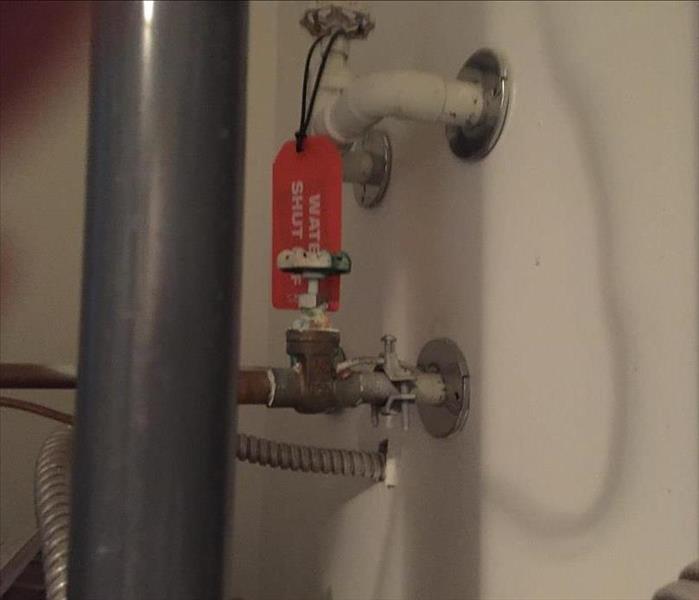 It pays to know where your water shut-offs valves are located, and if they are operational.
It pays to know where your water shut-offs valves are located, and if they are operational.
Source: Water Damage Defense…
https://www.waterdamagedefense.com/blogs/home-maintenance-blog/plumbing-maintenance
Plumbing maintenance may not be the most exciting topic, but it is well worth your attention! By regularly examining your plumbing system, and performing preventative maintenance, you can save yourself from both costly repair bills and the slow, steady expense caused by drips and leaks. Here is a maintenance checklist to help you stay ahead of common plumbing problems.
- Water heater: Many plumbers recommend draining and cleaning your water heater annually. Most people hire a professional to handle these tasks, due to their technical nature, and often they are even included in your plumbing fixture’s service contract.
- Valves: Locate all your shut-off valves and turn them off, then back to their original position, to make sure they would not be stuck open in the event that you need to shut the water off. While you are at it, look them over for any sign of corrosion, which could lead to an undetected leak. Replace any valves that are not working properly. Finally, make sure that your entire family knows where your shutoff valves are located, especially the main one, since this is very valuable information in case a leak occurs.
- Leaks: Leaks can develop in many different places in your plumbing system and should be addressed immediately to curtail waste and water damage. Periodically check for any of the following signs of trouble: soft flooring near toilets, bathtubs, dishwashers, water heaters or washing machines; dampness inside sink cabinets; soft walls or loose tiles that could signal a leak inside a wall; pipes with rust or mineral deposits; constant dampness around faucets or toilets; and finally toilets that keep running after being flushed. Use water shut off valve or water leak detection systems to alert you when water leaks occur.
- Old or malfunctioning fixtures: Generally, toilets, dishwashers, washing machines, water heaters, and boilers that are more than 12 years old are good candidates for replacement. New appliances will be more energy and water efficient. Check the item’s serial number, since this often indicates the year it was manufactured. Companies use a variety of coding methods, so perform a quick internet search to find out what to look for. Additionally, replace old faucets with new, washer-less models to save on maintenance costs, and replace any hardened or cracked hoses on washers and dishwashers to reduce the risk of a rupture. The old adage “If it isn’t broken, don’t fix it,” does not always make sense when it comes to plumbing! Keep in mind that by swapping the old plumbing fixtures for new, more efficient models you could save money every month on your energy and water bills in addition to avoiding costly water damage repair bills.
- Caulking: Check and re-do any aging caulking around bathtubs, showers, toilets, and sinks that might be allowing water to penetrate the surrounding structure.
- Septic: If you have a septic system, any persistently marshy areas in your drainage field may signal a leak in your septic line. Although pumping a septic tank is an essential element of plumbing maintenance, there is no hard and fast rule governing how frequently you should pump the tank. It depends on several factors, like the number of people in your household, whether there is a garbage disposal, the size of your tank, its system design, and even the temperature in your region. Consult a septic expert to find out how often you should pump your septic tank.
- Low water pressure: Test for low water pressure by running water from your tub faucet and then opening the kitchen faucet. If the pressure decreases when you open the second faucet, you should get a plumber to analyze the problem. Low water pressure is often caused by a leaks or sediment build-up in pipes.
- Drains: Clogged drainpipes can often be avoided by regularly cleaning your drains with an eco-friendly drain cleaner. One easy way to clean your kitchen garbage disposal is to send some ice through it to clean out any grease that may have accumulated inside. Also, look for bubbles escaping up from a drain while water is trying to go down, as this could indicate a drain vent problem.
Whether you perform these maintenance checks yourself or hire a professional to handle them, it is a worthwhile investment of your time or money. By taking preventative measures, you greatly reduce the risk that you encounter costly surprises down the road.
If you do have water damage, call the professionals at SERVPRO of Fernandina Beach/Yulee at 904.729.2401.
When Water Damage Strikes, SERVPRO of Fernandina Beach/Yulee Is There!
5/21/2018 (Permalink)
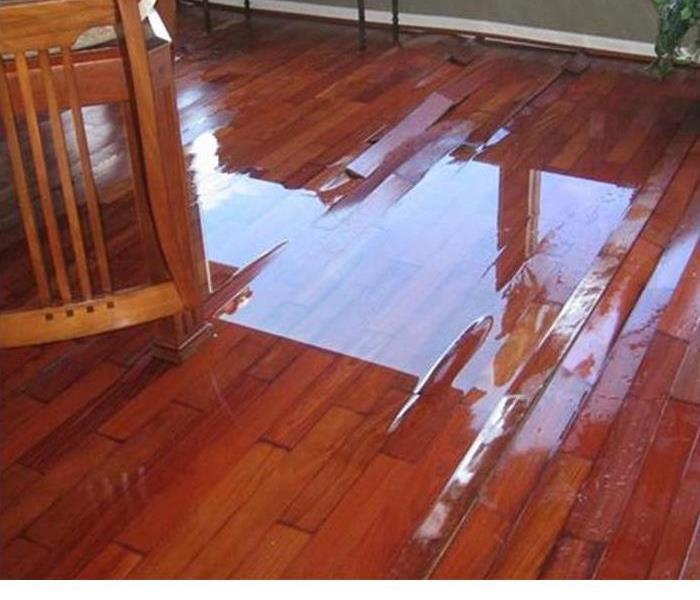 The first 24 hours following a water loss are the most important in preventing secondary or permanent damage.
The first 24 hours following a water loss are the most important in preventing secondary or permanent damage.
The first 24 hours following a water loss are the most important in preventing secondary or permanent damage. Within fours hours of being notified of a loss, SERVPRO of Fernandina Beach/Yulee will be on-site to help ensure a water damage is handled by completing the following steps.
Inspection
SERVPRO of Fernandina Beach/Yulee will inspect affected areas to determine the extent of water damage and will review the inspection with you to answer any questions before beginning any work.
Emergency Services
SERVPRO of Fernandina Beach/Yulee will take steps to help protect your home or business, as well as personal belongings and other contents, from further damage by extracting the excess water and preparing the area for drying. They will explain the needed emergency services step-by-step.
Monitoring
To help ensure your home or business and belongings are dried to appropriate industry standards, a SERVPRO of Fernandina Beach/Yulee technician will monitor the drying process. The updates will be consistently communicated to you.
Restoration Services
SERVPRO of Fernandina Beach/Yulee will repair structural materials, reinstall carpets, and clean affected areas of your property and belongings. A final walk-through of the jobsite will be conducted with you to help ensure the property was returned to preloss conditions.
Call SERVPRO of Fernandina Beach/Yulee at 904.729.2401 if you experience water damage.
Rain Damage vs. Flood Damage
3/30/2018 (Permalink)
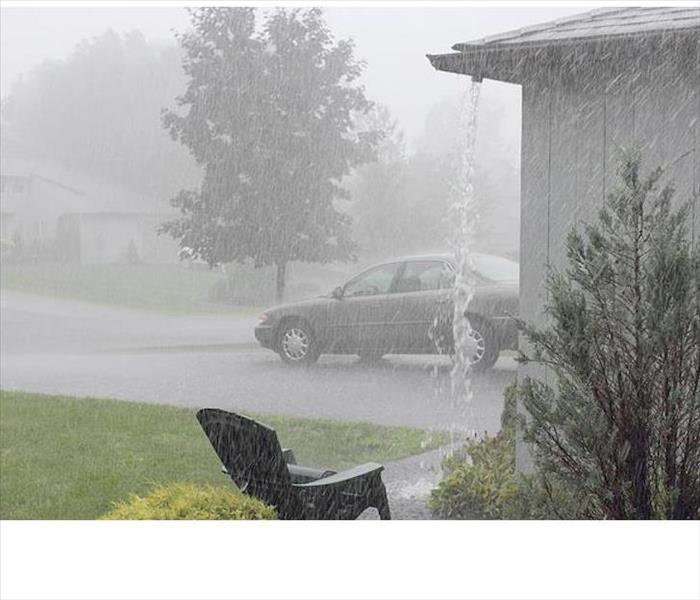 If you suffer water damage to your home or business, call us at 904.729.2401.
If you suffer water damage to your home or business, call us at 904.729.2401.
What is the difference between rain damage and flood damage to your home?
Rain damage is caused by falling water. A leaky roof or window can cause rain to intrude into your home. Gutters and downspouts can also be a large contributor to rain damage. It is important to clean your gutters and downspouts to keep the rain away from your walls and windows.
Flood damage is caused by rising water. Improper grading, failing drainage, or rising creek water are all examples of how flood damage can occur in your home. Flood damage can also cause cracks to your foundation allowing excess water to intrude into your home.
It is important to professionally dry the structure so as to prevent further damage. SERVPRO of Fernandina Beach/Yulee uses updated technology and professionalism to treat your home as if it is ours. We want to help you restore your home “Like it never even happened.”
Learn more about our water restoration process. If you suffer water damage to your home or business, call us at 904.729.2401. We offer 24/7 emergency service.
CC Image Courtesy of s58y on Flickr.
Did You Know: A Water Damaged Wall Can Be Dried & Restored, Rather Than Replaced?
3/20/2018 (Permalink)
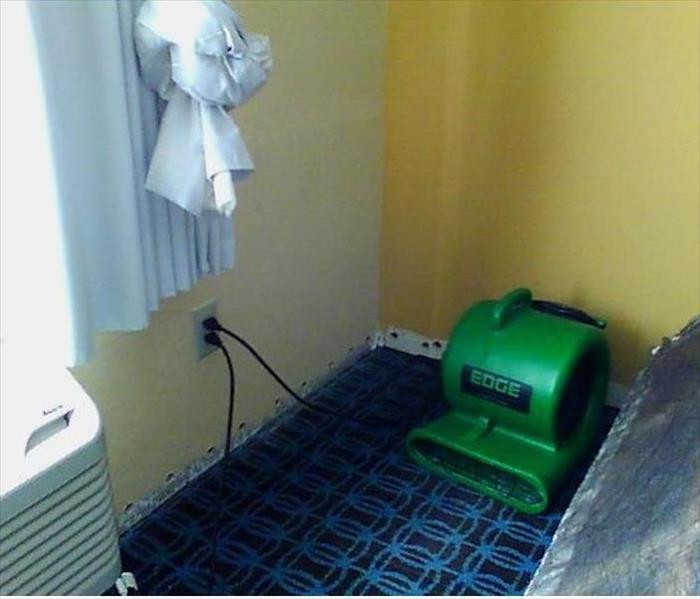 Drilling small holes along the bottom of the wall and ventilating the wall cavity can greatly reduce drying time.
Drilling small holes along the bottom of the wall and ventilating the wall cavity can greatly reduce drying time.
So a plumbing leak or other water intrusion leaves you with wet walls. Here’s the question we at SERVPRO often get: Do the walls have to be removed and replaced? Well, it depends.
In the past, restoration practices called for the replacement of wet drywall from walls. Today there is technology that allows SERVPRO to save walls by drying them, which significantly reduces restoration costs.
It’s part of SERVPRO’s restore vs. replace philosophy, and it can save homeowners (or businesses) a bundle.
Factors to Consider & Steps Involved
When floodwaters or sewage have entered the home—or when structural integrity has been compromised--industry standards require the removal of porous building materials. In most other cases, saving a wall is possible when a skilled restorer such as SERVPRO of Fernandina Beach/Yulee uses the appropriate techniques.
A common impediment to effectively drying walls is a vapor barrier, which is a material that impedes the evaporation of moisture from walls or other materials. Removing the outer vapor barrier or perforating gloss paint expedites the drying process.
Another consideration is insulation. A wall may contain fiberglass, spray foam, or blown-in insulation. Blown-in fiberglass can compact and move down the wall cavity when it becomes wet. When this happens, the insulating properties of the materials cannot be restored. The insulation will need to be removed and replaced. Fiberglass insulation with paper backing can usually be successfully dried using air injection or similar methods. Sprayed-in insulation usually needs to be removed.
Drying can be accelerated by drilling small holes along the bottom of the wall and ventilating the wall cavity, greatly reducing drying time. When drying is complete, these holes are patched or, ideally, covered by baseboard. The process described above is faster and less expensive than removing and replacing walls.
SERVPRO’s IICRC-certified technicians employ a specific set of standards that incorporate the field of psychometry, which involves the manipulation of temperature and relative humidity, and special equipment to measure and remove moisture and to dry a property quickly and effectively.
How much does it cost to restore water damage?
Fixr.com is a web site that provides cost guides and comparisons for hundreds of remodeling, installation and repair projects. Following is an excerpt from their web regarding comparing costs drying vs. replacement when there is water damage (to a 700 sq. ft. area).
Not all water damage is equal; water from “clean” sources such as a pipe or rain is easier and less costly to clean up, while water from a backed up sewer pipe or a leak that’s only found after mold has grown is going to be more difficult and more costly to clean.
The average cost of simply drying out your property from a “clean” water leak (including water removal, drying, and decontamination) with no further damage done or restoration needed is around $2,700, while the average cost of drying out your home and repairing the damage done to areas like drywall and carpeting is around $7,500. Costs continue to go up from here depending on the source of the water, how much water, and how great the damage.
Tips to Help Prevent Water Damage In Nassau/North Jax Homes
1/26/2018 (Permalink)
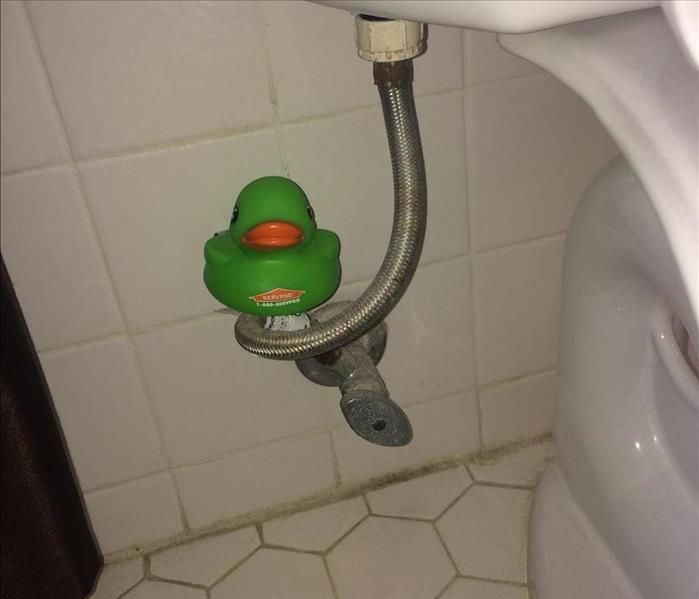 Knowing where to locate shut-off valves can help to minimize water damages in the event of a plumbing or appliance failure.
Knowing where to locate shut-off valves can help to minimize water damages in the event of a plumbing or appliance failure.
Knowing common sources of water damage around your home can help you avoid big repair bills as well as time and trouble. Most floods and water damage are caused by plumbing and appliance failures. An example would be dishwashers, toilets, or washing machines that leak or overflow. The waste-filled, chemical-laden water, which may be either gray or black water can give rise to a toxic environment. In this case water removal is the number one priority. View the tips below for preventing water damage and knowing what to do if and when it occurs.
Toilets
- After flushing, remain in the bathroom until the fill valve has finished refilling the bowl.
- If the bowl or tank begins to overflow, turn off the water at the supply valve.
- Inspect the flushing mechanism inside the toilet every six months.
- The fill valve should shut off when the float reaches the proper water level.
- Operate the shut-off valve to make sure the water supply will turn off properly. Replace if needed.
Washing Machines
- Turn supply valves off when not in use for extended periods of time.
- Do not operate the washing machine while the home is unoccupied.
- Inspect the water supply lines every six months.
- Check the hoses for cracks, kinks, blisters, or scaling, all of which are commonly found near the hose connection.
- Replace washing machine hoses every 5 years or according to manufacturer’s instructions.
- Consider using reinforced braided stainless steel hoses
Water Heaters
- Have a professional inspection of the anode rod at least once every two years and annually once the warranty has expired. The rod may eventually corrode and leave the tank vulnerable to damage.
- Remove sediment by flushing the tank every six months. Sediment can build up faster in areas with hard water.
Refrigerator Icemakers
A refrigerator containing a water filtration system and ice maker may develop hose leaks from the water supply line. If these leaks remain unnoticed for extended periods of time, they can give rise to mold proliferation and damage to the walls, floors, and the foundation. If the refrigerator is leaking water, it could have a clogged or frozen defrost drain.
- Proper installation of the ice maker supply line hose is important to avoiding water damage.
- Ensure a tight connection between the hose and valve however, avoid over-tightening.
- If kinks are present, replace hose.
- Leave a 3 to 4 inch gap between the back of the refrigerator and the wall to prevent the hose from crimping.
- When pulling the refrigerator out for cleaning or service, avoid getting the hose caught beneath the wheels.
- Locate the water shut-off valve and check for leaks.
- Be sure water line fittings are secure.
Dishwashers
- Run the dishwasher after you get home and before you go to bed so you are able to shutoff the appliance at the first sign of trouble.
- When your unit floods, don’t panic. Instead, unplug the device or shut off the circuit breaker.
- Remove any debris from the drain gate; the drain gate is found on the bottom of the dishwasher.
- Inspect the drain and determine if it drains properly. If the water doesn’t drain, the hose that runs from the unit to the kitchen sink may need to be replaced or repaired.
If you have water damage problems or flooding, call SERVPRO of Fernandina Beach/Yulee at 904-729-2401. We’ll be there to help 24/7. For more information, visit:
Water Damage Restoration
Water Damage Tips
Water Damage Restoration Process
Storm Damage Restoration and Cleanup
Do You Know Where Your Main Water Shut-off Valves Are?
1/15/2018 (Permalink)
 As our mascot, Dewey, is showing here, the water shut-off valve inside this home is located in the garage.
As our mascot, Dewey, is showing here, the water shut-off valve inside this home is located in the garage.
No one expects pipes to burst, water heaters to break, or toilets and washers to overflow. If this happens, your quick response along with the highly trained specialists from SERVPRO of Fernandina Beach/Yulee will limit your damages and potentially save you thousands of dollars! Here are some tips for locating water shut-off valves on your property.
Source: The Spruce…
Finding the Water Shut-Off Valves
Some things in life are worth learning before it's too late—like the locations of your water shut-off valves. If a water pipe springs a leak, knowing where the shut-off valve is could save you thousands in water damage repairs. What's more, you can't make those major plumbing repairs or improvements unless you first turn off the water.
Home water systems contain two types of shut-off valves: main or master shutoff valves for stopping the flow of water to the entire house and individual or supply shut-off valves for specific appliances and fixtures.
Before Anything Else, Try to Cut Off Water Close to Source
If you have a leak at your toilet, sink, clothes washer, or ice maker, shut off water close to the source:
- Toilet: Look under the toilet, against the wall. You will see flexible metal tubing. Turn the handle clockwise until the handle stops. Do not force.
- Sink: Look under the sink cabinet. You will see two sets of flexible metal or plastic tubing. Turn clockwise.
- Clothes Washer: Some houses have the valves clearly exposed above and behind the washer. Turn both valves clockwise. If you do not see these valves, slide the washer outward and you will likely see them.
- Dishwashers: The water supply tube running to the dishwasher often has a fixture shutoff valve controlling it. In many cases, this is also located under the kitchen sink base cabinet, and it may be close proximity to the sink faucet shut-off valves.
- Refrigerator ice makers/water dispensers: The small copper or mesh supply tube running to the refrigerator usually has a small saddle valve or other devices that can be shut off to close down the water supply.
Now for the main water shut-offs to the house…
- Water Main: Locate Shut-Off Valve Within the House
This is the best way to shut off water in your house. It will cut off your home's entire water supply, allowing you to open up any pipe within the house.
Unlike the main water valve, it should be easy to access and not involve special tools or digging. (The only problem is that not everyone has one. In this case, turn off the pump at the electrical box.)
But where would you find yours? Put on your detective's hat for this one. Suggestions:
- Inside/Outside Perimeter: In most cases, it will be near the perimeter of the house—like the outside wall in a utility area where the main water line enters the house, or on an outside wall near the water meter. This valve will always be located on the house side of the water meter and is usually a rather large valve.
- Ground Level: Keep your focus on-grade. So, if you are in a basement, you will be looking at eye level or above. If on a ground level floor, you will be looking down.
- Path of Least Resistance: Imagine a straight line extending from your outdoor water meter to the nearest point of your home's exterior perimeter. Water lines will take the shortest path to get to a house. Where that line meets your house is likely where the house's shut-off is located.
- Check Inspection Report: If you still have your property inspection report from when you purchased the house, it should indicate the location of the shut-off valve. Inspection reports often follow a standardized format, so you may find this information located in Section 6.1.
- Access Panels: Look for any kind of access panel. Water cut-off valves are not supposed to be sealed up behind drywall. However, your home's previous owner may have unwisely sealed the valve behind a wall. Most homeowners--and any legitimate contractor--will create an access panel around the valve.
Where It Is Not: It is likely not under a sink. The shut-off to the water heater may look promising, but that only affects the outflow of hot water from that point. Do not confuse the gas shut-off to the furnace or water heater with water lines.
- Water Main: Locate Main Shut-Off Value Outside By Meter
If the previous two options fail, try to shut off the water main outside.
This will cut off all water in the house. This is the most rigorous option and will involve tools, and possibly even tools that you do not have on hand. It is dirty work and may involve digging.
Locate the round, square, or rectangular steel or iron lid. Lift the lid and set the lid to the side. If there is dirt or sand, remove gently with your hand or a garden trowel. Do not discard. If you live in a climate that freezes in the winter, this sand/dirt is required to prevent the pipes from freezing and bursting.
After clearing the box, you will see three things:
- Water Meter: A glass-covered meter that may have a secondary cover to protect the glass. Ignore this as it has nothing to do with shutting off the water.
- Water Company's Shut-Off Valve: This will be on the street side of the water meter. See attached image. This turn-off is designed so that only the water company can turn it off with a special tool. Do not turn this off. Even if you manage to get a Vise-Grip or Crescent wrench on this, you would find it exceedingly difficult to turn.
- Your Shut-Off Valve: This will be on the house side of the water meter. It may have a knob for turning or it may have a nut. There is no standard size for this nut. For example, some are 3/8" and require a ratchet wrench with an extender for access. Turn this clock-wise.
If you need help locating your main water shut-off valves, you can schedule a service call for SERVPRO of Fernandina Beach/Yulee to come out and assist you. Call us at 904-729-2401 if you are interested. It would be money well spent to protect your home investment.
Nassau/North Jax Homeowners: Keep on Eye on Temps to Prevent Pipes From Freezing
12/8/2017 (Permalink)
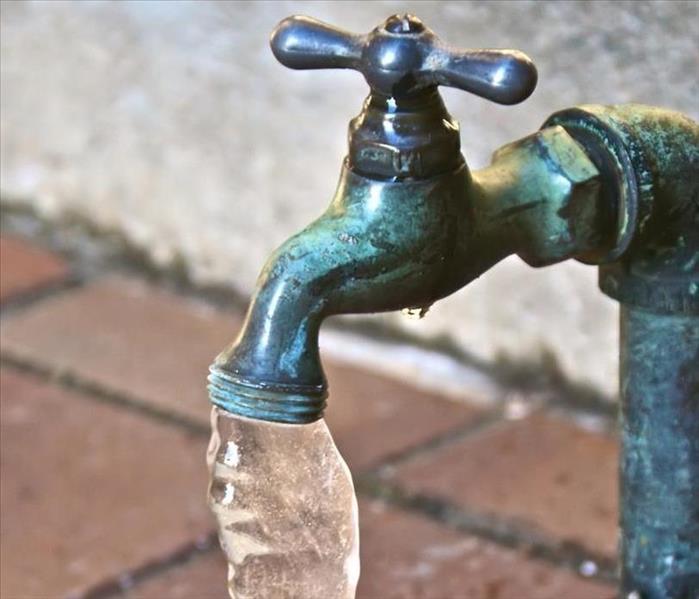 All it takes is a few hours of freezing temperatures for your pipes to freeze.
All it takes is a few hours of freezing temperatures for your pipes to freeze.
Okay, so it’s probably not likely, but it never hurts to be prepared. With temperatures expected to drop to at or near freezing over the coming week, frozen pipes could be an issue in North Florida.
WINTER STORM WATCH: Tonight through Wednesday afternoon. Icing/freezing rain may lead to dangerous road conditions by early Wednesday.
Especially with everyone catching up from the holidays, winter weather can catch us off guard. All it takes is a few hours of freezing temperatures for your pipes to freeze.
Here are some helpful hints to help you avoid problems:
- Keep one or two faucets dripping
- Direct warm air to any colder areas of your home
- Leave cabinet doors open to allow warm air in--especially if your kitchen sink is on an outside wall
- Disconnect your hose from the outside faucet
- Seal leaks that allow cold air into your home where pipes are located
Water damage caused by frozen pipes can be one of the most damaging problems a homeowner can face. Most homeowners insurance will cover damage resulting from a frozen pipe provided you can prove that you took measures to prevent the pipe from freezing.
The good news is that SERVPRO of Fernandina Beach/Yulee will be here to help 24/7 if you run into frozen pipes and resulting water damage problems. Call us at 904-729-2401.
Don’t Let Your Washing Machine Flood Your Nassau County/North Jax Home
10/19/2017 (Permalink)
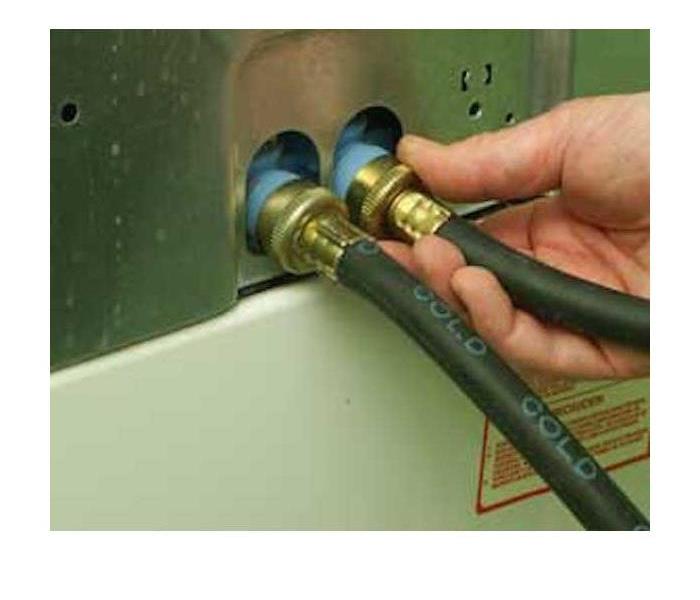 Checking the washing machine supply lines every six months, and replacing when needed, can save you a lot of money.
Checking the washing machine supply lines every six months, and replacing when needed, can save you a lot of money.
It is not unusual for our highly trained technicians here at SERVPRO of Fernandina Beach/Yulee/North Jax to be called on to respond to water damage or even floods caused by, yes, washing machines.
Helping our customers is our biggest goal, and so we want to share with you tips to help you avoid these expensive and time consuming flood losses.
First, know how to shut off your water if the washer is flooding:
- Clothes Washer: Some houses have the valves clearly exposed above and behind the washer. Turn both valves clockwise. If you do not see these valves, slide the washer outward and you will likely see them.
Here are a few simple steps you can take to ensure that your washing machine is not going to cause problems:
- Check the washing machine supply lines that are located behind the appliance every six months as part of your routine. Replace water lines when cracking or dripping occurs, or when a scale is forming around the connection to the water valve. The small investment of replacing water line can save you thousands of dollars and prevent major damage.
- Make sure the drain for your washing machine is draining efficiently. Clogged drains and supply line breaks are the leading causes for washing machine floods.
- Do not overload your washer! Though doing one large load of laundry is more convenient than doing multiple loads, overloading your washer causes the machine to vibrate and move which can knock loose connections and cause water to overflow.
- Know where your main water shutoff valve is located! In the event your washing machine does overflow, shutting off the main water supply could save you a lot of time and money.
- Do not run your washing machine if you are not awake, or not at home. If your washing machine floods, you want to be there to minimize the damage.
Insurance industry data shows the cost of washing machine floods/failures averages $5000 in an occupied home and $12,000 in an unoccupied home. Use these simple steps to help protect your investment from water damage loss. Call us if you need help at 904-729-2401.
What You Should Know About Water Mitigation
9/1/2017 (Permalink)
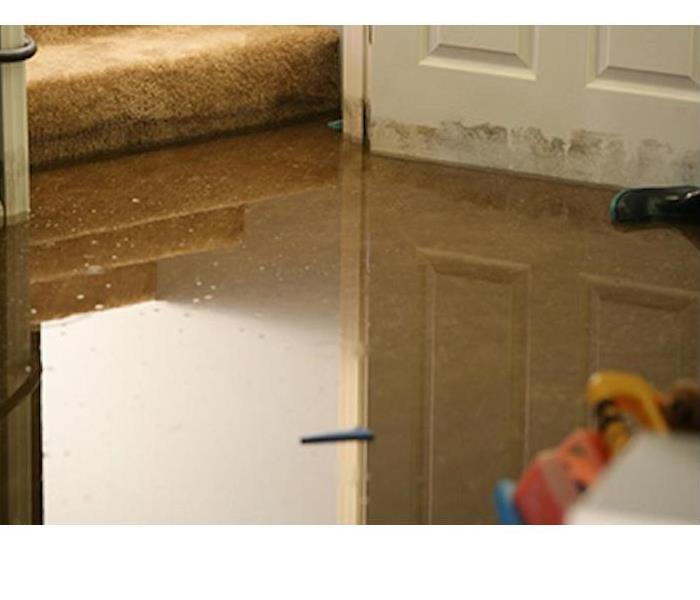 Water mitigation is all about reducing or preventing the amount of damage that happens after a flood or leak.
Water mitigation is all about reducing or preventing the amount of damage that happens after a flood or leak.
Water mitigation is the process of reducing or preventing the amount of water damage that happens after a flood or a permeating leak. It prevents additional damage by taking fast, appropriate actions.
Water mitigation is needed after plumbing failures or when storms cause water to rush into your home. Soaked rugs, damaged walls, warped flooring and ruined furniture are only the beginning if mitigation is not engaged quickly.
Specific steps are taken to reduce property destruction, to prevent further water damage and to restore your property to its full value.
When to Call For Water Mitigation
Seeping water damage is progressive, pervasive and can mean valuable objects may become permanently damaged – especially if emergency response is delayed beyond the first 48 hours.
Water damage is usually caused by a plumbing failure. When moisture seeps into anything of value there are immediate steps that can be taken to reduce the amount of long-term damage that results.
Steps to take as soon as you detect flood damage:
- Remain calm so your thinking stays clear
- Call SERVPRO Fernandina Beach/Yulee/North Jacksonville at 904-729-2401
- Close the water main or shut off any water source so flooding stops
- Shut down the electrical breaker in damaged areas before unplugging or removing any electrical devices from the wet carpet or submerged areas.
- Put aluminum foil under legs or feet of any furniture in contact with wet carpet or water to prevent permanent staining
- Lift any curtains or draperies away from wet carpet or water
- Lift and tack up any upholstered furniture skirts
- Remove books, papers, fabrics, shoes, potted plants or other items that are able to stain wet carpet
Avoid doing these things:
- Use your home vacuum – electrical shock can result, as well as damage to the equipment
- Place newspaper in traffic areas to walk on – newspaper ink transfers easily to wet carpet fibers which results in permanent staining
- Walk on carpet any more than necessary – this keeps damage from spreading to unaffected areas
If you have water issues, call SERVPRO Fernandina Beach/Yulee/North Jax at 904-729-2401.
Choosing a Water Damage Restoration Company in Nassau County or North Jax
8/10/2017 (Permalink)
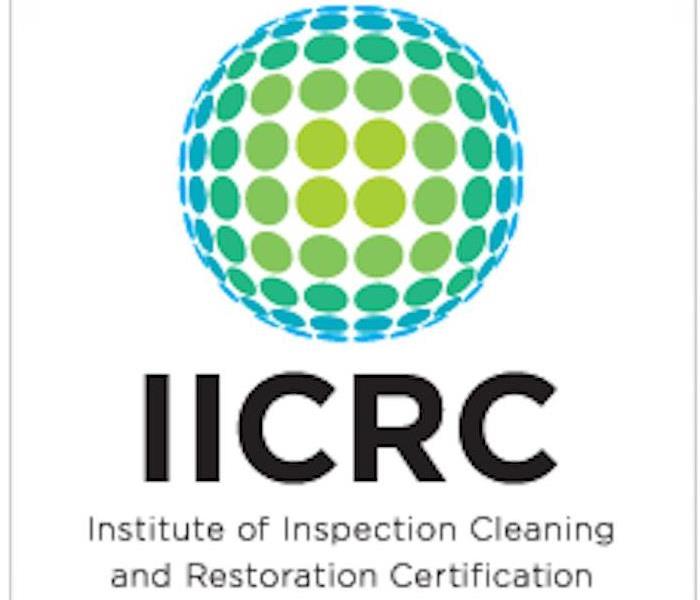 SERVPRO Fernandina Beach/Yulee/North Jax is IICRC-certified. You can count on us to handle water damage issues fast and well!
SERVPRO Fernandina Beach/Yulee/North Jax is IICRC-certified. You can count on us to handle water damage issues fast and well!
The following tips are from the Institute of Inspection Cleaning and Restoration Certification (IICRC) web site.
When a storm leaves a home flooded, or a burst pipe causes serious issues in a home, getting water damage restoration services from a respected company should be considered a top priority. Unfortunately, this industry is not regulated, and there are people out there who pose as professionals or overstate their qualifications. Therefore, homeowners should be mindful of who they hire, as an untrained technician may do more harm than good or delay repairs, resulting in a higher degree of destruction. Before selecting a company to handle the job, keep in mind these points:
- Only choose certified professionals to perform water damage restoration services. Even though the industry is not regulated, technicians who have received certification have made the effort to get the best training possible, proving that they take their job seriously. Certification through the Institute of Inspection, Cleaning and Restoration Certification (IICRC) is a sign that a professional has received the most up to date training and is knowledgeable in the latest techniques and technologies employed during repairs. The IICRC operates a Certified Firm registrant-only database on its site, making it easy to find a local, certified professional without trouble.
- Do not select a technician based only on the price or an insurance company’s recommendation. When possible, speak to neighbors or friends who have had to hire a technician recently and try to get a recommendation from them. Insurance companies often select a restoration company based on price, and unusually low pricing suggests the company does not use modern drying or repair methods.
- Choose a company that offers a range of water damage restoration services. The easiest way to determine the expertise of a firm is to see if they provide a full range of options for homeowners. Mold remediation, for example, is often needed given how quickly mold can set in. This is a standard field of knowledge that advanced technicians should possess. If a company doesn’t offer mold remediation, it may not be prepared for all job settings.
- A company that is available 24/7 is a good sign. Stay away from any firms that are reluctant to start right away. In many cases modern equipment can enable near-complete drying in as little as 36 hours, although many situations require longer. Also, a homeowner should not have to wait before repairs begin. Every minute counts when there is standing water present, and reputable professionals understand this. If a technician insists on waiting to begin the remediation portion of the loss, they probably cannot be trusted to see the job through in a reasonable timeframe.
Using these guidelines, you should be able to find a technician that can be trusted and is equipped to do the job the right way. A storm or other disaster is hard enough to deal with, and a remediation firm should do everything in its power to make this difficult process easier.
SERVPRO Fernandina Beach/Yulee/North Jax is IICRC-certified. Call us at 904-729-2401 if you have water damage!
SERVPRO Has The Right Equipment for Handling Water Issues in Nassau County
7/11/2017 (Permalink)
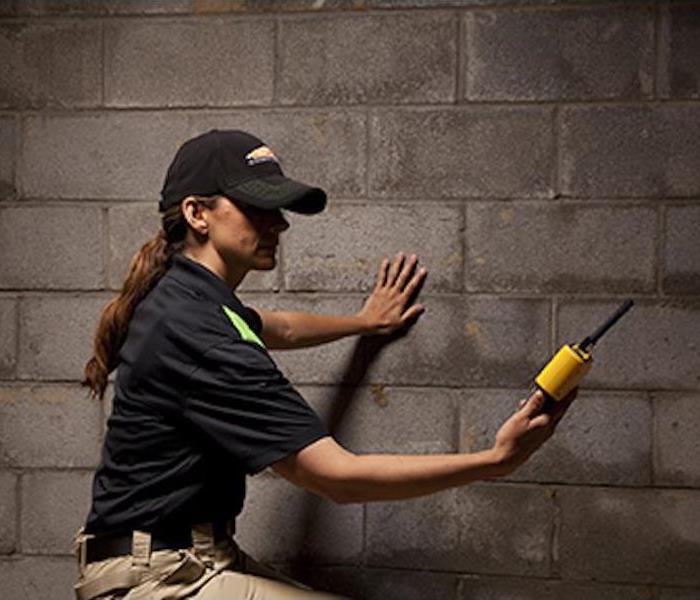 The key to avoiding costly problems in the future is to handle every water damage event as a threat to your Nassau County/North Jax property.
The key to avoiding costly problems in the future is to handle every water damage event as a threat to your Nassau County/North Jax property.
Even small water damages have the potential to cause serious structural and indoor air quality issues over time. The key to avoiding costly problems in the future is to handle every water damage event as a threat to your property. SERVPRO Fernandina Beach/Yulee/North Jacksonville has the equipment, training and experience to find and dry unseen water before secondary damages occur. The proper equipment makes a measurable difference in reducing the damage expense during a fire or water loss.
When time matters, technology and equipment must be counted on to perform Locally owned and operated, SERVPRO Fernandina Beach/Yulee/North Jacksonville will answer your call with rapid action and provide a full arsenal of drying equipment. Here are a few of the tools we use:
-Moisture Sensors are used to detect moisture in carpets, baseboards and walls.
Moisture Meters (pictured) are used to determine the actual moisture content of various materials. The moisture tester provides accurate readings, allowing SERVPRO to monitor the drying process.
-Thermohygrometers measure temperature and relative humidity. When armed with this information, SERVPRO can calculate and create an environment most conducive to drying. When facing a contaminated water loss, it is not only important to dry the structure, but the structure must also be disinfected and often deodorized.
-Ultra Low-Volume (ULV) Foggers will atomize liquid deodorizing agents, producing a fine mist that can easily penetrate the site where odor-causing residues may accumulate. This device can also be used to inject fungicides and disinfectants into wall cavities and other hard-to-reach areas.
-Thermal Foggers dispense solvent-based products by creating a dense fog. The fog consists of tiny particles of deodorant solution that attach to and neutralize odor-causing particles.
The bottom line? SERVPRO Fernandina Beach/Yulee/North Jacksonville has the training and equipment to help make it “Like it never even happened.” Call us at 904.729.2401 if you experience water damage.
Water Damage and IICRC Certification of Your Restoration Firm
5/16/2017 (Permalink)
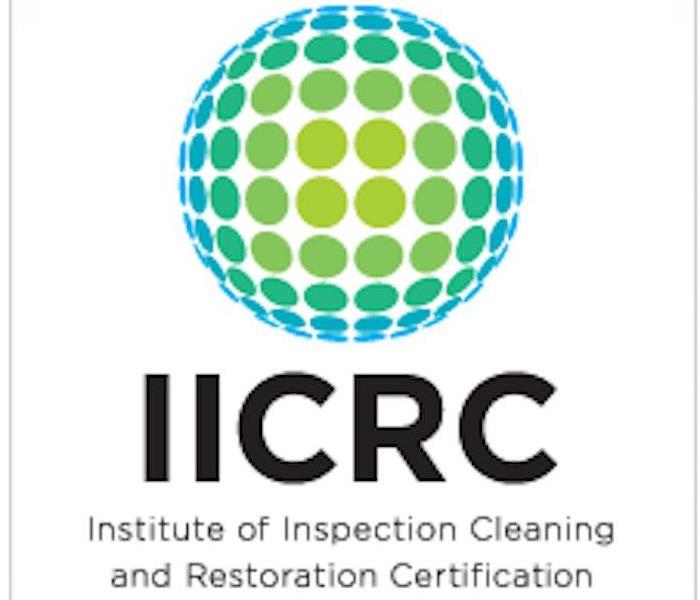 SERVPRO of Fernandina Beach/Yulee/North Jacksonville is an IICRC-certified restoration company.
SERVPRO of Fernandina Beach/Yulee/North Jacksonville is an IICRC-certified restoration company.
Water damage can be deceptive. Water penetrates into structural cavities creating trapped pockets of saturation. The detection of water in these areas can often only be discovered with sophisticated moisture detection meters. Undetected moisture will continue to cause damage. This damage, at a minimum, will cause odors. Greater damage will surface when materials delaminate, shrink, split and further deteriorate to where costly repairs are required.
More than just removing excess water, restorers certified by the Institute of Inspection, Cleaning and Restoration Certification (IICRC) have the knowledge and equipment to further dry a home or facility (including substructure materials) completely back to preloss conditions. Through timely response and the careful monitoring of water damage, mold and other health issues can be prevented. If water damage has been present too long, mold will occur.
All IICRC-certified professionals have the training and experience to identify moisture sources, evaluate mold growth (visible or suspected), contain damage, remove contamination and dry materials to ensure that mold will not return.
More About the Importance of IICRC Certification
The Institute of Inspection, Cleaning and Restoration Certification (IICRC) is a certification and standard-setting nonprofit organization for the inspection, cleaning and restoration industries.
When you see a IICRC logo, you can be confident that an IICRC-certified experienced, qualified professional is caring for your valuable property. IICRC Certified Firms employ technicians who, after study, field experience and passing comprehensive exams, have received IICRC certifications in specific cleaning, restoration and inspection categories such as upholstery, wood flooring, stone and tile flooring, carpet cleaning, odor removal, mold remediation, water damage, fire damage restoration and more.
SERVPRO of Fernandina Beach/Yulee/North Jacksonville is an IICRC-certified restoration company. Call us today at 904-729-2401 if you have water damage.
A Small Leak Can Turn Into a Big Problem
5/3/2017 (Permalink)
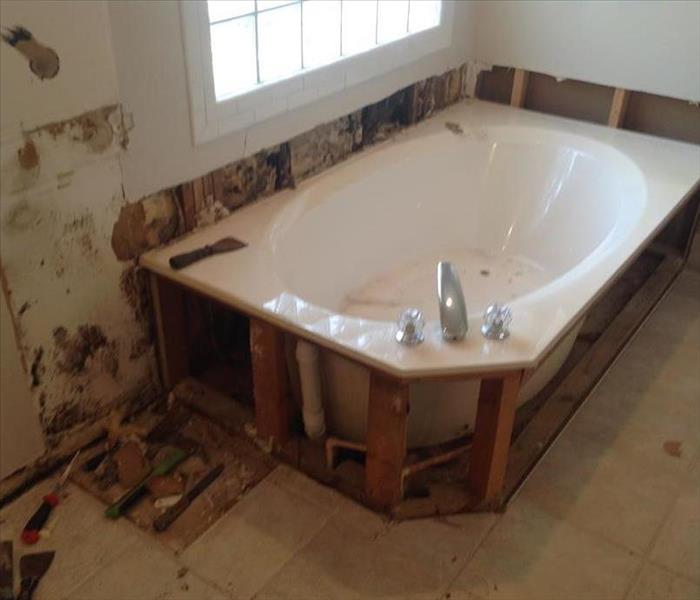 A small leak in the glass block window above this garden tub turned into a significant restoration product at this Amelia Island home.
A small leak in the glass block window above this garden tub turned into a significant restoration product at this Amelia Island home.
With any leak, it’s the water that you don’t see that causes the most damage. Unseen water can soak through walls, seep through carpet, and pool on subfloors, causing major problems over time.
Periodic inspections can protect your home investment: the most important step you can take is to identify any humidity, moisture, or water damage problems before they create bigger problems such as mold or structural damage. Here are a few tips to help you identify potential issues.
- Periodically inspect your home inside and out.
- Look for any water or moisture. Pay special attention around pipes, in basements, and in crawl spaces. If you see a problem, call SERVPRO to identify the extent of damage. Sometimes moisture in ceilings or wall cavities cannot be seen. This provides perfect conditions for mold growth. SERVPRO can identify this moisture and remove it, usually without expensive repairs.
- Your nose knows! Musty and moldy odors may be an indicator of growing molds. Your sense of smell may alert you to problems you cannot see.
- Control humidity in bathrooms, showers, and wherever water is used repeatedly. Exhaust fans, proper caulking, and regular cleaning with a bleach-based cleaning product will help keep problems away.
- Ventilation matters. Proper ventilation in attics, crawl spaces, basements, and other dark spaces can help stop moisture problems. Be sure these areas are well ventilated.
- HVAC systems and air conditioners. Having your HVAC and air conditioners inspected regularly can identify moisture problems or drain clogs.
Don’t procrastinate if you find a problem. Get professional help from SERVPRO of Fernandina Beach/Yulee/North Jacksonville to make sure the problem is solved. The best defense—and the best way to keep down costs—is periodic inspections and quick action, so call us at 904.729.2401.
SERVPRO's Vast Experience Does the Heavy Lifting to Keep Your Business or Factory Operational Following Water Damage
3/1/2017 (Permalink)
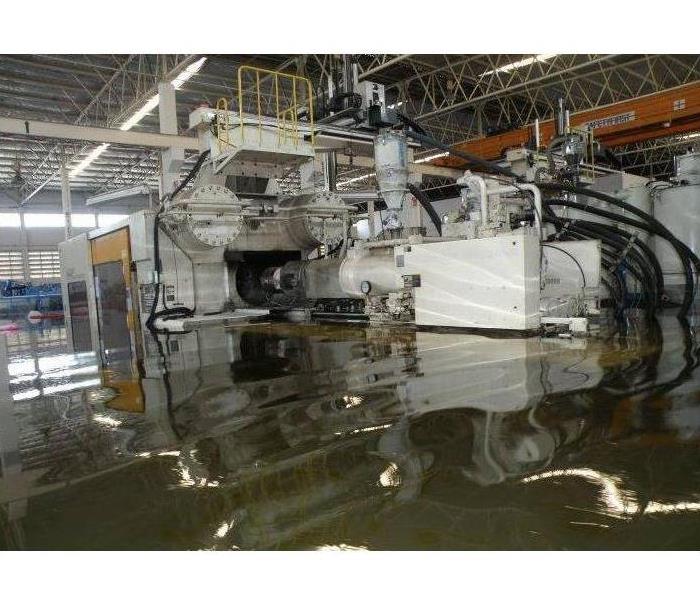 If your factory looks like this, you're going to need help from the professional!
If your factory looks like this, you're going to need help from the professional!
Industrial settings such as factories and assembly plants require consistent environmental conditions. Standing water, in any area, from any source, can immediately halt production and affect not only worker safety but also company profits, for months to come. SERVPRO has the skilled professionals who can work as a team to reduce downtime, working around your employees, if needed, to return your operations to full speed again.
Fernandina Beach and North Jacksonville area business owners will always have emergency commercial water removal services available for whenever situations with invasive, problematic water issues threaten to halt normal business operations. SERVPRO is known nationwide as a trusted name in emergency situations of any type or magnitude. Our water removal professionals that care about your employees' health, your business, and the general public can make it “Like it never even happened,” and quickly. We know time is money. Our goal is to help you stay open, operational, and in business.
Starting with the appropriate-sized extraction equipment for the situation, we quickly remove any visible water from the site. When this stage is complete, our experts will start the process of returning your factory to an adequately dry state again. Using commercial grade air movers will decrease the overall drying time by substantially increasing the rate of evaporation. For Large Loss emergencies, we can utilize large refrigerated dehumidifiers that can each draw up to 100 lbs of moisture from the air daily. Concrete floors, after returning to a dry enough state, can be treated under larger pieces of manufacturing equipment with anti-fungal sealants that are quick drying. This application protects these areas from future mold growth.
Depending on the type of water, and its source, we may not be able to save all of a business's inventory. Our efforts can largely prevent metal mesh floors and staircases from peeling and corroding, equipment cases from rusting, the wiring of components in tools and machinery from developing shorts, and other, common effects of water damage to industrial equipment and structures. Hand-cleaning of the details in your machinery, molds, and lines, including tubing, basins, and other affected areas will ensure that your finished goods are not affected in the future.
For any size water emergency involving any category of water, contact SERVPRO of Fernandina Beach/Yulee to begin the restoration process and get back in business. We are available 24/7 to assist in any emergency situation your business or factory may experience.
Water Damage & Who to Call
2/9/2017 (Permalink)
 Water Damage Should Not Be In Your Fernandina Beach or North Jacksonville Home
Water Damage Should Not Be In Your Fernandina Beach or North Jacksonville Home
As many water damage restoration experts know, there are numerous situations that can expose your home in Lenoir to the effects of water damage. Irrespective of which situation arises, a weather event or a mechanical breakdown, obtaining professional, expert, water damage repair services from a top company such as SERVPRO will be important. Learn more about areas of your home that can be affected by unwanted water intrusion. The restoration process can only start after the water has been removed.
Other Causes and Effects Of Water Damage
Water damage can result from humidity and leaky roofs. Water that enters your property from leaky roofs indicates that quick repairs to prevent further issues are necessary. Excessive humidity can result in your window frames, ceilings, flooring, floor joists, furniture, and walls discoloring and warping. In a crawl space foundation, installation of permanent dehumidifiers and plastic poly for establishing a vapor barrier may be needed. Minimizing damage caused by water will also lessen the cost to restore. Additionally, water damage can become an ideal location for mold spores to grow and develop into a mold infestation. Unfortunately, some molds are toxic and can impair the health of your family by causing neurological and respiratory problems. For this reason, a company with the knowledge, equipment and experience, such as SERVPRO, should execute mold remediation.
Appliances
Broken or leaking appliances can generate unwanted water damage. An example would be dishwashers, toilets, or washing machines that leak or overflow. The waste-filled, chemical-laden water, which may be either gray or black water, can give rise to a toxic environment. In this case water removal is the number one priority. Additionally, a refrigerator containing a water filtration system and icemaker may develop hose leaks from the water supply line. If these leaks remain unnoticed for extended periods of time, they can give rise to mold proliferation and damage to the walls, floors, and the foundation.
A Recognized Water Damage Solution
If you find that your property in the Fernandina Beach or North Jacksonville areas have restoration needs, the most effective solution is to hire a water damage restoration company like SERVPRO to begin the cleanup, repair, and restoration process. We offer 24-hour services, excellent customer service, and expedient remediation work that return your home to a safe, sanitary condition.
Locally Owned and Operated
We live and work in North Florida too; we might even be neighbors. As a locally owned and operated business, SERVPRO of Fernandina Beach is close by and ready to respond to your water and flood damage emergency. As leaders in the water damage industry, we have advanced training and expertise, not to mention a tremendous amount of hands-on experience.
Water Damage Restoration Requires Experience
9/28/2016 (Permalink)
 Flood Damage
Flood Damage
Emergency Water Damage Repair
Water in your home; whether from a plumbing leak, a malfunctioning washer, a backed-up sewer, a flood or another natural disaster -- causes more damage the longer it's in contact with the structure and materials, so a water-damage emergency requires immediate action. Call a professional such as SERVPRO in to assess damage. Water removal, restoration services and mold cleanup generally require licensed professionals with the correct equipment for the job.
Time Is of the Essence
The sooner mitigation can begin the better your chance of preventing structural damage and mold growth. The Federal Emergency Management Agency's guidelines for water damage to schools and commercial buildings calls for discarding or fully drying water-damaged materials within 48 hours to reduce the risk of mold. Mold cleanup requires protective equipment to reduce its hazard to health. At minimum levels, respirators, gloves and goggles are standard attire, according to FEMA.
Water Damage Mitigation
Water emergency contractors should have the know-how, experience and equipment to expedite water damage mitigation. SERVPRO specializes in water damage and offers services including testing to detect moisture in hidden areas. Surface cleanup isn't enough in cases where moisture has seeped into walls, supports and subfloors. Unseen moisture pocket can cause mold, rot and other damage. An EPA lead-safe certification is required for firms that repair homes built before 1978 that contain lead paint.
Restoration and Repair Process
The restoration process involves pumping out the water, removing materials and furnishings that can't be restored, and drying the home's interior, furnishings and systems, such as ductwork, air conditioning and furnaces, if necessary. Extraction vacuums pull water out of upholstered furnishings and carpets, saving the cost of replacing them. Structure drying, including crawlspaces and basements, ensures against moisture damage.
Call SERVPRO
If you experience a water damage or flood situation contact the professionals at SERVPRO of Fernandina Beach/Yulee immediately. They can help assess the damages and have the proper knowledge, education and equipment to make it "like it never even happened".
Residential Water Damage Restoration
7/25/2016 (Permalink)
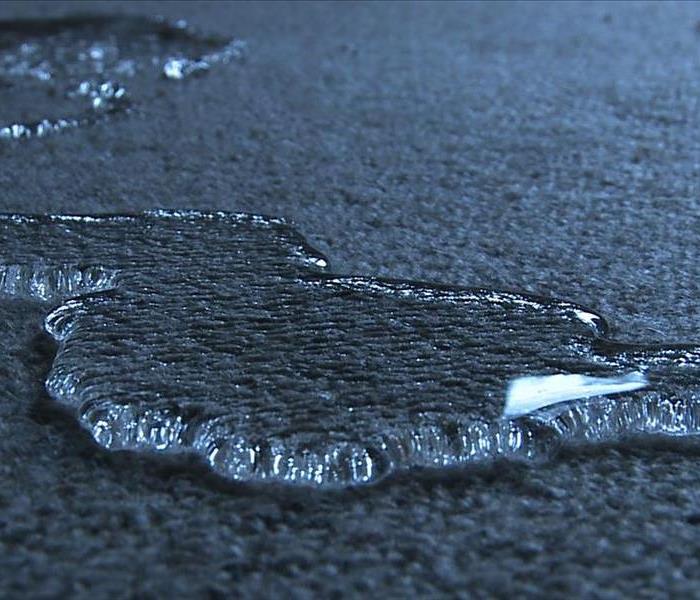 Act Quickly When Water Damage Strikes Your Home by Calling SERVPRO of Fernandina Beach/Yulee
Act Quickly When Water Damage Strikes Your Home by Calling SERVPRO of Fernandina Beach/Yulee
Resisdential Water Damage Restoration Service:
From estimation to completion, our experienced team is ready to handle your home’s water damage cleanup and restoration needs. With our help you can rest assured that your assets will be protected and damage kept minimal.
Our trained technicians will use specialized equipment to find out just how severe your water damage problem actually is. Once they’ve evaluated the damage, they’ll get rid of any standing water then begin the drying process.
Steps to take when Water Damage Strikes:
- Act Quickly: The severity of damage escalates the longer water sits and building components and contents stay wet, so time is of the essence in the aftermath of a flood. In fact, mold will grow within 48-72 hours, so aim to start removing water and drying the environment within 48 hours.
- Ventilate affected areas to prevent mold growth: Mold spores love moisture and organic materials such as paper or particleboard. In order to mitigate or slow damage, open windows if weather permits and place fans inside of them to keep air moving and maintain moderate temperatures. Work toward the fan as you clean to minimize cross contamination.
- Assess damage to items and materials: Assess the type of water absorbed by items, such as rainwater, water from broken pipes, contaminated river water or bacteria-filled sewage. There are ways to salvage specialty items but the decision on whether to save or trash an item will vary depending on the dollar and sentimental value to the owner. It may not be worthwhile to salvage drywall, carpets and pads, mattresses, pillows, box springs and particleboard. On the other hand, it might be worthwhile to restore costly Persian rugs, leather couches and antiques or heirlooms. Wet clothing and many household fabrics may be salvageable through machine washing, and a 10-minute soak in detergent and hot water, to remove contamination and stains. The IICRC strongly recommends that in water damages where there are contaminants present (e.g., bacteria, sewage, mold) or where small children or immune-compromised individuals are present that an inspection be conducted by an appropriately trained restorer and remediator.
- Expose pockets of saturation: Hidden and concealed pockets of saturation need to be opened for cleaning and drying. Layers between building materials hold water that must be discovered and removed or dried. On walls, find the water line and inspect at least a foot beyond it to make sure all damage, wet materials and mold are discovered. Remove and discard the damaged drywall and wet wall insulation. Wet carpets can usually be dried by professionals with the right equipment, but carpet padding, which is like a big sponge, should be discarded. Wood base trim and hardwood can also be saved with the right equipment if they can be accessed and completely dried on both sides. Remember to investigate concealed cavities such as behind walls, in mechanical spaces, under cabinets and furniture, and in crawl spaces.
- Confirm drying before reconstruction: In order to prevent dry rot and structural damage, it’s important not to reconstruct or cover wood and other wet materials until the moisture content has been adequately reduced. A water restoration professional can confirm proper drying before reconstruction. Call SERVPRO of Fernandina Beach/Yulee to ensure proper drying has taken place.
Quick Tips for Preventing Water Damage
4/18/2016 (Permalink)
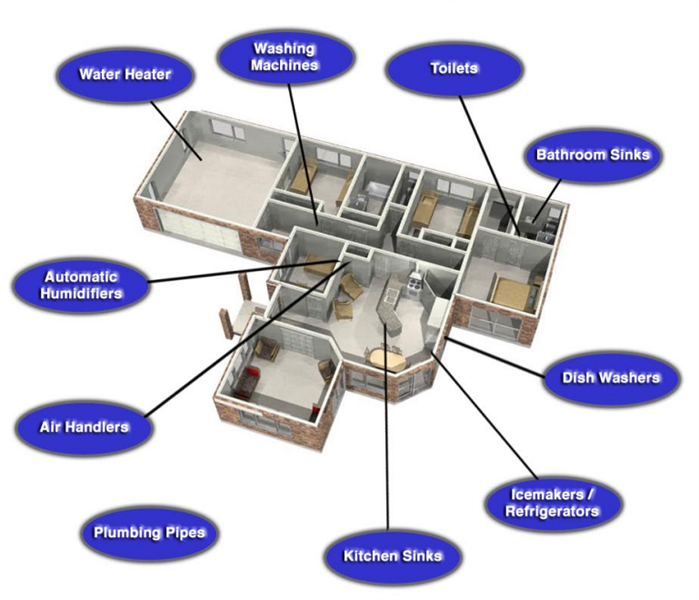 Common Causes of Water Damage
Common Causes of Water Damage
Quick Tips for Preventing Water Damage from Common Sources in Your Fernandina Beach, Yulee or Jacksonville Home:
Knowing the water damage warning signs in and around your home can help you avoid big repair bills as well as more time and trouble later. View the tips below for preventing water damage and what to do if and when it occurs.
Toilets
- After flushing, remain in or near the bathroom until the fill valve has finished refilling the bowl.
- If the bowl or tank begins to overflow, turn off the water at the supply valve.
- Inspect the flushing mechanism inside the toilet every six months.
- The fill valve should shut off when the float reaches the proper water level.
- Operate the shut-off valve to make sure the water supply will turn off properly. Replace if needed.
Washing Machines
- Turn supply valves off when not in use for extended periods of time.
- Do not operate the washing machine while the home is unoccupied.
- Inspect the water supply lines every six months.
- Check the hoses for cracks, kinks blisters, which are most commonly found near the hose connection.
- Washing machine manufacturers recommenmd replacing washing maching hoses every 5 years
- Consider using reinforced braided stainless steel hoses
Water Heaters
- Have a professional inspection of the anode rod at least once every two years and annually once the warrenty has expired. The rod may eventually corrode and leave the tank vulnerable to damage.
- Remove sediment by flushing the tank every six months. Sediment can build up faster in areas with hard water.
Plumbuing Supply & Drain Systems
*Homes 30 years old are three times as likely to have a plumbing supply or drain issue.
*Homes in the South, where plumbing is usually beneath the slab are twice as likely as their northern neighbors to have a supply issue.
- Visually inspect plumbing pipes annually, look for condensation around the pipes or an obvious leak and corrosion.
- Pay attention to your water bill. A signifigant increase could indicate a leak.
- Call a plumber at the first signs of rust-colored water, backed-up toilets or sinks and cracked or warped flooring.
- Insulate pipes in attics, basements and exposed exterior pipes to avoid freezing.
Refrigerator Icemakers
- Proper installation of the icemaker supply line hose is important to avoiding water damage.
- Ensure a tight connection between the hose and valve however, avoid over-tightening.
- If kinks are present, replace hose.
- Leave a 3 to 4 inch gap between the back of the refrigerator and the wall to prevent the hose from crimping.
- When pulling the refrigerator out for cleaning or service, avoid getting the hose caught beneath the wheels.
- Locate the water shut-off valve.
Roof Leaks
- Have a professional inspection annually.
- Request a detailed inspection report that includes the condition of the flashing, roof covering, parapets and drainage system.
- Repairs are needed if there are cracked or missing shingles or loose or missing granules; if flashing has deteriorated, paticularly around chimneys and vents; or if pooling water is present.
For More Information Visit:
Water Damage Restoration
Water Damage Tips
Water Damage Restoration Process
Storm Damage Restoration and Cleanup
Commercial Water Damage Restoration
How Can I Prepare for a Frozen Pipe Disaster
1/19/2016 (Permalink)
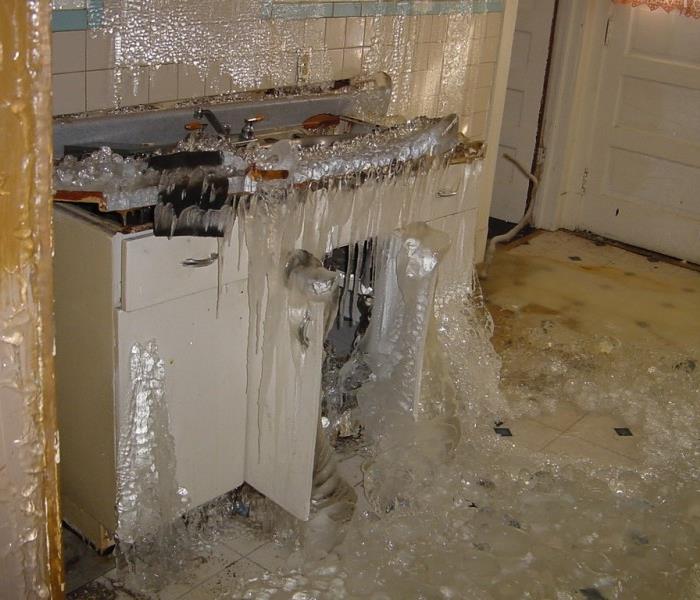 Frozen pipe burst in Jacksonville FL resulting in water damage.
Frozen pipe burst in Jacksonville FL resulting in water damage.
One of the most common things to happen to a home during a cold snap is water damage caused by frozen pipes, especially if your pipes aren't insulated. Even where extremely cold weather is normal in winter, pipes freeze and cause all kinds of problems. Pipes freeze when they're exposed to freezing weather for a few days. Problems come up when frozen pipes thaw; cold weather makes pipes brittle and frozen water has less volume than running water. The pipe breaks due to the cold, water starts running and then you've got a mess on your hands.
Pipes can freeze in 2 main areas – water coming in and water going out. You know water coming in is frozen because nothing comes out the tap. Frozen outgoing pipes from showers, toilets and sinks are a bigger problem because these will back up into the house; that's the reason it's always recommended to keep a little water dripping into the sinks and opening the cabinet doors under the sink ... running water doesn't freeze as easily as standing water.
Every winter season, the pipes in your Fernandina Beach / Jacksonville home are at risk of damage from freezing conditions. Low temperatures can cause your water pipes to freeze, and in some cases burst. The following tips can help you safeguard your home before, during and after a pipe freezes.
Prevent Your Pipe From Freezing
- Disconnect all gardening hoses and install covers on all outside faucets.
- Keep your house temperature at 68 degrees or higher, even if you're leaving the house for an extended period of time.
- Open cabinet doors below sinks to allow heat from the home to circulate.
- Identify the location of the main water valve and the valve on your water heater. (Learning the location of these valves may come in handy during an emergency.)
- Wrap pipes nearest exterior walls and in crawl spaces with pipe insulation or with heating tape. This can prevent freezing, especially for interior pipes that run along outside walls.
- Close all windows near water pipes; cover or close open-air vents. Freezing temperatures combined with wind drafts can cause pipes to freeze more frequently.
- Heat your basement and consider weather sealing your windows.
- Insulate outside walls and unheated areas of your home.
- If you plan to be away from home for an extended period of time, shut off water supply valves to your washing machine.
Monitor Freezing Pipe Conditions
- Allow a faucet to drip slightly (lukewarm water) in order to minimize freezing.
- The first sign of freezing is reduced water flow from a faucet.
- Check your faucets for water flow and pressure before you go to sleep and again when you wake up.
- Check pipes around your water meter, in unheated areas, near exterior walls and in crawl spaces.
- These tend to be vulnerable to freezing conditions.
- Identify cold air drafts coming in from a flue or chimney chase and caulk gaps that are near pipes.
If a Pipe Bursts
- Shut off water at the main valve.
- If the break is in a hot water pipe, the valve on top of the water heater should be closed.
- Call a professional restoration expert such as SERVPRO of Fernandina Beach/Yulee. Keep an emergency number nearby for quick access.
Fernandina Beach Pipe Burst - Flood Removal
1/11/2016 (Permalink)
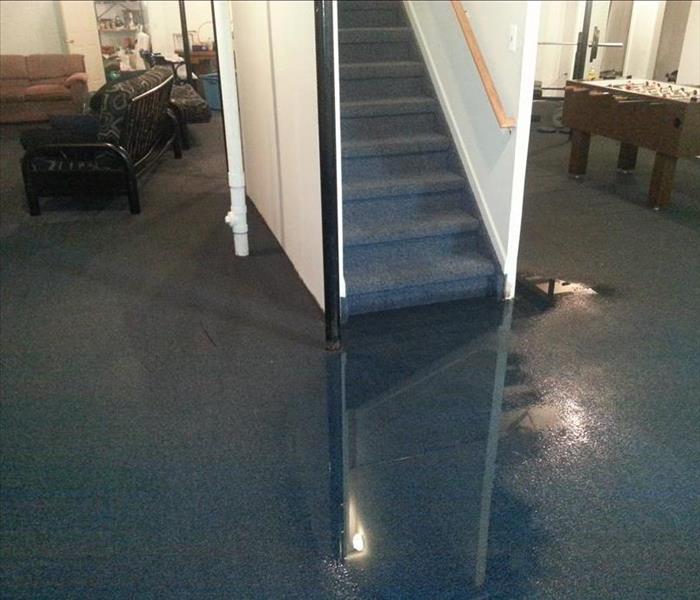 Fernandina Beach FL: House flood resulting from a burst water pipe during freezing temperatures.
Fernandina Beach FL: House flood resulting from a burst water pipe during freezing temperatures.
It's that time a year again and if you live in an area with cold winters there is a risk of plumbing pipes freezing during cold weather.
If the temperature inside a house gets below 32 degrees Fahrenheit it's likely the water supply pipes and the drain traps will freeze. When water freezes it expands 9% and if there is no room for expansion it is possibel that the pipe will develop a crack. When the ice thaws the pipe will leak, and in the supply system this leak could occur anywhere.
There is a reason why many professionals recommend leaving a trickle of water flowing through home faucets during cold weather. If water is allowed to remain still in a pipe exposed to the cold air, the water may freeze solid and the pipe may burst. If the water continues to flow, even in a trickle, it won't have the opportunity to freeze and the pipes should survive until the air temperature warms above freezing.
Preventing Frozen Pipes
Remember the three central causes of frozen pipes? Quick drops in temperature, poor insulation, and thermostats set too low. You can prepare by protecting your home during the warmer months. Here’s how:
Insulate pipes in your home's crawl spaces and attic, even if you live in a climate where freezing is uncommon. Exposed pipes are most susceptible to freezing. Remember: The more insulation you use, the better protected your pipes will be.Seal leaks that allow cold air inside near where pipes are located. Look for air leaks around electrical wiring, dryer vents, and pipes, and use caulk or insulation to keep the cold out. With severe cold, even a tiny opening can let in enough cold air to cause a pipe to freeze.Before winter hits, disconnect garden hoses and, if possible, use an indoor valve to shut off and drain water from pipes leading to outside faucets. This reduces the chance of freezing in the short span of pipe just inside the house. For more information about how to prevent frozen pipes check out this information from The American Red Cross.
Already have a burst pipe? Please visit SERVPRO's Water Restoration Process or call (904) 729-2401
Water Damage Cleanup and Extraction
10/5/2015 (Permalink)
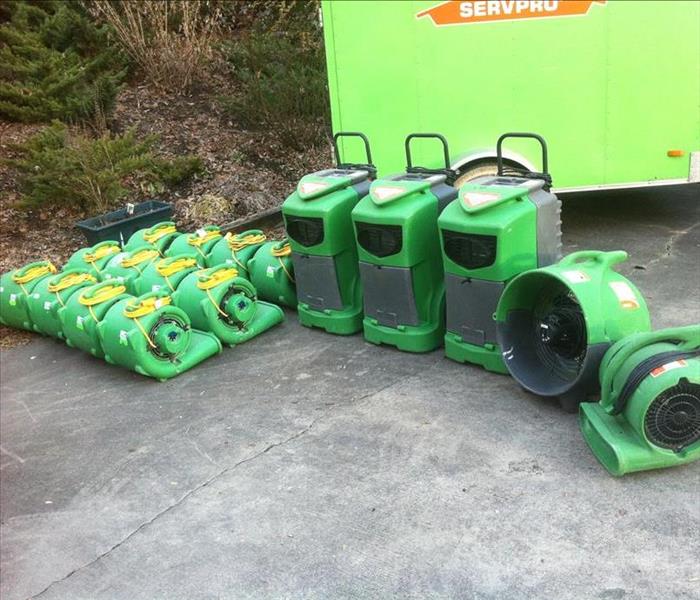 General Water Damage Equipment & Process
General Water Damage Equipment & Process
Water Damage Cleanup and Extraction - Fernandina Beach Yulee and Jacksonville
Have you experienced a water leak, flood or intrusion? Then you are probably familiar with the equipment pictured.
From the left there about a dozen air movers. These air movers are used to dry. These aid in part of the drying process. The air movers are used to dry surfaces which in turn cause the moisture contntent to go from any surface into the air. That's where the dehumidifiers come in. Next you can see that there are three LGR (low grain refrigerent) commercial dehumidifiers. This piece of equipment is vital to the process as they remove the excess moisture that the air movers put into the air. Without removing the air moisture content the air will become 100% saturated and surfaces will not continue to dry. The two air movers on the right are a sort of specialty equipment. The first air mover is the round one, called an axial air mover. It is used to dry flooring, jetting a high velocity of air directly down on the wet areas. The last air mover has a few extra plugs on the side of it allowing us to chain several air movers together when there are not sufficient outlets available.
As you can see it takes several pieces of specialized equipment to perform the drying process after sustaining water intrusion. If you have just experienced a watter issue and do not know what to do, just call the professionals at SERVPRO.
Fernandina Beach Water Damage Tips
7/31/2015 (Permalink)
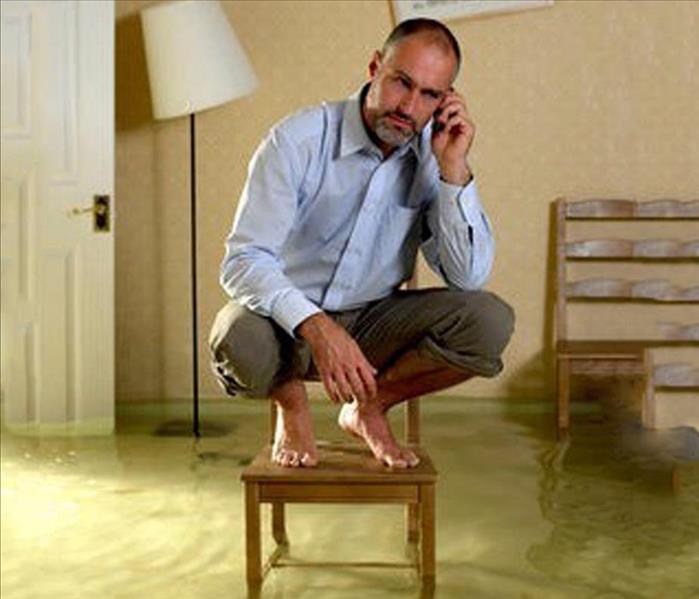 Water Damage/Intrusion Tips and Information. House Flood? Water Extraction? Call SERVPRO Professionals.
Water Damage/Intrusion Tips and Information. House Flood? Water Extraction? Call SERVPRO Professionals.
Water Damage/Intrusion Tips for Fernandina Beach and Jacksonville
Water damage can be deceptive. Water penetrates into structural cavities creating trapped pockets of saturation. The detection of water in these areas can often only be discovered with sophisticated moisture detection meters. Undetected moisture will continue to cause damage. This damage, at a minimum, will cause odors. Greater damage will surface when materials delaminate, shrink, split and further deteriorate to where costly repairs are required.
More than just removing excess water, IICRC-certified restorers have the knowledge and equipment to further dry a home or facility (including substructure materials) completely back to pre-loss conditions. Through timely response and the careful monitoring of water damage, mold and other health issues can be prevented. If water damage has been present too long, mold will occur.
All IICRC-certified professionals have the training and experience to identify moisture sources, evaluate mold growth (visible or suspected), contain damage, remove contamination and dry materials to ensure that mold will not return.
Safe Flood Damage Clean-up Tips
- Use caution when entering buildings. Make sure electrical power is off and the structure is sound before entering and inspecting a flooded building. Small animals or reptiles may also seek shelter inside a structure, so be cautious when repositioning contents or removing materials.
- Protect yourself. Wear an organic vapor respirator, available from paint or building supply stores, along with rubber gloves, eye protection and protective clothing. Ventilate affected areas by opening windows, and eventually, by placing a fan in a window. Work toward the fan as you clean to minimize cross contamination.
- Prevent mold growth. Although it takes a few days to appear, mold thrives in a moist environment with organic material (e.g., paper or particle board), and temperatures between 68°F and 86°F. Keep air moving and maintain moderate temperatures as possible.
- Consider hiring a professional such as SERVPRO. A professional water damage restoration company has trained technicians, specialized cleaners and antimicrobial agents, and extraction, drying, dehumidifying and moisture measuring equipment.
Know How to Choose a Water Damage Restoration Service
7/14/2015 (Permalink)
 When water damage strikes; "Everything under your roof. Everyone under ours"
When water damage strikes; "Everything under your roof. Everyone under ours"
Do you know how to choose a Water Damage Restoration Service in Fernandina Beach, Yulee, or Jacksonville?
1. Only choose certified professionals to perform water damage restoration services...
2. Do not select a technician based only on the price or an insurance company’s recommendation...
3. Choose a company that offers a range of water damage restoration services...
4. A company that is available 24/7 is a good sign. Stay away from any firms that are reluctant to start right away...
Using these guidelines, a homeowner should be able to find a technician that can be trusted and is equipped to do the job the right way. A storm or other disaster is hard enough to deal with, and a remediation firm should do everything in its power to make this difficult process easier.
For more information about how to select a water damage restoration service visit the IICRC - Insitute of Inspection Cleaning and Restoration Certification's website How To Choose Water Damage Restoration Services #WaterDamage #Restoration #Remediation
Jacksonville Water Damage
6/1/2015 (Permalink)
 SERVPRO of Fernandina Beach/Yulee can restore your floors and make it "Like it never even happened".
SERVPRO of Fernandina Beach/Yulee can restore your floors and make it "Like it never even happened".
Laminate Flooring
Laminate flooring is popular due to its sleek and elegant look coupled with its durability. It requires far less maintenance than carpet and other flooring materials and is considerably more affordable, especially when compared to hardwood. However, it does come with a set of disadvantages to go with its advantages. Those disadvantages include the susceptibility to water damage. Homeowners should consider the following:
Water Damage and Laminate Flooring
Water damaged laminate flooring is one of those problems home inspectors see regularly. Depending on the amount of water and the time it was allowed to stay on the floor, water damage in Jacksonville from moisture can be severe. In many cases, floors can be so badly damaged that they cannot be repaired and must be removed.
Causes of water damage to laminate flooring include:
• Roof leaks
• Leaking appliances
• Overflowing toilets
• Wet concrete floor
• Excessive humidity
What Happens When Laminate Flooring is Damaged by Water?
When the seams between planks of laminate flooring are saturated with water, they swell. In this situation, the homeowner's only option is to replace those planks; however, this is not easy as it may not be possible to find planks that match up exactly with the ones already installed. It may therefore be necessary to replace the whole floor.
How to Spot Jacksonville Water Damage to Laminate Flooring• Plank edges are puffy or swollen
• Severe cupping
• Severe crowning
• Severe cracking
Homeowners should note that even a small amount of water like a spilled drink or rain blowing in through an open window could result in major damage. Furthermore, the moisture may not be visible until after the floor has been damaged.
Why Laminate Floors are Susceptible to Moisture Damage
In many cases, laminate floors are installed without a moisture barrier. The most commonly used underlayment is simply a foam pad installed between the laminate flooring and the subfloor. Even when a moisture barrier is installed, it is still possible for moisture to get trapped in the foam pad. The trapped moisture will speed up the rate at which the laminate flooring is damaged and may also cause damage to the walls and subflooring. Water Removal Steps for Laminate Flooring
If the laminate floor has been flooded, immediate water removal steps are essential. Homeowners can use fans or dehumidifiers for water removal In most cases, the floors will return to their previous state after they have been dried out. Once the water removal efforts are complete, the damage can be assessed and a determination made about whether it will be necessary to replace the flooring.
In order to protect laminate flooring, homeowners should try to limit indoor humidity to between 30 and 50 percent while maintaining a temperature of 60 to 80 degrees Fahrenheit.SERVPRO of Jacksonville South Professionals provide fire and Jacksonville water damage restoration services. SERVPRO of Jacksonville South proudly serves Jacksonville, Macclenny, Starke, Keystone Heights, White House, St Nicholas, Town Center, Brooklyn, San Marco and surrounding areas. We are available 24 hours/7 days a week and are ready to restore damage to your home or commercial structure caused by:
Seven Water Damage Home Insurance Scenarios
10/16/2014 (Permalink)
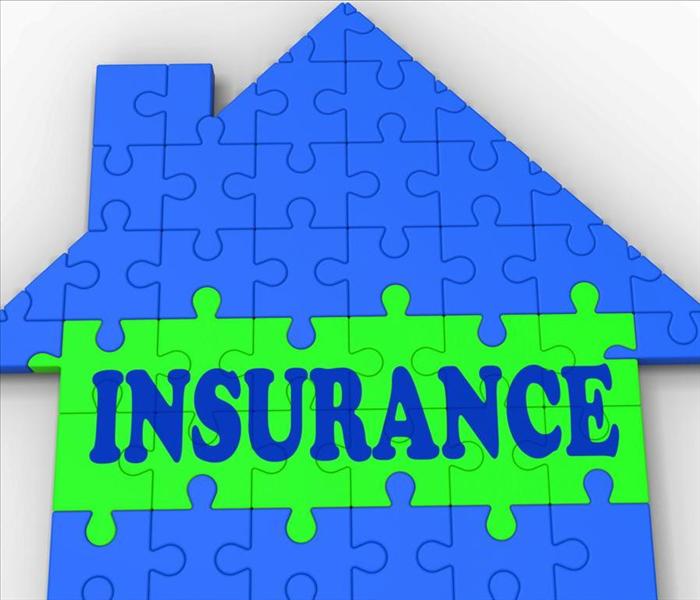 Do you know your coverage? Call your insurance provider today and make sure you are covered in the event of a water loss.
Do you know your coverage? Call your insurance provider today and make sure you are covered in the event of a water loss.
Water Damage: Seven Home Insurance Scenarios
Water damage is one of the most common reasons people make claims on their home insurance. Burst pipes, leaky appliances and flooded basements often lead people to discover the details of their home insurance policies.
Although insurance companies may pay to replace a carpet damaged by your dishwasher leak, you'll probably have to replace or repair the damaged hose at your own cost. If a sudden, unforeseen problem such as a frozen pipe leads to water damage, your home insurance covers repairs to both the broken pipe and your home and furnishings.
Here are common water-damage scenarios and their insurance consequences.
Scenario No. 1: The temperature drops to 10 below zero, causing your water pipes to freeze and burst. Your floor is now covered in 6 inches of water.
Are you covered? Yes, you're covered for water damage from burst pipes, but most policies won't cover you if you've left the house unoccupied and without heat. If that's the case, your claim could be denied because you've failed to perform the necessary upkeep that would prevent the accident.
Scenario No. 2: Water leaks from your backyard pool, ruining your manicured lawn and flooding your basement.
Are you covered? The damage to your basement and your personal property are covered, but not the damage to your lawn. According to a sample policy, "We do not cover land, including land on which the dwelling is located." However, your lawn is covered if it's damaged by certain "named perils." These include fire, explosion, riot, aircraft, vehicles not owned by you and vandalism. The amount of coverage for lawns and plants is small — usually only up to $500. Swimming-pool leaks are not a named peril. But if your leak was caused by a tree falling on the pool, it would be covered.
Scenario No. 3: Your washing machine overflows, flooding the basement.
Are you covered? Yes. But it depends on your home insurance company's view of the problem: Did you fail to maintain the washer properly or did sudden, accidental damage cause the flood? Usually, water from a broken appliance will be covered.
Scenario No. 4: A sewer backs up, flooding your basement.
Are you covered? No. Standard home insurance policies don't cover sewer backups, and many specifically exclude damage from sewer back-ups. Special endorsements are available, at added cost, for sewers and drains.
TIP: Don't shoot yourself in the foot by reporting damage to your home insurance company that's not covered by your policy. Your damage report may still go on your insurance record and look like a claim when you shop for new insurance in the future.
Scenario No. 5: Water seeps from the ground into your basement, damaging your foundation and interior.
Are you covered? No. Seepage is considered a maintenance problem, not "sudden and accidental" damage, and is excluded from home insurance coverage.
Scenario No. 6: During a heavy rainstorm, water leaks through your roof. The roof is damaged, as is furniture.
Are you covered? Somewhat. You're unlikely to be reimbursed for roof repairs because that's a house-maintenance issue. But the water damage to your home is covered. Damage to your furniture is also likely covered if you have a standard H0-3 home insurance policy, but not if you have a generic HO-1 policy (which many insurers don't even sell anymore). If your neighbor's tree falls on your roof, the damage to your roof, home and belongings is covered. Your policy also reimburses you up to a certain amount, usually around $500, for the cost of removing the tree.
Scenario No. 7: A nearby lake or river overflows its banks, causing a flash flood in your living room
Are you covered? No. Flood damage is not covered by home insurance. You must purchase flood insurance for that.
**All information above is for educational purposes only, not as actual insurance interpretation. If you have questions about your insurance coverage contact your carrier**
The 3 Categories of Water and 4 Primary Classifications of Water Damage
9/17/2014 (Permalink)
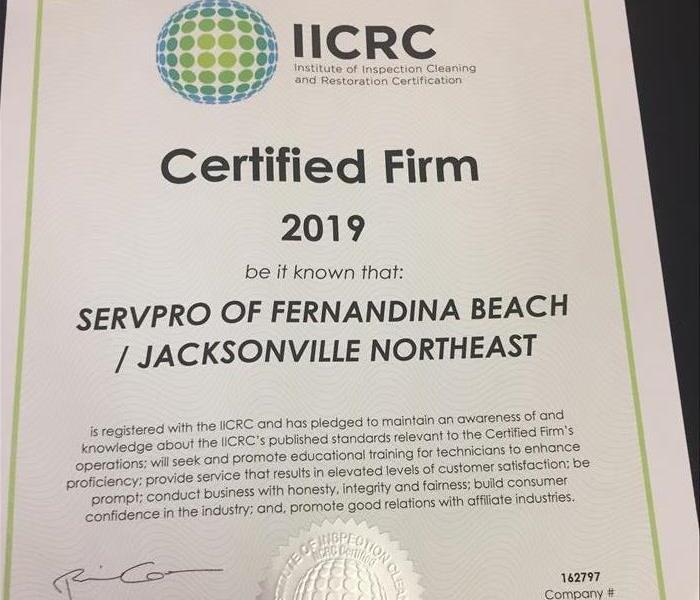 SERVPRO Fernandina Beach/Jacksonville Northeast is IICRC-certified. Call us at 904.729.2401 if you have water damage.
SERVPRO Fernandina Beach/Jacksonville Northeast is IICRC-certified. Call us at 904.729.2401 if you have water damage.
We are an IICRC Certified Firm.
There are 3 Basic Categories of Water
Category 1 originates from a sanitary source and poses no substantial risk from dermal, ingestion, or inhalation exposure. However, it may not always remain clean after it comes into contact with other surfaces or materials.
Category 2 contains significant contamination and has the potential to cause discomfort or sickness if contacted or consumed by humans. It may contain potentially unsafe levels of microorganisms or nutrients for microorganisms, as well as other organic or inorganic matter (chemical or biological).
Category 3 is grossly contaminated and may contain pathogenic, toxigenic or other harmful agents. Such water sources may carry silt, organic matter, pesticides, heavy metals, regulated materials, or toxic organic substances.
Time and temperature can also affect the quality of water, thereby changing its category. *Refer to the IICRC S500 for complete definitions.
The 4 Primary Classifications of Water Damage
Class 1 is the least amount of water, absorption and evaporation. It affects only part of a room or area, or larger areas containing materials that have absorbed minimal moisture. Little or no wet carpet and/or cushion is present.
Class 2 involves a large amount of water, absorption and evaporation. It affects at least an entire room of carpet and cushion (pad). Water has wicked up walls less than 24 inches. There is moisture remaining in structural materials and substructure soil.
Class 3 involves the greatest amount of water, absorption and evaporation. Water may have come from overhead. Ceilings, walls, insulation, carpet, cushion and subfloor in virtually all of the entire area are saturated.
Class 4 relates to specialty drying situations. Wet materials with very low permeance/porosity (eg. hardwood, plaster, brick, concrete, light-weight concrete and stone). Typically, there are deep pockets of saturation, which require very low specific humidity. These types of losses may require longer drying times and special methods.
*Refer to the IICRC S500 for complete definitions.
Do You Know Where the Main Water Shut-off Valve Is?
No one expects pipes to burst, water heaters to break, or toilets and washers to overflow. If this happens, your quick response along with the highly trained specialists from SERVPRO Fernandina Beach/Jacksonville Northeast will limit your damages and potentially save you thousands of dollars!
Take advantage of our disaster planning services by visiting The SERVPRO® Emergency READY Profile Advantage
Water Damage & Flood Damage Safety Tips
5/19/2014 (Permalink)
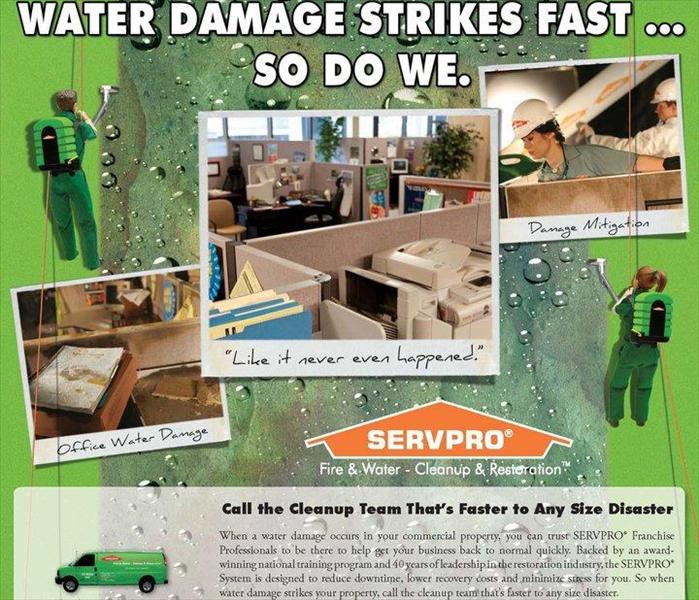 Fernandina Beach, Yulee, North Jacksonville Water & Flood Damage Safety Tips
Fernandina Beach, Yulee, North Jacksonville Water & Flood Damage Safety Tips
Safety Tips When Water Damage Occurs:
DO
- Shut off water source if possible
- Remove as much water as possible by mopping and blotting the saturated areas
- Wipe furniture to remove excess water
- Place aluminum foil between legs and wet carpet
- Prop up wet furniture cushions for even drying
- Lift drapes off flooring, loop through a coat hanger and hang on curtain rod
- Move valuable paintings, art objects and photos to a safe dry place
- Open closet doors, furniture drawers and luggage to aid in drying
- Remove wet area rugs
- Remove any wet fabrics and dry immediately
- Hang furs and leather goods to dry separately at room temperature
Do Not
- Use your household vacuum to remove excess water
- Use electrical appliances while standing on wet flooring or carpets
- Go into any room where the ceiling is sagging
- Wait to call professional help. The longer you wait the more damage will occur
Call SERVPRO® at the first sign of water damage at (904) 729-2401 to prevent any further damage and make it "Like it never even happened".
High humidity problems, high moisture, condensation, window sweat? Here are some cause and solution tips for high humidity issues
4/29/2014 (Permalink)
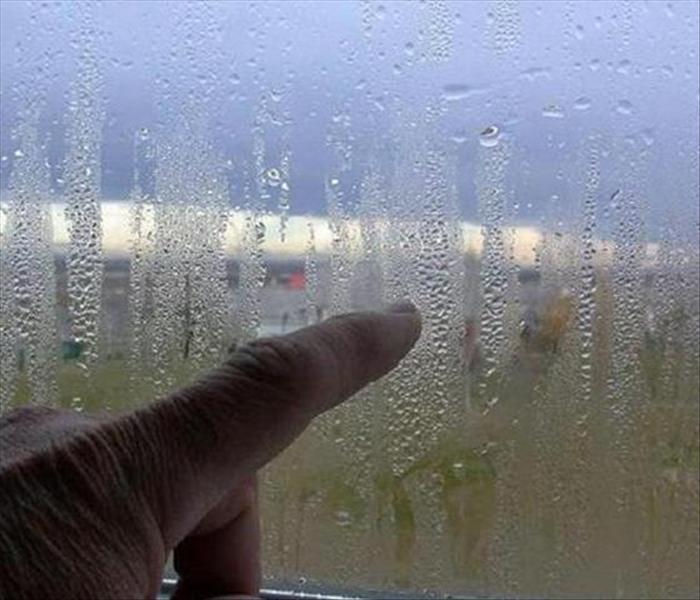 Condensation and excessive window sweat can be a sign of high humidity!
Condensation and excessive window sweat can be a sign of high humidity!
When warm, excessively moist air inside your house contacts a cold surface, such as a pane of window glass or an exterior wall, the moisture condenses on that surface in the same way it does on a cold glass of lemonade on a hot, humid summer day. In most homes, a little bit of window condensation is not necessarily abnormal at the beginning of heating season. All summer long the building materials have been absorbing moisture from humid air flowing through. When we finally start to shut our windows and doors and begin to fire up heating plants for the winter, the interior air begins to dry out (some of this is due to infiltration of drier outside air) and the trapped moisture in the building materials begins to be released. As exterior temperatures begin to drop, so do temperatures of windows and exterior walls. This generally results in moisture showing up on these cold surfaces. In most homes, this is a temporary condition. It usually lasts two weeks or so, until the interior of the house dries out. However, ongoing and severe moisture are not normal and should be dealt with. Excess moisture in a house can be quite destructive; it can cause peeling paint, mold growth, and, in severe cases, rot of wood framing members. Here are a few tips to help prevent window condensation aka “window sweat”
- Keep humidity levels as low as you can—no higher than 50%--all day long. An air conditioner or dehumidifier will help you keep the level low. Humidity levels change throughout the day as changes occur in the moisture in the air and the air temperature, so check the humidity levels more than once a day.
- If you see condensation or moisture collecting on windows, walls or pipes ACT QUICKLY to dry the wet surface and reduce the moisture/water source. Condensation can be a sign of high humidity.
- Be sure your home has enough ventilation. Use exhaust fans, which vent outside your home in the kitchen and bathroom. Make sure your clothes dryer vents outside your home.
- Fix any leaks in your home’s roof, walls, or plumbing so mold does not have moisture to grow.
- Clean up and dry out your home thoroughly and quickly (within 24–48 hours) after flooding.
- Remove or replace carpets and upholstery that have been soaked and cannot be dried promptly. Consider not using carpet in rooms or areas like bathrooms or basements that may have a lot of moisture.
By following these tips above you can avoid high humidity issues in your home. For more information about dehumidification visit SERVPRO Cleanup & Restoration Dehumidification, call us today at (904) 729-2401 or get help online
Fernandina Beach Water Extraction, Water Damage
2/12/2014 (Permalink)
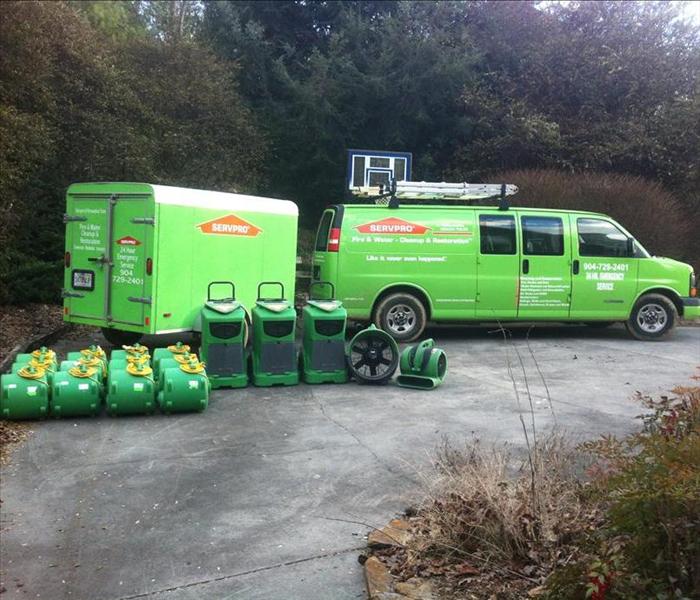 Equipment we use in Fernandina Beach, FL to help clean up water and flood damage.
Equipment we use in Fernandina Beach, FL to help clean up water and flood damage.
This is an image of all of the equipment we removed after a water damage. This water damage was from a small pipe in the wall that froze and when thawed, spared no time flooding our clients’ basement in Fernandina Beach, FL. Upon arrival, we began water extraction to remove the water. Then, we put in fans and dehumidifiers to begin the drying process. Our client was very pleased that we could begin the water extraction so quickly to prevent it from further damaging their home or belongings. For more information about our equipment visit Equipment Information and view pages 7 and 8.
2014 Fernandina Beach/Yulee Water Damage Readiness Tips
1/2/2014 (Permalink)
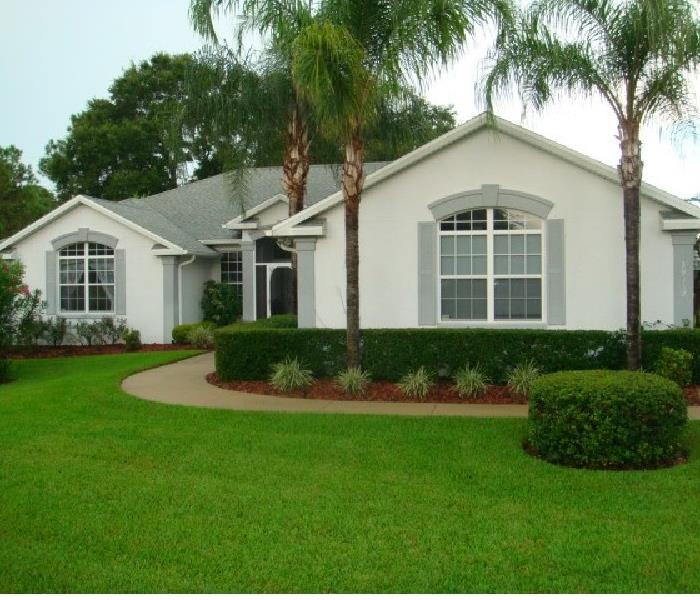 Keep your home safe this year with a few simple tips from SERVPRO, weather you are in Fernandina Beach, FL Yulee, FL or north Jacksonville, FL
Keep your home safe this year with a few simple tips from SERVPRO, weather you are in Fernandina Beach, FL Yulee, FL or north Jacksonville, FL
It's a new year and knowing water damage warning signs in and around your home can help you avoid big repair bills as well as more time and trouble later. Here are some tips to prevent water backups.
Maintain gutters and downspouts, keeping them free of debris and leaves and repairing them if they are saggingInspect your gutters' capacity - after fifteen minutes of heavy rain, if water overflows the gutters, install additional downspoutsExtend downspouts at least ten feet away from the houseAdjust landscaping and irrigation so that water flows away from the foundationDrain subsurface groundwater and storm water with a sump pump system that has battery backup and replacement warningsRun your sump pump every few months and clean it annually before the rainy seasonPrevent backflow of sanitary sewer water by installing backflow valves and standpipes at all basement drain locations, including sinks and toiletsPrepare your basement "just in case" by raising your washer, dryer, water heater, oil tank, furnace, all electrical wiring and personal items above typical water backup levelsLastly, call us at the first sign of damage; we can save you from a potential larger scale problem.These are just a few helpful tips that can help you avoid disasters that are within your control. Natural disasters are a different story. Check out our other Home Emergency Tips
Keep your home safe this year with a few simple tips from SERVPRO, weather you are in Fernandina Beach, FL Yulee, FL or north Jacksonville, FL these tips will help keep your home and your family safe.






 24/7 Emergency Service
24/7 Emergency Service






























































